

Cruise Ship Anchors – How Big Are They? (and More)
Have you ever wondered if modern cruise ships have anchors and if so, where are they stored, and how big are they?
Modern cruise ships have what’s known as a stockless or patent anchor . This type of anchor is suitable for a wide range of different sea bed types, which cruise ships need as they travel through different waters and varying ports.
They are called stockless anchors because they don’t have a horizontal stock across the top of the shank.

Do Cruise Ships Have Anchors?
Like most ships, cruise ships have anchors. Anchors are required for holding a ship in place and preventing it from drifting due to winds and currents.
Anchors come in various shapes and sizes. Cruise ships have stockless anchors. This is a design of anchor that has particularly heavy flukes which are connected to a shank. These heavy flukes can dig into the seabed.
Do Cruise Ships Have More Than One Anchor?
Most cruise ships have two anchors, one port side and one starboard side at the front of the ship , although they are not often deployed at the same time.
One anchor is sufficient to keep a ship in position, although two can have their uses in specific circumstances.
Having two anchors means there’s always a backup should one ever be required. There is a lot of machinery and chain involved in the anchoring process and if any were to become damaged or required maintenance the other anchor could be used.
How Big Is A Cruise Ship Anchor?
Cruise ship anchors can be up 15ft to 20ft in height and 10ft to 15ft wide. Anchors are generally proportional to the size of the cruise ship. The larger and heavier the cruise ship, the larger the anchor can be expected to be.
The largest oasis-class Royal Caribbean cruise ships are some of the largest in-service ships sailing today and can be expected to have the largest anchors on any cruise ships.
The new Royal Caribbean icon-class cruise ships will be larger still and so will the anchors.
How Much Does A Cruise Ship Anchor Weigh?
Cruise ship anchors are somewhat proportional to the size of the ship. The larger the ship, the larger the anchor. A typical cruise ship anchor can weigh 10 to 15 U.S tonnes (9000 to 13600 kilos).
However, the weight of the chains is far heavier and much more of a factor in holding a ship’s position when it’s anchored offshore.
It’s the weight of the chain that holds the ship’s position, while the anchor acts to hold the end of the chain, preventing it from being pulled along the seafloor.
Ship Anchor Compared To Human
Cruise ship anchors can be 2 to 3 times an average human height of 5ft 9inches.
Assuming an average human weight of 80kg, an anchor weighing 10000 to 13500 kilos would be 125 to 168 times heavier.
In the photo below, you can see a human and cruise ship anchor comparison. Two maintenance workers underneath the anchor of Norwegian Cruise Line’s ship Norwegian Jewel , which was raised for maintenance.
In our post about the bottom of a cruise ship , we highlight a video clip of an anchor being freshly painted, and you can see it is about three times the height of the man doing the painting.
How Long Are Cruise Ship Anchor Chains?
The weight of anchor chains plays an important role in holding a cruise ship in position, much more so than the weight of the anchor itself.
When an anchor digs into the seabed, there must also be a sufficient length of anchor chain also lying on the sea bed. This provides extra weight and slack to the chain, which can absorb forces from the ship’s movement.
When a ship is properly anchored, the amount of anchor chain released should be 5 to 7 times longer than the depth of the water.
If the water depth was 50 ft (15m) the anchor chain released would need to be 250ft to 300ft (75m to 105m).
The anchor chain lies horizontally from the ship to the embedded anchor. Much of it is flat on the bed of the water.
The ship will not be sitting directly above the anchor but rather drawn away from it by wind and water currents.
Each individual link on the anchor chain weighs a considerable amount in its own right. This weight of the chain causes it to sag into a curved shape from the anchor chain on the sea bed up towards the ship. This is referred to as a catenary, a flexible hanging chain.
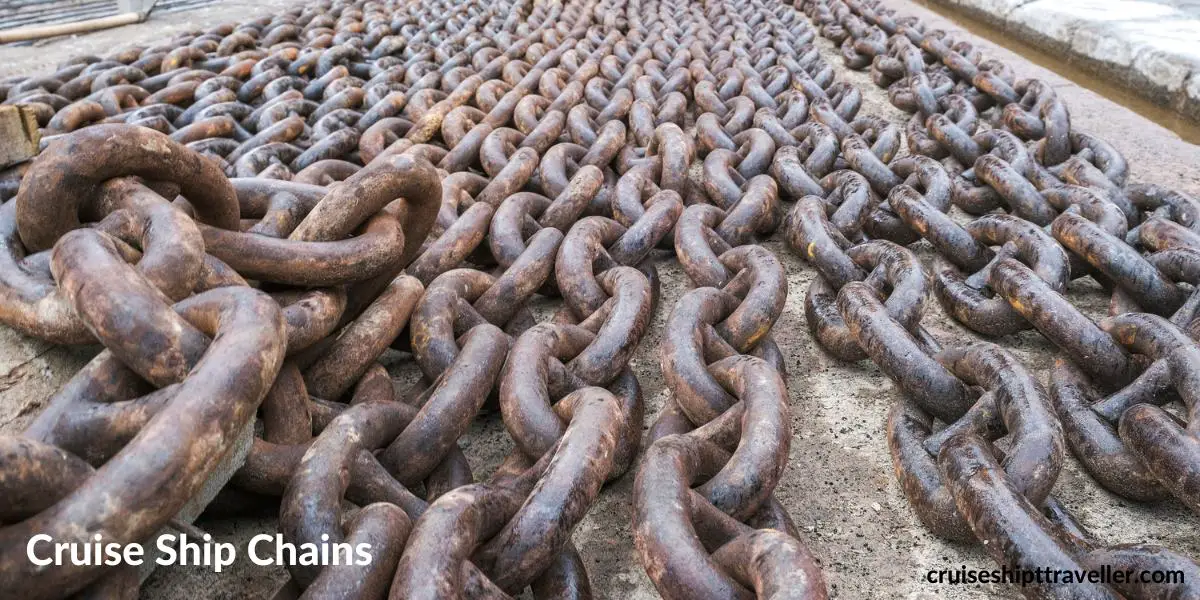
Markings on Anchor Chain
To indicate the length of the anchor chain released are markings on the actual chain, individual chain links of a different color, usually a red shackle, and white links on either side.
These markings indicate every 90ft (27.4m) of chain released.
The way it works is for every 90ft extra links, and either side of the red shackle will be painted white.
For example, a 360ft chain would be indicated with four links painted which either side of the red shackle (4 x 90ft = 360ft).
When do Cruise Ships Use Anchors?
If the draft of a cruise ship is too deep for a shallow port and waters, this prevents the cruise ship from docking. The cruise ship will have to anchor offshore in deeper waters, and passengers will have to be tendered to port.
Reasons a cruise ship might need to anchor include:
- Port waters too shallow
- Waiting to berth (park)
- Holding position during a storm
- Waiting for port channels to clear
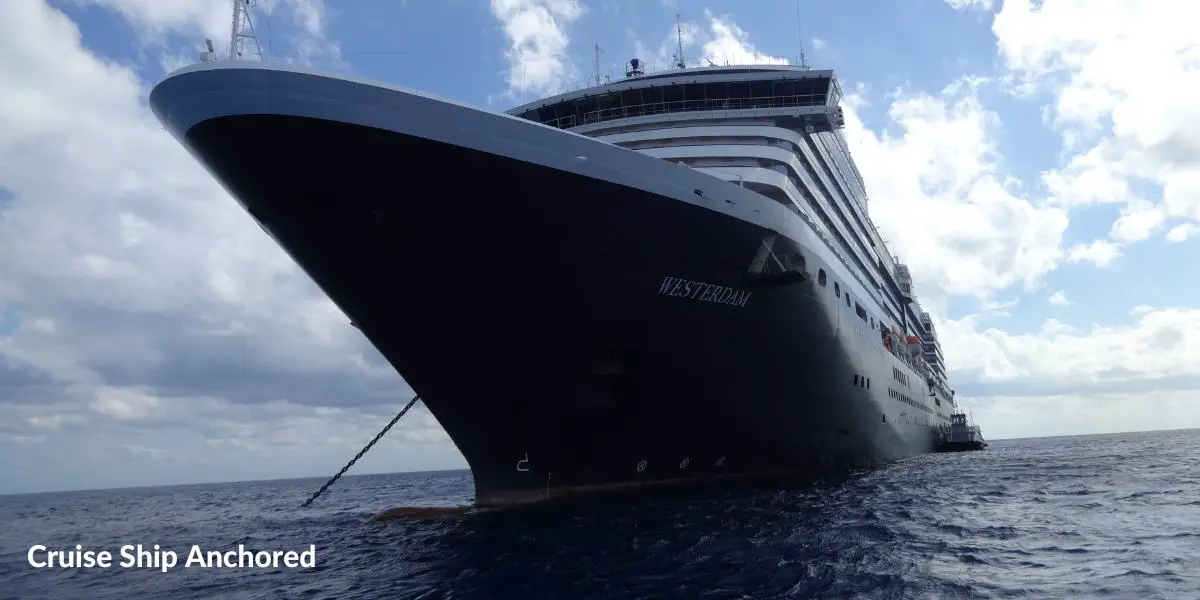
How Does A Ship Anchor Work
An anchor can be dropped in one of two ways.
- Engage in gear and walk back at desired pace or drop released for faster
- Release manual break for emergency release
The manual brake can be released in an emergency to release the anchor as quickly as possible.
When the anchor hits the seabed, the bridge crew will use the bow thrusters to maneuver the ship, causing the flukes of the anchor to dig in to the seabed.
With large cruise ships, it’s not so much the size and weight of the anchor that holds it in place, it’s more the total weight of the chain .
The anchor holds the end of the chain in position while much of the chain lays along the seabed before rising up to the cruise ship when forces such as wind are applied.
If there is no pull on the chain, and it’s slack, then there is no weight on the chain.
As the cruise ship moves, the chain’s slack changes when it’s slowly stretched and becomes taunter.
Depending on the stage of slack it will be referred to as:
- Lightweight
- Medium weight
- Heavyweight
At medium weight, the ship will have moved away from the anchor, and some of the chain will have been lifted from the seabed.
When the chain is deemed heavyweight, there is no slack in the chain. At this point, the anchor is acting to keep one end of the chain in position.
As a ship moves away from the anchor, the anchor chain gently extends as some chain is lifted from the seabed, absorbing some of the force that’s moving the ship. The force is not directly transferred to the anchor.
Whenever the forces subside, the chain slackens, and some of it falls back on the seabed as the ship eases back toward the anchor.
This is why anchor chains are so long. The longer the chain, the more force it can take before breaking the anchor free of the seabed.
If ships had short anchor chains that were just long enough for the anchor to bed down with a much shorter and tight chain, as soon as any excessive force is applied to moving the ship, it would be applied directly to the anchor, possibly causing it to break free.
Cruise Ship Dropping Anchor
To understand how a cruise ship works, we found this video which shows the Princess Cruise vessel, the Coral-class Island Princess cruise ship dropping an anchor .
To give you an idea of scale Island Princess is a mid-sized cruise ship, 91,627 gross tonnes with a capacity for 2200+ passengers and 900 crew.
Some of the biggest cruise ships are 2 to 2.5 times bigger, and the anchor and chains would be proportionally larger too.
Island Princess Dropping Anchor
The video shows:
- 0.40 – Anchor lowered to water level
- 1.05 – Port side windlass
- 2.05 – Anchor starts dropping
- 4.03 – Brought up to a port anchor of 5 and a quarter in the water.
Do Modern Cruise Ships Need Anchors?
While cruise ships, in theory, can use the dynamic position system that utilizes a combination of computer technology and GPS and to automatically control the propellors and bow thrusters, keeping the ship in the desired position by acting against the forces of the sea and winds.
Although this would involve keeping the ship’s engine running, using lots of fuel and keeping the crew busy overseeing it all.
An anchor is a much more efficient process, including much less fuel.
More importantly, a cruise ship can always use an anchor in the event of a loss of power, which, in some situations, could be vital.
Basic Anchor Terms:
- Anchor aweigh – means to take up the anchor from the waters bed
- Bed down – anchor on the seabed
- Bosun – operates the windlass and anchor
- Brought up -when the ship’s way has stopped and is riding to her anchor. There’s an equilibrium between the weight and forces on the ship and the weight of the anchor cable.
- Forecastle raised deck front part of the ship
- Flukes – projection of anchor that digs into the seabed
- Hawse pipe -where the anchor is stored
- Heave – a strong pull
- Rode – anchor chain
- Windlass – a type of winch used especially on ships to hoist anchors
Frequently Asked Questions
What’s the largest anchor in the world.
The biggest anchor in the world belongs to the largest ship in service, Pioneering Spirit . The ship has a gross tonnage of 403,342 far greater than the next largest ships by gross tonnage .
One of the largest anchors in the world now on land is that of the Seawise Giant It is 36 tonnes and is on display at the Hong Kong Maritime Museum.
Why is Water Coming From A Ship Anchor?
When an anchor chain is lying on the seabed, it picks up all sorts of debris and mud, which must be cleaned to prevent the chains from seizing up.
The anchor chain is heaved up through the hawsepipe at the bow of the ship , while at the same clean, powerful jet sprays within the hawsepipe clean the anchor chain.
What Happens if an Anchor Gets Stuck?
If an anchor became stuck in the seabed, such as being caught on a rock, the cruise captain would try to maneuver the ship in various ways to try and break it free.
As a last resort, the anchor chains would have to be cut, leaving the anchor on the seabed. Rather than lose the anchor, a buoy could be attached to the last piece of the chain so it could be recovered later.
What Would Happen if a Cruise Ship Lost its Anchor?
There are usually two anchors on a cruise ship, one on the port side and one on the starboard side. If one was lost, the other could be used.
We have this post if you need ways to remember port and starboard side .
If all anchors were lost, the ship would have to use propulsion and bow thrusters to maintain position.
If power was also lost, the ship would be at the mercy of the forces of wind and waves, which would cause it to drift. In this instance, the captain would have to call for assistance.
Do Cruise Ship Anchors Touch The Ocean Floor?
Cruise ship anchors need to reach the floor of the seabed. More than that, they need to dig into the seabed to maintain a grip and have enough chain links to be laying on the seabed to absorb any weight-pulling forces.
Can a Cruise Ship Anchor in the Middle of the Ocean?
Cruise ships can only anchor in seas where the anchor can comfortably reach the bottom of the sea bed and still have enough chains left to lay on the seabed.
If the cruise chain is too taunt, any pressure moving the ship would put too much pressure on the anchor and possibly break it free from the seabed.
There are ocean depths that cruise ship anchors cannot reach. This is because they are primarily designed for anchoring in shallower coastal waters. Excess anchor rode is not on board because it takes up too much space and is rarely required.
If the anchor cannot reach the seabed, it is serving no purpose and is simply a weight dangling from the ship into the sea.
How Much Does A Cruise Ship Anchor Cost?
The cost of an anchor mostly depends on its size and weight.
There are also the logistics of transporting such a heavy item and the additional costs of installing the anchor.
As ship anchors are not commercially available for sale, it isn’t easy to estimate a price, but for a large cruise ship anchor on its own without a chain, it could be expected to cost a six-figure sum.
Related Posts

What is the Draft of a Cruise Ship? (and Why Does it Matter?)

How Many Doors on a Cruise Ship? (Yes, I Counted)
Leave a comment cancel reply.
Your email address will not be published. Required fields are marked *
Save my name, email, and website in this browser for the next time I comment.

Cruise Ship Anchors – Function, Size, Weight, and Uses
If you have seen a cruise ship you may be wondering if they have anchors. The majority of boats and ships do but with the vast size of cruise ships are anchors needed in the same way?
Cruise ship anchors usually can’t be seen from the shore and if you’ve been on a cruise ship it’s unlikely that you have spent too much time wondering about how the cruise ships stay in one place.
I recently saw a replica of the Titanic’s anchor which made me wonder if modern ships still have anchors.
Do Cruise Ships Have Anchors?
Modern cruise ships do have anchors. Dynamic positioning technology has reduced the need for traditional anchors but has not eliminated their use completely. Cruise ship anchors are usually between 10-20 feet in length and weigh between 10 and 20 US tons. Most modern cruise ships will have more than one anchor.
Cruise ship anchors are used to keep the cruise ship in a stationary position. This is often needed when a ship stops out to sea.
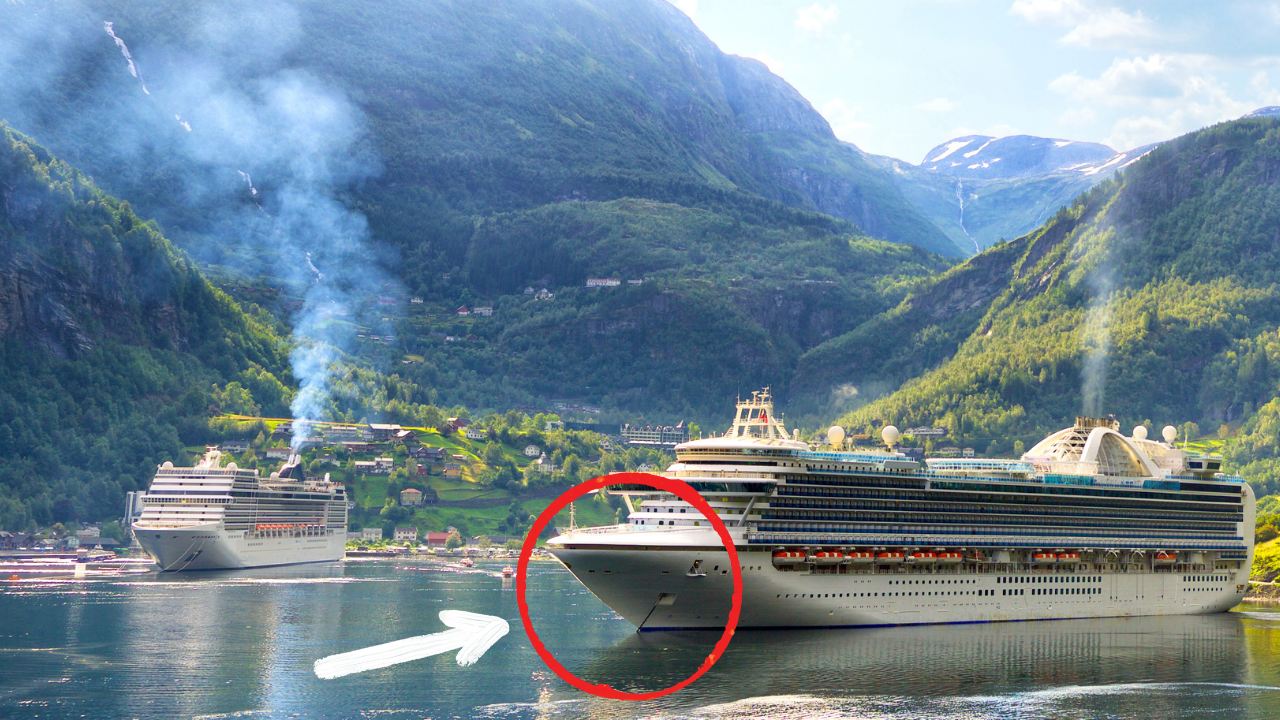
Do Cruise Ships Have Multiple Anchors?
The majority of ships have more than one anchor. It is common for ships to have two anchors, one on the port side and one on the starboard side of the ship.
There are a few reasons for this:
- In certain circumstances it makes sense to use an anchor that is on one side of the ship over the other.
- If an anchor became damaged, broke or was lost the ship needs to have another anchor that can be used as backup.
In addition to two working anchors, some ships will have a third backup anchor. This may not be the full size or weight of the main anchors.
When a ship uses both anchors at the same time and they are both anchored ahead, this is known as an open moor.
The below photo shows the Marella Discovery 2 using both anchors.
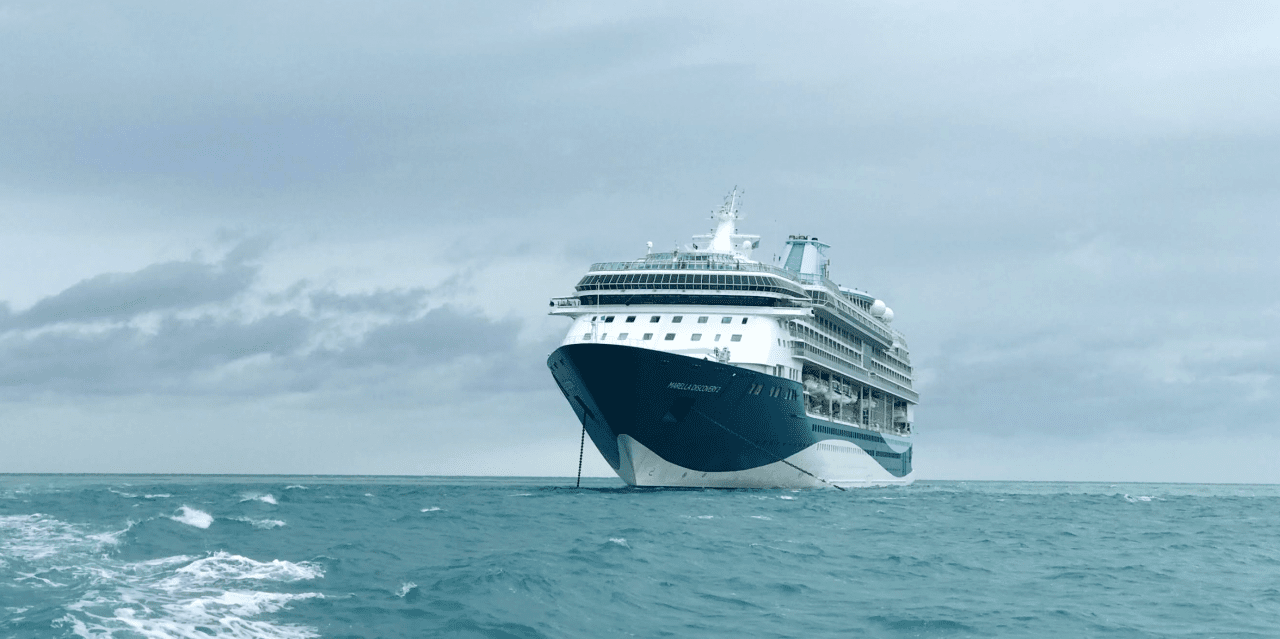
When do Cruise Ships Use Their Anchors?
Anchors are used to hold a ship in place. If a ship is unable to dock in a port due to shallow water it may be necessary for the ship to hold a position out to sea and to transport its passengers using tender boats.
Having to take a tender boat to land is a very common part of cruising. Guests are usually able to see ahead of time if the ports that they are visiting will require tendering.
I do enjoy tendering when I cruise but on occasion, it can mean long wait times. Tendering into port also increases the chance of a port being cancelled if the weather is bad. Cruise ships cannot risk tendering their passengers to land if they are unsure that they’ll be able to get them back later.
To learn how to spot tender ports and how to make the process as efficient as possible, check out this post: Cruise Ship Tendering – 5 Tips You NEED to Know .
How do Cruise Ship Anchors Work?
Cruise ship anchors dig into the seabed and provide a contact point for the ship.
When it comes to large ships, it isn’t just the anchor that holds the ship in place. The anchor is on the end of a long and heavy chain and the weight of this chain on the seabed helps to hold the ship in place. Each piece of the chain can be incredibly heavy.
The longer the anchor chain the more movement the ship can withhold. If the anchor chain was very short and a the ship slightly this may cause the anchor to break free. With a long chain the ship is able to move slightly without the anchor needing to come out of the seabed. The chain will simply become less slack.
Will Cruise Ships Always Need Anchors?
Modern technology has reduced the need for anchors but hasn’t completely eliminated it. Many modern cruise ships have ‘dynamic positioning’ meaning that they use propulsion and thrusters instead of anchors to maintain a steady position.
There are many benefits to using dynamic positioning over traditional anchoring including:
- Increased manouverability
- Quick to set up (and to stop)
- Seabed conditions and water depth don’t matter
Maintaining the position of a ship in this way may be better for the seabed as an anchor doesn’t have to be dropped but it does use more fuel and therefore produce more emissions. The initial cost to install this technology is also high.
Dynamic positioning was created in the 1960s for offshore drilling but it is a relatively new piece of cruise ship technology.
How Big are Cruise Ship Anchors?
Cruise ship anchors usually range from 10ft to 20ft in length. The Titanics anchor was 18ft 6 inches in length and the cast steelhead of the anchor was 10ft 9 inches.
In most cases, the size of the anchor directly correlates with the size of the ship.
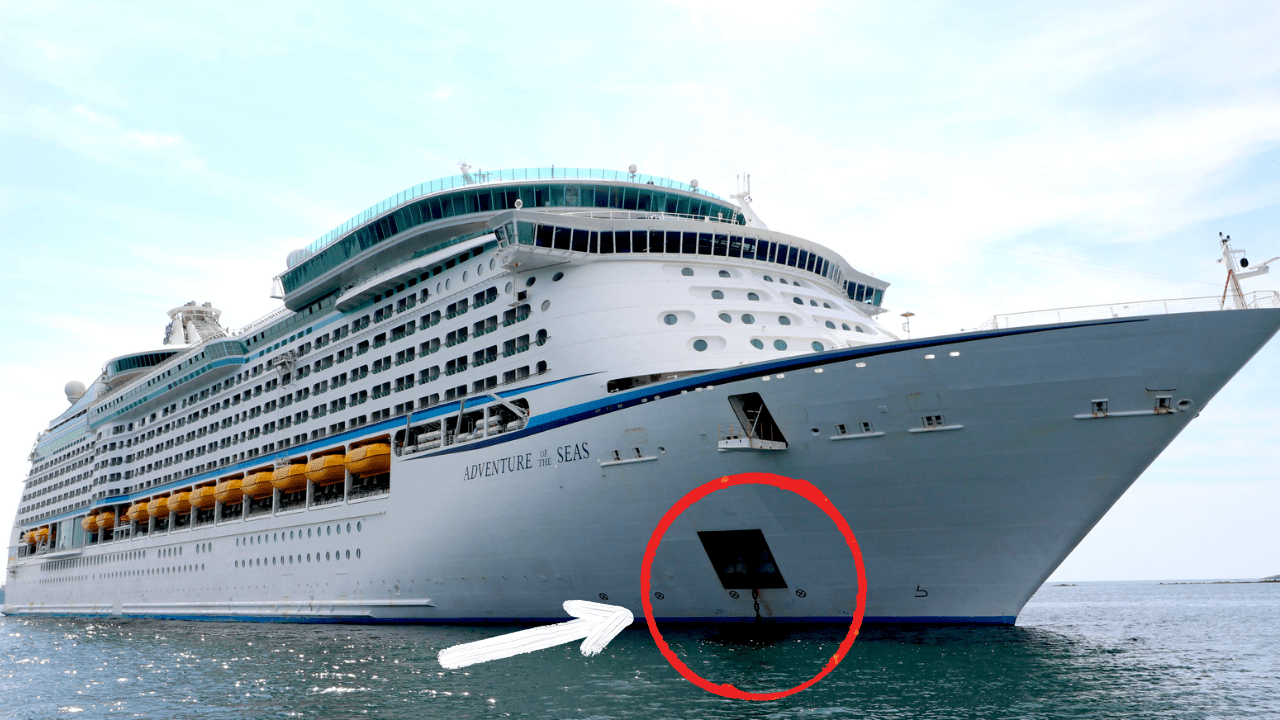
How Much do Cruise Ship Anchors Weigh?
As a general rule cruise ship anchors tend to weigh between 10 and 20 US tons. The Titanics anchor was 16 US tons and many of the large modern large ships have anchors that weigh vastly more.
The largest ship detailed by the iacs equipment number calculation would require a 46,000kg anchor. A ship with a 46 metric ton anchor would need an anchor chain of at least 770 metres.
To put that into perspective the largest elephants weigh around 5 tons, so that’s over 9 elephants!
The below table shows the correlation between anchor weight and chain length.
Note, metric tons are different from US tons.
1 metric ton is 1000 KG.
1 US ton is 907 KG.
What Would Happen if a Cruise Ship Lost it’s Anchor?
The majority of cruise ships do have more than one anchor and would be able to maintain their position using just one. Many modern cruise ships would be able to use dynamic positioning if all anchors were lost for some reason.
It’s worth noting that anchors very rarely get lost.
If a ship had lost all of its anchors and was unable to dynamically position the ship would be unable to maintain a position when out to sea.
In this situation, the ship would be either forced to dock in port or to keep sailing.
Cruise Ship Anchor Impact in 2020 and 2021
Due to the 2020 cruise industry shut down a number of cruise ships had to anchor out to sea for long periods of time. The long lengths of time that the ships would be at sea meant that anchoring was a necessity.
One area that was affected by this was the south coast of England. There are no laws that say that cruise ships cannot drop anchor when out to sea and as a result this is how most ships spent the year.
It was too expensive to keep the ships docked and there wasn’t enough dock space in many places to accommodate the number of ships without anywhere to go.
The impact of the ships anchoring out to sea is still being investigated.
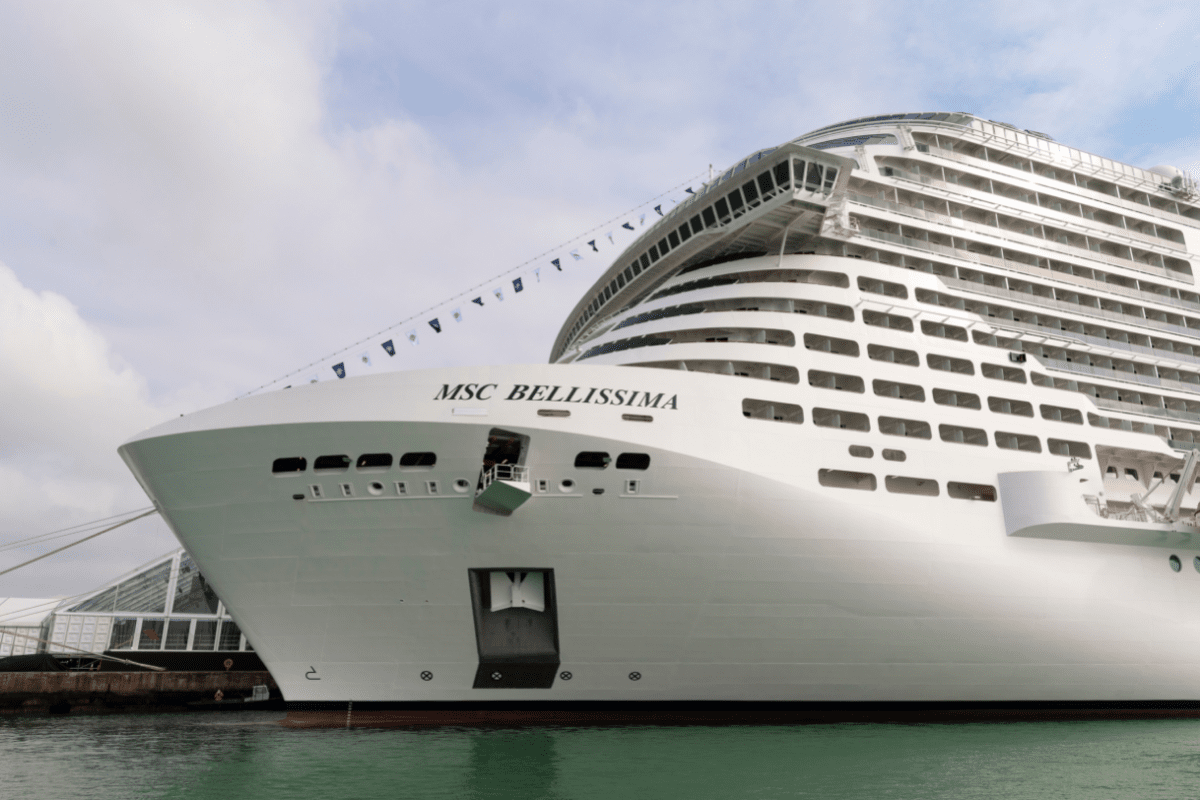
Cruise Ship Anchors (Sometimes) Have New Lives!
In the majority of cases, when a cruise ship is scrapped the anchor is scrapped along with the ship. There are a few examples though where cruise ship anchors have found new lives after their ship was scrapped.
Due to the weight and size of cruise ship anchors, it is difficult to use them for another purpose. One use of anchors has been as monuments or statues.
An anchor from the Queen Elizabeth 2 (1 of 2 anchors) currently is a landmark in Southampton. The anchor is 4.3m (14ft) by 2.7m (9ft) and weighs 13 tons.
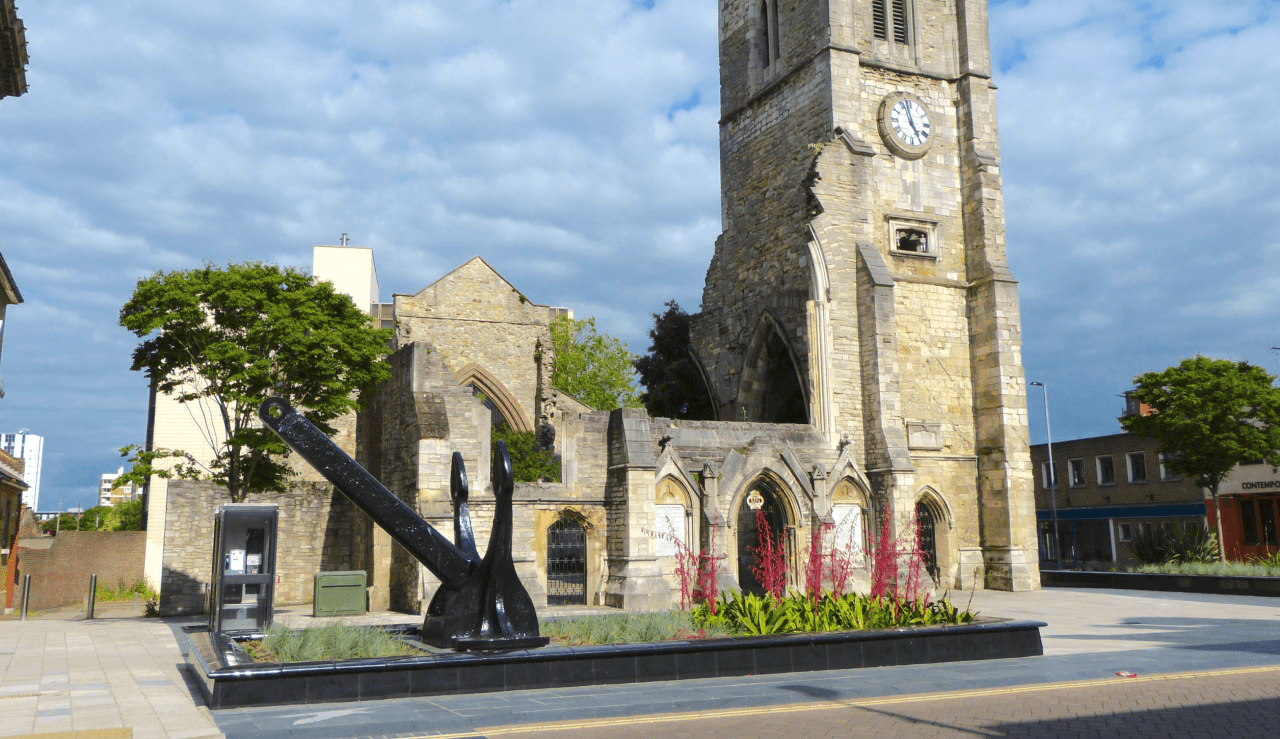
Free Insiders Cruise Line Guide
Ever wondered how the mainstream cruise lines compare? Cruise lines won’t tell you this, but I will.
This FREE guide shows you everything you need to know to find your perfect cruise line.
Enter your email address below:
Cruise Ship Anchors: Everything You Need to Know
Disclosure: This post may contain affiliate links. We may receive compensation when you purchase via my links at no cost to you. See my disclosure for more information.
Today’s massive cruise ships are some of the most technologically advanced vehicles on the planet. Yet, they still use the ancient invention, anchors.
You’d think that an invention dating back to 592 BC is out of the window, but anchors still play an essential role for cruise ships.
This article will show you everything you need to know about cruise ship anchors. We’ll compare them to the modern ship stabilizing thrusters, and we’ll also compare the size and weight of one of the most famous ships in the world.
Table of Contents
Cruise Ship Anchors
Cruise ships use anchors to hold the ship in place. Cruise ship anchors are commonly used in tender ports, where the ship cannot moor to a land-based dock.
The first known use of ship anchors dates back to Ancient Greece, around 592 BC.
Despite advances in technology, cruise ship anchors remain essential in ship construction.
Modern ships have advanced positioning systems that keep them in place using engines and thrusters. This allows ships to remain in place without drifting.
The technology uses GPS and the cruise ship’s engines to keep the vessel stationary and counter the ocean currents and waves.
Dynamic positioning systems are commonly used when ships must remain in deep water , where an anchor may not be long enough. While the chain length limits the use of anchors, the dynamic positioning systems don’t have any limitations. They can be used in water of any depth and are often used to keep ships positioned in the deep ocean.
They also pose less risk to coral reefs, where an anchor might disturb the reef.
Despite the advantages of dynamic positioning systems, the new technology doesn’t eliminate the need for anchors.
Ship stabilizing thrusters consume fuel and are liable to malfunction and damage. While they don’t impact coral reefs like the anchor, burning fuel has its own environmental impact.
On the other hand, anchors are much more economical when keeping the ship in place since they consume no fuel.
How Do Cruise Ship Anchors Work?

Cruise ship anchors work by extending down to the seabed of shallow water and using their weight to hold the ship in position.
Anchors rest against the sea bed and utilize their heavy weight to keep the ship stationary. They counter the effect of currents and waves, holding the ship in its position.
Utilizing the sea bed is why cruise ships can’t rely on anchors in deep or open water. These anchors’ chains have a limited length; if the anchor can’t reach the sea bed, it can’t perform its function.
How Big Are Cruise Ship Anchors?

Cruise ship anchors range between 10–20 feet long and average 8–15 feet wide. An anchor’s size is directly proportional to the size of the vessel.
Larger and heavier ships require larger and heavier anchors.
The Titanic had an 18 foot 6 inches long main anchor, and it was the largest anchor made at the time.
Let’s not forget about the chains that hold these anchors. These chains have various lengths and thicknesses. The chains’ length depends on the anchor they’re supposed to carry, and the thickness depends on the ship they’re supposed to hold.
How Heavy Are Cruise Ship Anchors?

The average weight of cruise ship anchors ranges between 10–20 US tons . The weight can go considerably higher to accommodate the largest ships. However, it’s unlikely to go lower because it would be difficult for it to stabilize a ship with a lower weight.
The Titanic had an anchor that weighed around 16 US tons. Even back then, that was mighty impressive.
Despite the anchor’s weight, it merely acts as a point of contact with the seabed. The anchor’s chain is far heavier and vital in keeping the ship stationary.
Anchor Chains
Nautical engineers use various methods to calculate the chain length. Generally, heavier anchors require heavier chains.
The weight of the chain helps hold the cruise ship in place.
Longer chains can withstand more movement, unlike short chains, which can cause the anchor to lose contact with the seabed during rough seas.
When an anchor is lowered into the ocean, sufficient slack must be in the chain, which rests on the seabed. The slack provides a greater surface area of contact with the seabed, which absorbs more movement.
Here’s a sample table to show you the correlation between the lengths of chains based on their anchors’ weight.
Remember that we’ll use US tons, which are slightly lighter than metric tons. 1 US ton is around 907 kg.
Regarding thickness, there are three primary sizes of chains.
Smaller vessels use 1/4 inch thick chains, medium ships use 5/18 inch chains, and the biggest cruise ships use 3/8 inch chains.
How Many Anchors Do Cruise Ships Have?

Most modern cruise ships have two anchors, with one on the port side and the other on the ship’s starboard side.
Cruise ships occasionally use both anchors if the waters are rough or there’s a strong current. Most of the time, however, the cruise ship uses only one anchor and keeps the other one for backup.
Some larger cruise ships are equipped with a third backup anchor . The third anchor is often smaller and weighs less than the primary two anchors. It’s primarily used as a backup if one of the primary anchors breaks or malfunctions.
Can a Cruise Ship Stay Idle Without Anchors?

It’s unlikely for a modern cruise ship to lose its anchors. Many cruise ships also have two anchors. So, if one becomes unusable for some reason, the second will act as backup .
If, for some reason, the ship loses all functioning anchors; it can still rely on its thrusters to keep it stable.
In the improbable scenario that both the anchors and dynamic positioning systems also get damaged, the cruise ship will be at the mercy of the moving water as long as it’s not sailing.
In other words, the cruise ship could still get from point A to point B, but it won’t manage to stay idle without anchors or dynamic positioning systems.
The only solution would be to dock and have the issues repaired.
Do Cruise Ships Still Use Anchors?

Cruise ships generally avoid using the anchor due to the environmental impact on coral reefs and the seabed.
But dropping anchor also impacts guests.
Staterooms located near the ship’s bow are some of the worst on a cruise ship. One reason is the sound of the chain when the ship drops anchor.
Cruise ships often arrive at ports of call in the early morning. And no guest wants to be woken by what sounds like a freight train at 5 am while the ship drops anchor.
So what do cruise ships do instead?
Some cruise ports, such as Labedee, Haiti, offer fixed mooring points . The mooring points allow ships to remain stationary at sea within a reasonable distance of the port. This allows the vessel to remain idle without using the anchor.
If no fixed mooring points are available, some cruise lines will opt to use dynamic positioning systems to keep the ship idle using the ship’s engines . The bridge simply inputs the coordinates, and the system takes care of the rest.
But, dynamic positioning systems come at a cost .
They require significant amounts of fuel to power the engines. Not only are fuel costs a primary consideration for cruise lines, but they also impact the environment.
Some cruise ports have local laws prohibiting the use of anchors to protect coral reefs. But if there are no laws regarding anchors, it’s up to the captain to decide whether to use the dynamic positioning system or drop anchor.
Below is a visible of the cruise ship Island Princess dropping anchor.

Final Thoughts

Cruise ships are built with impressive engineering and enriched with fantastic technology, but they’re still humble enough to remain loyal to their anchors.
Anchors excel in stabilizing large cruise ships in shallow waters as long as they’re heavy enough to do the job. They’re also a great backup solution if modern positioning systems cease to function for any reason.
However, anchors can only work if their chains are long enough for them to reach the seabed, rendering them useless in open water.
Marcello De Lio
Leave a Reply Cancel Reply
Your email address will not be published. Required fields are marked *
Name *
Email *
Add Comment *
Save my name, email, and website in this browser for the next time I comment.
Post Comment
This site uses Akismet to reduce spam. Learn how your comment data is processed .
Trending now


Cruise Ship Anchors: What You Need to Know
Cruise Ship Anchors: Some of the world’s most technologically advanced automobiles are the enormous cruise ships of today. However, they continue to use the antiquated anchor invention.
You would think that an idea that dates back to 592 BC would be obsolete, but cruise ships still depend heavily on anchors.
You will learn all there is to know about cruise ship anchors from this article. In addition to contrasting them with contemporary ship stabilizing thrusters, we’ll also weigh and dimension one of the most well-known ships in history.
Cruise Ship Anchors
As passengers tender into the port of call, Princess Cruises’ cruise ship is anchored in the Caribbean. Anchors are used by cruise ships to keep them stationary. In tender ports, where the ship is unable to moor to a land-based dock, cruise ship anchors are frequently utilized.
Ship anchors were originally used, as far as is known, in Ancient Greece in 592 BC.
Cruise ship anchors are still a crucial component of ship construction, even with technological advancements.
With the use of thrusters and engines, modern ships maintain their position thanks to sophisticated positioning systems. As a result, ships can stay still and not wander.
Utilizing GPS and the cruise ship’s engines, the system maintains the ship’s motion while fending off waves and currents in the water.
In situations where ships must stay in deep water and an anchor might not be long enough, dynamic positioning devices are frequently utilized. The chain’s length limits the use of anchors; however, dynamic positioning systems are unrestricted. They are frequently employed to maintain a ship’s position in the deep ocean and can be utilized in any depth of water.
Additionally, they lessen the possibility of an anchor disturbing coral reefs.
Even with dynamic positioning systems’ benefits, anchors are still necessary in this modern world.
Ship-stabilizing thrusters use fuel, which can also malfunction or sustain damage. Burning fuel influences the ecosystem even though it doesn’t affect coral reefs like the anchor does.
However, because they don’t use any fuel, anchors are far more cost-effective for keeping the ship stationary.
Cruise Ship Pilot: What is their Role and Responsibility?
How Do Anchors on Cruise Ships Operate?
In order to keep the ship in place, cruise ship anchors extend down to the shallow seafloor and use their weight.
Anchors use their substantial weight to keep the ship motionless while they rest against the ocean floor. They maintain the ship’s position by opposing the effects of waves and currents.
Cruise ships cannot rely on anchors in deep or open water because they must use the sea bed. The chains on these anchors have a finite length; the anchor cannot work if it is not able to reach the sea bed.
How Big Are Anchors on Cruise Ships?

Chris Allen’s replica of the Titanic’s anchor, available on Wikimedia Commons under CC BY-SA 2.0 The normal size of a cruise ship anchor is 8 to 15 feet wide, with a length of 10 to 20 feet. The size of an anchor is closely correlated with the size of the vessel.
Larger and heavier ships need anchors that are also larger and heavier.
The main anchor aboard the Titanic was the longest anchor ever manufactured at the time, measuring eighteen feet and six inches.
Remembering the chains that secure these anchors is important. The thicknesses and lengths of these chains vary. The thickness of the chains and the anchor they are intended to hold determine their length and thickness, respectively.
How Heavy Are the Anchors on Cruise Ships?
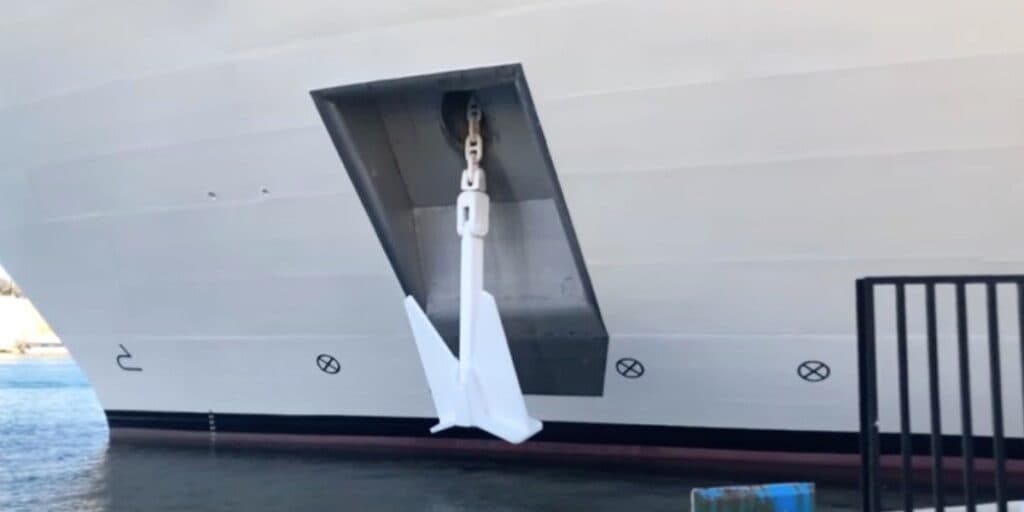
Cruise ship anchors typically weigh between ten and twenty US tons. The largest ships can be accommodated by significantly increasing the weight. It would be impossible for it to stabilize a ship with a lower weight, thus it is unlikely to go lower.
An anchor on the Titanic weighed about sixteen tons in US currency. That was really impressive even then.
The anchor serves only as a point of contact with the seafloor despite its weight. The chain of the anchor is much heavier and is essential to keeping the ship motionless.
What is the cost of fueling a cruise ship?
Anchor Chains
To determine the chain length, nautical engineers use a variety of techniques. In general, larger chains are needed for heavier anchors.
The weight of the chain helps to keep the cruise ship in place.
In contrast to short chains, which may allow the anchor to lose contact with the seafloor in choppy conditions, longer chains can tolerate greater movement.
The chain, which rests on the seafloor, needs to have enough slack when an anchor is lowered into the water. More surface area of contact with the seafloor is made possible by the slack, which absorbs more movement.
This sample table illustrates the relationship between chain lengths and the weight of their anchors.
Keep in mind that US tons, which are somewhat lighter than metric tons, will be used. 907 kg is around one US ton.
There are three main sizes of chains in terms of thickness.
Large cruise ships utilize 3/8-inch thick chains, whereas smaller ships use 1/4-inch thick chains and medium-sized ships use 5/18-inch thick chains.
What is the number of anchors on a cruise ship?
Upon docking in Rhodes Island, Greece, the Costa Fascinosa displays two cruise ship anchors. The Costa Fascinosa displays two anchors. The majority of contemporary cruise ships feature two anchors: one on the starboard side and one on the port side.
On rare occasions, when there is a strong current or heavy seas, cruise ships will employ both anchors. However, the cruise ship often only utilizes one anchor, saving the other for emergency usage.
Larger cruise ships may have a third backup anchor installed. Usually lighter than the other two anchors, the third anchor is smaller. Its main purpose is to serve as a backup in case the main anchor fails or malfunctions.
Can an Anchored Cruise Ship Remain Idle?
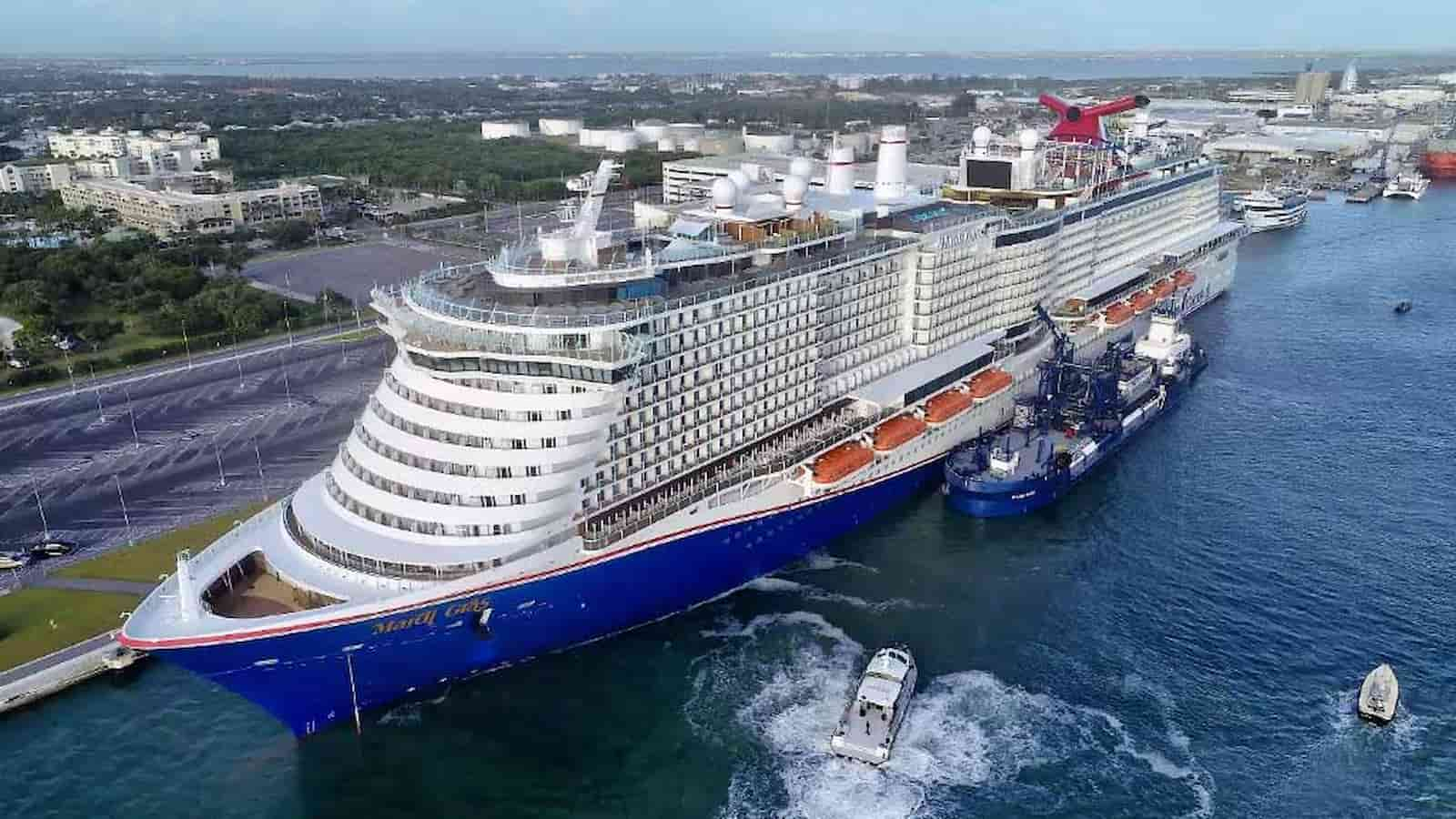
A contemporary cruise ship is not likely to lose its moorings. In addition, many cruise ships have two anchors. As a result, the second will serve as a backup in case the first breaks down for any reason.
The ship’s thrusters can keep it stable even if it loses all of its moorings for whatever reason.
The cruise ship will be at the mercy of the moving sea as long as it is not sailing, in the unlikely event that both the anchors and the dynamic positioning systems sustain damage.
Stated otherwise, the cruise ship could still get from point A to point B, but in the absence of anchors or dynamic positioning systems, it would not be able to remain still.
Docking would be the only way to get the problems fixed.
Are Anchors Still Used on Cruise Ships?
The anchor chain is visible, while Carnival Freedom is anchored off the coast of a Caribbean cruise port. Because anchoring has a negative environmental impact on the seabed and coral reefs, cruise ships usually avoid utilizing it.
The falling anchor, however, also has an impact on the visitors.
On a cruise ship, the staterooms closest to the bow are among the worst. The sound of the chain dropping anchor is one of the causes.
Early morning is when cruise ships typically dock at places of call. Furthermore, nobody wants to wake up at five in the morning to the sound of a freight train as the ship drops anchor.
What then, do cruise ships do differently? Fixed mooring places are available at certain cruise ports, such as Labedee, Haiti. Ships can stay still at sea as long as they are moored within a reasonable distance of the port. As a result, the ship can continue to move without deploying the anchor.
Some cruise lines choose to use dynamic positioning systems, which use the ship’s engines to keep the ship idle, if there are no fixed mooring locations available. All the bridge has to do is enter the coordinates; the system handles the rest.
However, there is a price for dynamic positioning systems.
To keep the engines running, they need a lot of gasoline. Cruise companies not only prioritize fuel expenses, but they also have an environmental impact.
Local rules in several cruise ports forbid using anchors to save coral reefs. The captain must choose whether to drop anchor or employ the dynamic positioning system if there are no regulations on anchors.
Related Posts
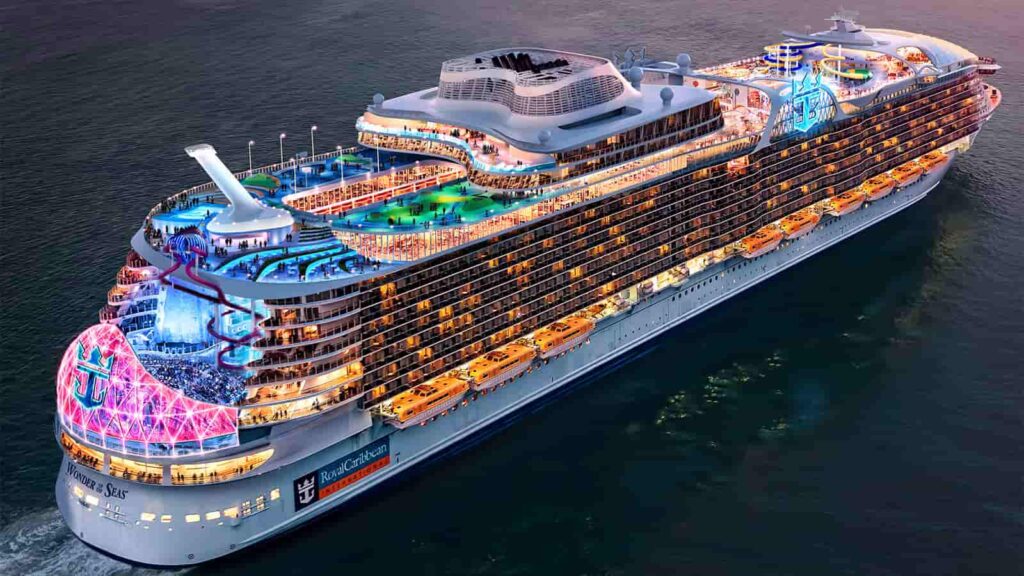
Royal Caribbean Cruises, History, Destinations and Itineraries

Ambassador Cruise Line: Ownership and History
Leave a comment cancel reply.
Your email address will not be published. Required fields are marked *
Save my name, email, and website in this browser for the next time I comment.
- BOAT OF THE YEAR
- Newsletters
- Sailboat Reviews
- Boating Safety
- Sailing Totem
- Charter Resources
- Destinations
- Galley Recipes
- Living Aboard
- Sails and Rigging
- Maintenance

Understanding Anchor Chain
- By Steve D'Antonio
- Updated: October 2, 2019
All chain’s the same, right? Well, no. There’s actually a variety of types and grades of anchor chain that cruising sailors should know about. What follows is a primer on understanding anchor chain and how to use it properly.
Types of Anchor Chain
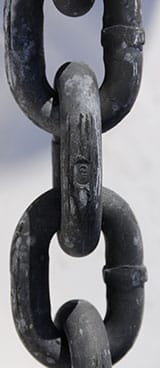
Your Chain Explained
The most popular varieties of galvanized-steel windlass chain include high-test or grade 40 (usually marked HT, G4, or HT4); triple B or grade 30 (marked as BBB or 3B); and proof coil, also grade 30 (often marked PC, PC3, or G3). Each has attributes and shortcomings. BBB and proof coil are made from low-carbon steel; heat-treated high-test is made from a high carbon-manganese alloy.
HT chain is widely used because of its “strength-to-link” factor: Its working load limit is nearly twice that of BBB chain, and it has the highest weight-to-working load ratio. In other words, it allows the use of a thinner link, which means more chain can be stored in a given chain locker. Its links are also windlass calibrated, which means that they should fit any wildcat with an “HT” designation. Such links also tend to resist tangling in the locker.
Most PC chain is designated as “non-calibrated for windlass use.” This means it’s not designed to be used with a windlass wildcat. Period. Unfortunately, this caveat is unlikely to be stamped directly on the chain, so you can never be certain if the chain falls into this category. (If chain is verifiably approved for your windlass, it may be used for anchor rodes.) PC chain has roughly the same working load as BBB chain and the same number of links per foot as HT; for 3/8-inch chain, the ratio is 9.8 links per foot of chain. It’s worth noting that some windlass manufacturers, for obvious reasons, don’t offer a PC wildcat. If someone offers you a pile of cheap PC chain, beware.

Most high-quality chain from reputable manufacturers is embossed with a designation indicating the grade. Without one, you’ll be guessing about the chain’s strength. Failing to use chain designed for a specific windlass wildcat can lead to potentially dangerous overrides (above). This chain is in no-man’s land: It can’t be lowered or raised.
At one time, though not the strongest option for a given link size, BBB was the most popular anchor chain because it’s specifically calibrated for windlasses. But its primary attribute is its weight. A 100-foot length of 3/8-inch BBB weighs approximately 165 pounds, while identical lengths of HT and PC weigh 153 and 140 pounds, respectively. With anchor rodes, weight is critical. Every additional pound increases a chain’s catenary, the sag induced by the deployed chain. Still, many builders and sailors choose HT over BBB because, for the same tensile strength, they can fit more of it into cramped chain lockers. And, again, it’s less prone to tangle.
Maintaining Your Marine Chain
Inspect your marine chain carefully and regularly. Make certain that the links fit evenly into each recess of the wildcat and that the wildcat is equipped with a stripper, a steel bar that separates tensioned chain from the wildcat as it’s being retrieved. If the stripper is absent or bent, jams are more likely to occur. Finally, be sure that the bitter end of the chain is attached to the vessel via a spliced-on section of line that’s long enough to reach the deck. The splice should fit easily through the chain hawser. If you’re dragging onto a lee shore or you’re about to be run down, this line acts as a safety valve allowing you to quickly cut the boat free from the ground tackle.
To read more monthly maintenance tips, click here.
- More: boat maintenance , How To , maintenance
- More How To
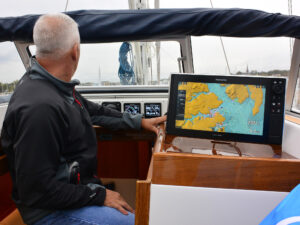
Adding Onboard Electronics? Here’s How To Get Started
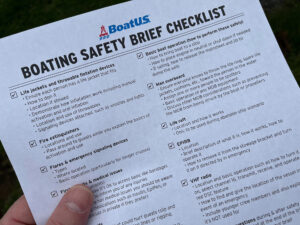
7 Boating Safety Tips for Summer Cruising
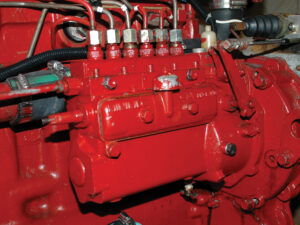
How to Prep for a Diesel You Can Depend On
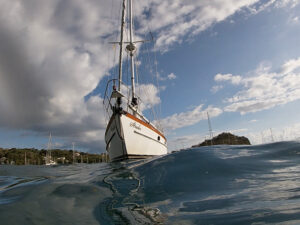
Anchoring in Paradise
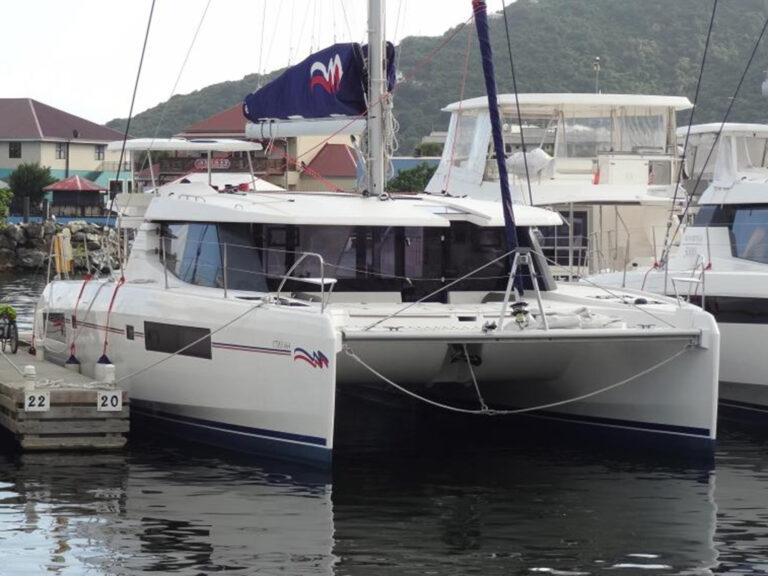
Now For Sale: Leopard 45
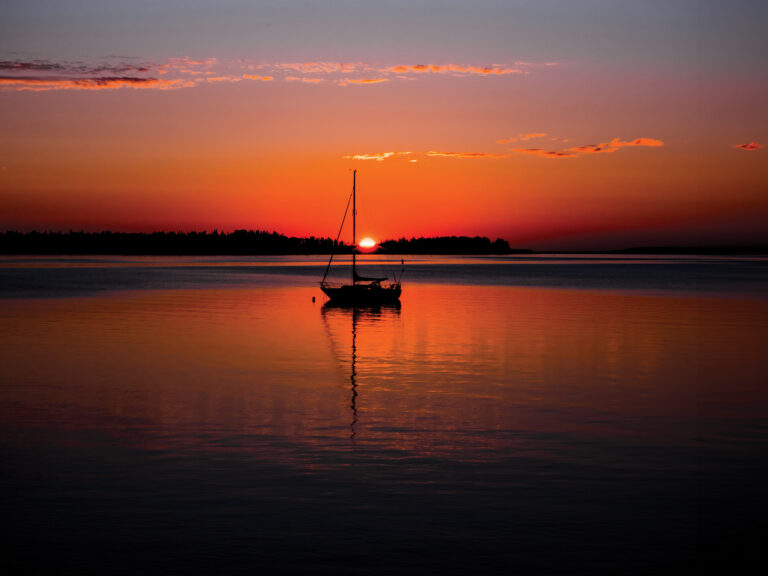
The Long Way Around

Sailing to the Land of Shrimp

Swallow Tattoos and Sailors
- Digital Edition
- Customer Service
- Privacy Policy
- Email Newsletters
- Cruising World
- Sailing World
- Salt Water Sportsman
- Sport Fishing
- Wakeboarding

Marine Anchor Chain – A Complete FAQ Guide
Table of contents.
Anchor chains play an essential role in the marine industry – with them, ships and vessels can stay safe and securely halted throughout their journey. If you want all the essential information regarding an anchor chain and how it works, this is the perfect place to start.
This FAQ guide will provide a comprehensive idea of the advantages, types, and other details of marine anchor chains.
1. What is a Marine Anchor Chain?

Figure 1 Marine Anchor Chain
Marine anchor chains keep your ships safe. This heavy-duty chain is made to withstand the rough conditions out at sea: salt water, changes in temperature and salinity, and extreme pressure changes due to waves or rapid currents.
An anchor chain helps ensure that vessels stay in one place – whether used for travel, recreation, commercial fishing, or cruising. The chain is constructed from thick steel links connected using pins.
In some cases, additional pieces, such as shackles, might be added to parts of the chain for enhanced safety and strength. This chain is essential to make sure you can confidently head out onto the open ocean without worrying about getting swept away!

Figure 2: Chain Parts
2. What is the Importance of the Marine Anchor Chain?
A marine anchor chain – also known as an anchor rode – is a crucial component of the vessel’s anchoring system. Its purpose is to securely attach the anchor to a part of the boat so that it may be quickly and easily lifted in times of need.
Furthermore, this chain plays an essential role in deflecting specific forces away from the anchor head and main structure. When faced with extreme weather conditions such as storms or strong currents, a ship or offshore rig may tilt and heel uncontrollably, severely damaging its hull if not adequately protected.

Figure 3: Anchor Chains
Anchor chains are designed to absorb pressure placed on them, reducing the force exerted upon them. It allows for a potential decrease in damage caused by heavy weights as anchor chains and cables are manufactured to withstand substantial forces without harm or distortion.
3. Write Some Benefits of Using Marine Anchor Chain?
Marine anchor chains are a lifesaver in keeping a vessel safe while it is out at sea. The chain connects the ship and the anchor, ensuring the boat remains safe from harm. Anchor chains are incredibly strong, allowing your boat to remain stationary amidst all weather conditions. Not only do they offer maximum strength, but they also feature an impressive level of corrosion resistance due to their construction with high-grade steel.

Figure 4: Anchor Chain in Water
In addition to this, marine anchor chains do not need to be replaced frequently like some other materials, making them cost-effective in the long run.
4. What are the Important Factors to Consider While Selecting the Marine Anchor Chain?
When selecting or creating the anchor chain, several essential elements must be considered.
- Firstly, the highest permissible load should be taken into account.
- Secondly, storage ease must be considered.
- Finally, the rode’s expected length should also be considered when selecting an anchor chain.
When it comes to rode designs, it is essential to factor in convenience and ease during storage. Anchor chains need to be placed away carefully so that the hull of the boat is not damaged as a result of an anchor chain being left hanging down too much or entangling itself with other elements around it.
Every ship or offshore station has a good understanding of the depths of their working areas and can therefore determine the length at which the anchor rode should be securely attached.
The scope is a ratio that expresses the relationship between the amount of anchor rode paid out to the actual depth of the water body. It reflects a balance between how much vertical force an anchor exerts on a vessel and how much drift it experiences.
The scope of a ship’s anchor chain will usually range from a 5:1 to a 7:1 ratio, meaning that for every one foot of depth in the water, there will be five to seven feet of anchor line. Shorter chains are better at holding the vessel in place since they contain less slack, which helps prevent the waves’ natural motions from moving the boat away.
When the chain is released, and the angle between the anchor rode, and the bottom of the vessel is greater than 90 degrees, any sudden impacts or jerks are quickly transferred to both the rode and boat. This means that a more extensive range of motion can be achieved, and any force acting on the boat will begin to reduce in intensity. As a result, this allows it to drift into an area far more expansive than initially anticipated.
Check the video for some important tips to choose the right anchor chain:
5. Why Can You Use Cable and Anchor Chains Combination?
If the design of a system involves both, it may be able to overcome some of the issues that arise due to the large number of variables involved in each design.

Figure 5: Combination of Chain and Cable
A cable and chain rode combination is commonly used in large cruise ships and offshore structures. This concept works because the chain components of the anchor rode are more suitable for use in areas with rougher seabeds, where cables cannot be used. The steel links within the chain sections have a higher tensile strength required to resist pulling force on the anchor and the ship, thus preserving the integrity of its position.
A typical anchor rode consists of a length of cable, usually made up of galvanized steel or stainless steel wire rope, connected to a short section of chain and then onto an anchor stock. For this reason, joining both types of rodes necessitates utilizing specialized techniques. It is at this junction between cable and chain where most failures occur due to its heightened fragility.
The junction between the cable and chain is covered with a galvanized connection, allowing for a secure and reliable interlocking of the two elements. The cable fibers are partially linked to the chain, creating an even stronger bond. It is further enhanced by being able to connect the cable to the chain as well directly.
Using this combination of cable and chain has numerous advantages. However, if not using such a combination in such conditions, then the single heavy chained element won’t stay on the seafloor due to its lack of weight anchoring it down. In addition, due to its sturdiness when connected, this combination can easily withstand strong waves or winds without coming apart or getting displaced from its anchored position at the seabed.
6. What is Marine Anchor Chain Marking?
The importance of an anchor chain’s scope cannot be understated, as it is necessary to maintain a balance between the movements of the vessel and the strain that is placed on the cable or chain during anchoring. This means it is absolutely essential to be aware of how much anchor rode has been used. To this end, painted sections and plastic markers are strategically positioned along the anchor rode in order to help those involved in anchoring operations, such as the operator, identify quickly how much rope they have put into use.
Compared to traditional painting and other methods of marking the water, plastic rope markers have the advantage of having a longer life on the seas. The paid-out rope length can be typically shown by colored zip ties having different knots at various uniform intervals. These intervals lie between 25 feet and 7.5 meters.
As part of nautical norms, the colors used for length indicators tend to be white, red, and blue. Moreover, they can disintegrate if they come into contact with tethering spools and hawse pipes frequently.
7. How to Store Marine Anchor Chain Properly?
The anchor chain serves an essential purpose in providing extra stability to the anchor, which is often made of metal. But due to being exposed to the harsh environment, these materials are prone to rust and wear over time, making them increasingly vulnerable. This is why it’s essential that when boats bring their anchors back onboard, they must scrutinize them for any signs of damage.
For this, appropriate storage facilities must be constructed so that the rode may be quickly retrieved for maintenance.
Inside the ship’s hull lies the chain locker: an enclosure specially designed to provide ventilation and store anchor chains when they are not in use. This space is typically reinforced with additional materials to support the heavy load of the metal rope and accompanying anchor that is often stored there. As needed, engineer staff can access the locker for regular inspections or maintenance services.
The locker itself is strong enough to withstand immense pressure and strain exerted by the heavy weight of the chain and its elements. Its walls are often made from thick steel plates or reinforced concrete, ensuring it will remain secure during harsh ocean conditions.

Figure 6: Chain Locker Location
It is critically important that the anchor storage equipment on a vessel is set up incorrectly, as it can lead to considerable danger if mechanical problems occur with the windlass. This windlass may offer power to raise or lower the anchor chain, so having an organized arrangement of port and starboard side anchors is essential. If this equipment is not set up correctly, there could be an unforeseen issue with the raising and lowering of the anchor chain.
Marine Cable
- Marine Power Cable
- Marine VFD Cable
- Marine Telephone Cable
- Marine Flex Wire
Offshore Cable
- Offshore Power Cable
- Offshore VFD Cable
- Instrumentation Cable
- Offshore Wire
More Products
Quick Contacts
NO.1299, East Section of Yinxian Avenue,Yinzhou Dist, Ningbo, Zhejiang, China
- Carnival Cruise News
- Royal Caribbean News
- Disney Cruise News
- Travel News
- Casino News
- Cruise News
The Anatomy of a Cruise Ship Anchor Chain

While it may seem like a relatively simple piece of equipment, a cruise ship’s anchor is a marvel of modern engineering. When you consider the incredible size and weight of a modern-day cruise ship, you begin to realize what an incredibly difficult task is to ensure they are secured in place while they are in the harbor.
Today, we will take an in-depth look at cruise ship anchor chains. Not only will we break down how they work, but we also explore what they are made from, the various components of the chain, and the incredible engineering that goes into ensuring that they can hold a cruise ship in place.
So, if you are ready to learn everything you need to know about a cruise ship anchor chain, let’s get started!
While it may seem pretty self-explanatory, a cruise ship anchor chain plays a complex and incredibly important role in ensuring the overall safety of a cruise ship voyage. These massive chains need to withstand the incredible forces exerted on the cruise ship’s anchor when the cruise ship is in the harbor.
To withstand the immense pressure generated by holding a heavy cruise ship in place against tides, waves, and ocean currents, the anchor chain and cables need to be immensely strong, and incredibly flexible. The individual chain links look just like any other type of chain, but they are on a massive scale.
Each link in the chain is made from high-grade steel with incredible tensile strength. While the chain size will vary depending on the size and weight of the cruise ship, they are all incredibly large and heavy.

Read Also: What is the Draft of a Ship?
In some cases, the waters the cruise ship traverses can also be a factor when determining how large the anchor chain needs to be. For example, large ships that traverse deep waters with strong currents need a much larger anchor and anchor chain than small boats on shallow water that stay close to the coastline.
The traditional anchor chains of a cruise ship may seem like they have a relatively simple design, but they are made up of many different parts, which all have to be made to an extremely high standard.
Here are the main components of a cruise ship anchor chain:
The most prominent component of a cruise ship anchor chain is the series of interconnected links that make up the bulk of the chain. These links are massive in scale, and they need to be constructed of high-tensile, high-strength steel.
The chain design allows for the perfect combination of strength and flexibility, which is necessary when holding a heavy anchor in place against the tremendous forces of a large body of water and heavy vessels.
Each link in the chain will look like an elongated oval, or it can be designed to have more of a “D” shape. These two shapes allow the chains to be connected in a way that maintains their strength but can still move smoothly.
All links within the chain are also designed to be the exact same size. They also need to be precisely spaced so that each link has the same freedom to move as the next. If this was not the case, dropping and retrieving the anchor would be much rougher. The chain could also become damaged over time.
The individual links within the chain are joined together using a detachable mechanism. Basically, this mechanism consists of a connector and an anchor shackle.
Not only does this make it possible to put the chain together, it also makes it possible to remove damaged or corroded links within the chain without completely replacing the entire anchor chain.
Most cruise ship anchor chains also feature depth markings at evenly spaced-out intervals. These allow crew members to easily determine how much of the chain has been released by the anchor windlass. Typically, these markings are made with bright, scratch-resistant paint; however, they can be made by stamping impressions into the metal.
To learn more about the anchor of a cruise ship, rather than just the chain that connects it to the ship, we recommend reading about how big a cruise ship anchor is . This straightforward guide explains how big these enormous anchors need to be and provides other helpful information on how modern anchors work.
As mentioned, the anchor weight, chain length, and size of a cruise ship’s chain can vary depending on the weight and dimensions of the cruise ship itself.
That said, the general range for a single link of the anchor’s chain tends to be between 11 lbs (5 kg) to about 290 lbs (130 kg). The longer the chain length, the more it weighs.
Worth Reading: How Much Does a Cruise Ship Weigh?
With individual links weighing so much, the anchor chain’s overall weight can easily be measured in tons. When you think about the weight of a cruise ship and the immense forces sea and ocean water can exert, it only makes sense that the chains need to be incredibly heavy.
Cruise ship anchor chains need to be made from high-strength steel. Steel is the only suitable choice, as it offers the durability and strength required to withstand such immense forces. The high-strength steel alloys used to make these enormous anchor chains are also resistant to corrosion caused by lengthy exposure to saltwater.
To enhance the corrosion resistance of the anchor chain, most are given additional coatings and surface treatments to enhance the anchor chain’s corrosion resistance. Galvanization and various types of specialized coatings are used for the individual links of the anchor chain.
These surface treatments can not only delay corrosion, they can also help prevent scratching as the chain links rub against each other and even the hull.
Not only do cruise ship anchor chains need to be heavy, strong, and incredibly durable, they need to be flexible. Flexibility is essential for the following reasons:
Even when a cruise ship is anchored in a harbor, the anchor chain must be capable of adjusting to fluctuations in water conditions. The tide can change the depth of the water rapidly, so if the chain is not flexible, it would be under much more tension.
This could damage the anchor and the ship itself. By remaining flexible, the anchor chain can also absorb sudden forces caused by large waves and storms.
A flexible anchor chain creates far less noise when the ship moves. For passengers to have a more comfortable experience while they are on board the ship, flexible anchor chains reduce creaks and other noises that could be disturbing.
The chain’s flexibility is essential when it comes to dropping and retrieving the anchor. When the anchor is dropped or lifted, the chain flows through a chute on the side of the ship’s bow.
As you may know, a seabed in one area can differ in composition from one area to the next. While some are sandy and easy for an anchor to dig into, others are uneven and rocky. By having a strong but flexible anchor chain, the anchor can have a much more stable hold.
Currently, the world’s largest anchor chain belongs to the Oasis Class cruise ships owned and operated by Royal Caribbean International. These anchor chains weigh between 130 and 160 tons!
Although extremely rare, cruise ship anchor chains have been known to break. Typically, this is due to corrosion and long-standing exposure to salty seawater. Overloading the anchor chain by dropping anchor in rough seas can also cause wear and tear. Eventually, this damage could result in the chain breaking.
Read about an anchor lost after getting stuck near San Juan for an example of how and why large vessels could be forced to cut its anchor loose.
While the exact frequency of inspections will depend on the particular policies of each cruise line, most anchor chains are inspected as part of the cruise ship’s regular inspection and maintenance procedures. This means a visual inspection usually occurs before each voyage.
More in-depth inspections are typically conducted at least once a year. During these inspections, each chain link is checked for signs of damage and corrosion. As you would expect, the frequency and closeness of inspections can increase if the crew suspects that the anchor chain could be damaged.
While casual cruise-goers often overlook them, there is an incredible amount of engineering that goes into making and maintaining a cruise ship anchor chain. Not only is the scale of the individual links impressive, but the ability of the chain to withstand immense forces is also truly a marvel of maritime engineering.
RELATED ARTICLES MORE FROM AUTHOR
See how Princess Cruises Alaska Sailing Impacted By Propulsion Problems
See how Holland America Line Unveils 132-Day and 93-Day World Cruises from US
See how Residential Cruise Line Offers New Retirement Program for Up To $499,999
Leave a reply cancel reply.
Save my name, email, and website in this browser for the next time I comment.

Don't Miss
Check out port operator announces expansion plans at caribbean destination, check out costa ship sets sail on last cruise before joining carnival, take a look at what to do if your cruise ship leaves without you..., see how the world cruise that sold out in 30 minutes begins 180-day..., even more news.
See how Holland America Line Unveils 132-Day and 93-Day World...
See how Residential Cruise Line Offers New Retirement Program for...
Popular category.
- Cruise News 2310
- Disney Cruise News 253
- Carnival Cruise News 74
- Casino News 68
- Royal Caribbean News 68
- Travel News 33
- Visit our Youtube page!
Sign up now for our WhatsApp newsletter and receive a FREE SVB set of playing cards!
Get the latest SVB news via WhatsApp and/or SMS!
- Spare parts
- SVB@Youtube
- My SVB Account
- Compare list
Are you missing items that you have already placed in your shopping cart? Log in to see your saved items.
- Anchoring & Mooring Correctly
Anchor chains and lines

In this comprehensive guide to anchor chains and anchor lines, we hope you'll find all the answers to the most important questions and plenty of helpful tips! As any skipper will tell you, every boat must have reliable, quality anchor equipment at its disposal. Not only is this essential when moored in a quiet and idyllic bay, but even more so when there is wind or swell. Making the right choice will therefore not only make your life easier on board, it is also paramount to ensuring the safety of your boat and its crew. Anchor chains can come in various grades and types, and each has its own specifications and features that enhance effectiveness. The wide range of products is sure to satisfy all requirements. However, one thing is true for all chains: the breaking load of an anchor chain must be such that it is able to withstand individually acting forces caused by the current, wind and swell in any situation, and this also depends on the boat's size, depth of the water and anchorage. The weight of your anchor chain is also an important factor to consider, as is how easy it is to handle on board. It may therefore be worthwhile looking at chain and rope combinations when choosing anchor rode.
The right choice
- Choosing an anchor chain
- DIN or ISO?
Anchor chain thickness
Anchor line or anchor chain, selection criteria & properties, length of anchor chain or line, chain fore-runner, anchor buddy (weight), attaching, using and caring for your anchor chain, finding the right anchor chain, how to choose the right anchor chain.
Finding the right anchor chain depends first and foremost on your type of boat and the area you sail in. Hot-dip galvanised steel chains are widely used in northern latitudes. "This type of chain is reasonably cheap, but also has properties you should be aware of," explains Dietbrecht, equipment expert at SVB. "Because of its rough surface, silt or algae tend to stick to it. Furthermore, the zinc coating could eventually rub off on the seabed, which could cause rust to occur on damaged areas."
What's more, when raising anchor, this kind of chain doesn't flow as compactly into the locker as well as others. The chain can form a pyramid, meaning that the hanging part won't be heavy enough to pull the chain down into the locker. This is not the case with smooth stainless-steel chains, also called Niro chains, but these are around three to four times more expensive and some alloys have little or no corrosion resistance in warm water areas (Caribbean or Mediterranean). The salt water literally eats into the steel and forms holes, which, if they remain unnoticed, can cause the chain to break unexpectedly under load. High-quality, so-called high-strength steel or duplex steel is supposed to prevent such a scenario, but other products also offer corrosion resistance.

Anchor chains: DIN or ISO?
What does din and iso mean.
In Germany, chains are manufactured according to the industry standard DIN 766. Chains from other European countries often correspond to the ISO standard 4565. DIN sizes correspond to uniform dimensions that have been established according to the German Institute for Standardisation (DIN). The International Organisation for Standardisation, ISO for short (from Greek isos = equal), is a corresponding international standardisation organisation. Outside Europe, chains are commonly measured in inches.
"If using a windlass on board, the size of the anchor chain must match that of the gypsy," says Dietbrecht. "If the links in the chain are the wrong size, it will jump and not run through smoothly." By conforming to strict calibration standards such as ISO or DIN, most anchor chains and chain links will run reliably through the windlass. According to DIN and ISO, round steel chain links with a thickness of six and eight millimetres are identical in terms of link length and internal link dimensions. Differences in classification only exist from a size of ten millimetres of steel chain. This information is usually indicated on the winch. However, these industry standards do not say anything about the material of the chain steel and the alloys can have very different properties. Steel chains of the designations 1.4401, AISI 316, V4A, 1.4404, AISI 316L are not considered suitable for seawater in warm areas. The benchmark here is the material 1.4462 (AISI 318LN).

Overview ISO anchor chain
Din chain characteristics.

Which anchor chain thickness should i have?
There are no legal guidelines on chain thickness, so responsibility here lies with the owner or skipper. You'll have to decide for yourself which is the best anchor chain for your boat. Many specifications and recommendations for skippers are based on safety guidelines issued by yacht associations or the Germanischer Lloyd (GL) classification society. From a purely economic point of view, an anchor chain should of course only ever be as thick as it needs to be. However, experienced boaters do tend to choose chains that are a little thicker, to be on the safe side in case of an emergency. The required chain link thickness is determined by the size of the vessel, i.e., the boat weight and the breaking load of the anchor chain, and varies depending on the chain material. Some specifications base the calculation of the breaking load of an anchor chain on the displacement of the boat, which corresponds to the boat weight in relation to its mass. The average breaking load value for ten-millimetre chain steel is about 80 Kn. The minimum breaking load according to DIN 766 is 4.0 t for a 10 mm round steel chain. The most common thickness for recreational boats is eight, ten and twelve millimetres. An alternative recommendation is provided by Germanischer Lloyd, which refers to the length of the ship (GL recommendation): up to 8 metres boat length = 6 millimetres chain steel, up to 10 metres = 8 millimetres, up to 12 metres = 10 millimetres, up to 14 metres = 12 millimetres and up to 16 metres = 13 millimetres. " You can't tell what loads an anchor chain can take by looking at it from the outside, so a new anchor chain should always have a test certificate from the manufacturer," recommends Dietbrecht, sailor and boating expert.
This is the only way you can be sure that the specified breaking load and gauge accuracy (i.e. exact adherence to the specified dimensions) is correct, and you won't be in for any nasty surprises when at anchor. The price of an anchor chain can vary considerably and depends on the design, quality and length you need. This can range from a few hundred to several thousand euros.
TIP: „Breaking loads on galvanised chains and Nirosta chains are the same. They just have different surface finishes. Hence the difference in price."
Anchor chain

Should i use Anchor line or anchor chain?
Because of its high tensile strength, many skippers prefer an anchor chain. But on dinghies, inflatable boats or small motor yachts (up to 1.5 t weight), you can use an anchor line and it does offer some advantages. Due to its light weight, an anchor line is easier to handle; moreover, the weight of an anchor chain will affect the trim and increase hobby-horsing if stowed in the bow. Furthermore, anchor lines can also have considerable breaking loads, about eight tonnes at 22 millimetres thick, and in adverse conditions with waves or wind they are actually superior to a chain because of their elasticity. Because the line is more flexible, it can absorb dynamic load peaks better, whereby an anchor chain would "jolt" hard. This jerking happens when a wave hits the bow while the chain is taught. The risk here is that the anchor could be ripped free from its hold, or anchor equipment, such as a windlass or cleat could become damaged.
From boat sizes with a weight of 1.5 t, the thickness of an anchor line should be at least twelve millimetres. 10-millimetre lines should be chosen for smaller boats as they are better to handle. Any thinner and lines can cut easily into the hand when being hauled in. The ideal material for an anchor line is nylon or polyester with square braid. Polyethylene lines are not suitable as anchor lines because they do not absorb water and tend to float as a result. Likewise, mooring lines are not suitable for use as anchor lines. Mooring lines must be UV resistant, flexible and have good stretch and abrasion resistance.
Anchor lines, on the other hand, should be relatively stretch-free, but still elastic enough to prevent jerking. Disadvantage of an anchor line: Unlike a chain, it does not self-stow in the chain locker when anchoring and because you need a longer length than a chain, it takes up more space. When using a line, it is essential to note that the swing circle is larger. When a ship is at anchor, it rarely stays fixed at one point: changes in wind conditions or current direction cause it to move in an arc around the anchor. The ship's movement around the anchored position is called the anchor swinging circle. It's important to make sure there are no obstacles within the circle. A wide range of variants available on the market also includes leaded anchor lines. These lines are mostly used with a second anchor.

Anchor lines & anchor line systems

What length of anchor chain or line do i need?
The vessel size, current and swell are all factors that can determine what length anchor chain you should choose. In general, the longer the anchor chain or anchor line, the better the anchor will hold. The angle of pull is important here, and it should not exceed eight degrees. For optimal mooring of a sailboat or a motor yacht, a chain length corresponding to 5 to 7 times the water depth is usually sufficient. If an anchor line is used instead of an anchor chain, a good rule of thumb is that the line length should be at least ten times the water depth.
What do I need a Chain fore-runner for
A chain fore-runner is recommended to be used with anchor lines on boats that are above a certain weight. A fore-runner chain is a length of anchor chain that pulls down the anchor shaft by its own weight, thereby increasing the static friction on the bottom and thus the effectiveness of the anchor. A chain fore-runner will also protect the anchor line from rubbing and sheathing on rocky seabed. From a boat weight of 1.5 t, a chain fore-runnner of three metres in length is sufficient according to GL recommendations. The German Sailing Association (KA), on the other hand, recommends a chain fore-runner of at least six metres in length.
Chain fore-runners

In some situations, an anchor weight on the chain fore-runner is useful. This extra weight is lowered down on a shackle on the anchor chain and does two things: Firstly, the anchor chain is held down to the ocean bed, so that more chain pulls along the surface on the bottom. And because boat swing is reduced, this is advantageous in crowded anchorages. Secondly, an anchor buddy is useful in strong winds, as it relieves pull on the anchor chain and can prevent the anchor from breaking free. Ropes are available from retailers and suppliers by the metre, but for chains usually only in thicknesses up to 13 millimetres, and above that only in so-called "chain lengths" of about 27 metres. The length of the anchor chain on board should be at least 70 to 120 metres, depending on the sailing area, and correspondingly more for an anchor line or combination of line and chain. Some boaters insist on spare rode consisting of anchor and chain. This can be useful in difficult conditions, but again requires storage space and adds weight on board. Normally, spare rode is not necessary if you check the condition of your chain on a regular basis.
Anchoring in tidal waters presents a particular challenge. Sufficient chain must be deployed to ensure that at least five times the water depth is still out at high tide. In addition, the larger swing circle must be taken into account at low tide.
It is advisable to attach an anchor chain to the anchor with a rotating shackle. This prevents the chain from twisting. The end of an anchor chain should be attached to the boat in the chain locker with a rope lashing or strong strop so that it can be easily cut in an emergency. Always shackle a line to the chain. Don't use a sailor's knot like an anchor bend - the knot won't hold reliably in the smooth, synthetic rope. In addition, each knot causes a weak point that reduces the breaking strength of the line by about half. Above a certain boat size, the use of an electric windlass is recommended because the anchor rode is simply too heavy. If the windlass fails, you can sail towards the anchor when retrieving, thus reducing the load. In fact, this is generally advised when using a windlass because it reduces strain on that piece of equipment.
As anchor lines are not very heavy, they can usually be hauled in by hand easily. However, some windlasses have a special capstan fitted to them for this purpose. On sailing yachts, an additional capstan on the foredeck is more likely to be a nuisance and, besides, there are usually enough winches there for hauling. Special care is not required for an anchor chain and can be used for several years, depending on how much wear it is subject to. Nevertheless, it won't hurt to rinse the anchor chain and chain locker with fresh water every now and then to clean.
TIP: If your boat is winterised on land, you must take out the entire chain, including the anchor. Just let your windlass run down and that’s it. This will prevent the chain from rotting away inside the damp and salty chain locker.
Accessories for anchor chains & anchor lines

Share our guide on social media
What are you looking for?
Suggested search.
Container vessel “Maersk Kowloon” at anchor on the Great Bitter Lake in the Suez Canal. Photo: Tim, CC BY-NC 4.0 via Flickr.
16. Vessel Anchoring
Author: Dr. James A. Fawcett, USC Sea Grant Maritime Policy Specialist/Extension Director (retired) Media Contact: Leah Shore / [email protected] / (213)-740-1960
An anchor has two common definitions. Its first meaning is defined as “a heavy device that is attached to a boat or ship by a rope or chain which is dropped into a body of water to secure a boat or ship in place.” Yet, it is also defined as, “a person or thing that provides strength and support”[1] While each of these definitions is useful, they tell only a part of the story about the function of an anchor. For a ship’s anchor, it is only part of the system that secures a ship. Let’s start from the beginning below and explore the details about the importance, purpose, components, and use of a ship’s anchor.
Purpose of a Ship’s Anchor
If we think of a ship as a sort of “bridge” that connects either cargo or people from one location to another, it’s clear that the vessel is a temporary floating intermediate link between those two shorelines. After all, only in the case of Wagner’s opera Der fliegende Holländer (the “Flying Dutchman”) is the ship cursed to sail the seas indefinitely. But, at times, reaching a destination does not mean that the vessel is immediately able to enter the port to be moored to a berth. For many reasons, the vessel may be required to use an offshore anchorage, securing itself in one location for a period of time. In busy harbors, “alongside space”–the common nautical term for a spot along the wharf or where a ship can unload–is often at a premium; ships must wait for their turn to embark or discharge cargo and passengers.
While recreational vessels commonly use small anchors deployable by hand over the side of the boat, merchant ships, because of their size, use a different type of anchor and that will be the focus of this discussion. A ship’s anchor system is relatively simple but consists of a number of elements, each of which is a necessary component of the system. At one end is the anchor itself, which is connected by a stout chain. It is both let go and hauled in by an anchor windlass[2]. so that the chain can be stowed on board in a capacious chain locker below decks. It is a simple system yet with critical importance for the safety of the vessel. Let’s consider the parts of this system.
Types of Anchors
By itself, the anchor is actually the simplest part of a ship’s ground tackle :[3] “the anchors, chains, cables, and other equipment used to secure a ship at anchor.” Today, the most commonly used maritime anchor is the “stockless,” “U.S. Navy,” or “Admiralty” anchor, all of which look essentially similar. They are very different from the stocked anchor, so often depicted in literature, pirate movies, and even symbolically on the U.S. Navy and U.S. Coast Guard uniforms.
The stocked anchor consists of a central shank at the end with two upward curved arms in opposing directions, each of which is furnished with a broad forged fluke acting like a shovel to dig into the bottom. Toward the top of the stock is a long bar attached to the shank but at 90o to the direction of the arms and flukes. Thus, when the anchor reaches the ocean floor, the stock forces the anchor to lie in such a manner with one of the two flukes poised to dig into the ocean floor. (See Figure 1)
Instead of this older design, a stockless anchor, as its name implies, needs no stock to be effective. In fact, it is designed to lie flat on the ocean floor. A much simpler design, it has only one moving part, a bearing or bushing, that attaches the shank to the two flukes. When deployed on the bottom, taking a strain on the anchor chain will cause the two flukes to rotate downward and dig into the underlying bottom. Thus, the bearing between the shank and the flukes acts like an axle, permitting the flukes to engage the bottom. The beauty of the system is its simplicity as well as effectiveness because of its low center of gravity: it wants to dig into the ocean bottom. Stockless anchors can be relatively small (160 kg or ~400 lbs.) to more than 50 tons[4] (the size of the common Caterpillar D9 bulldozer) and this is merely a general idea of their mass. (See Figure 2).
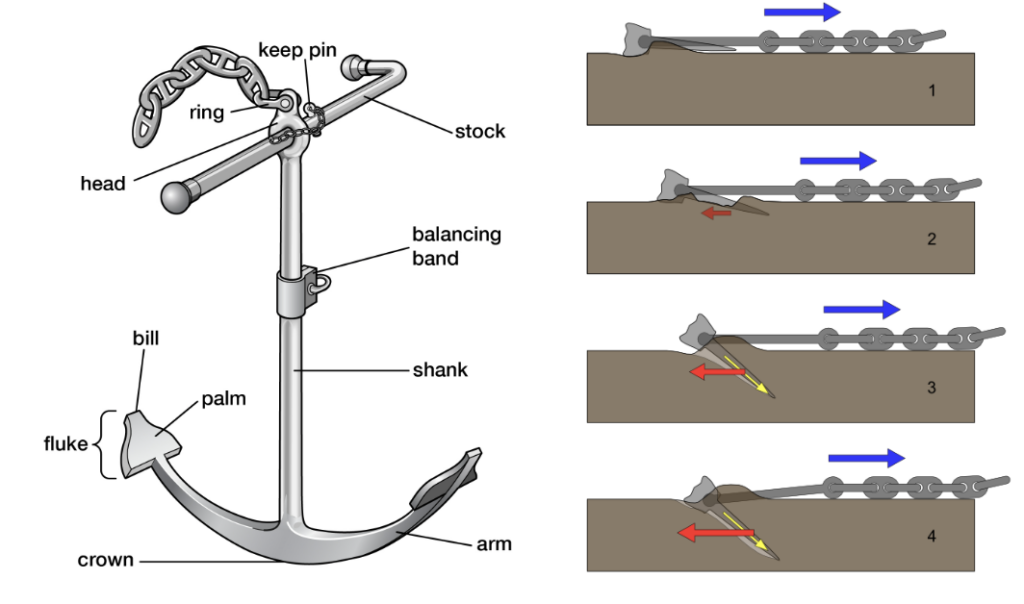
Anchor Chain
Attached to the anchor at one end and to the other end a robust fitting in the ship’s chain locker below decks, the chain is as critical, if not more so, than the anchor itself. If anchors are heavy, the chains that connect them to the ship are equally robust, with single links often weighing hundreds of pounds. An anchor chain used to be measured in “shots” of 15 fathoms (90 feet) joined by a detachable link (painted red) to the next 15-fathom shot. However, merchant ships now often have meters attached to their anchor windlasses, automatically measuring the length of an anchor chain that has been deployed. Generally, the U.S. Navy or merchant ship will carry as much as 1,000 feet of anchor chain or more (per anchor) in its chain locker, depending upon the size of the vessel.[5]
When deployed, it is common to pay out an anchor chain that is 5-7 times the water depth where the vessel is moored. Thus, in 60 feet of water, a ship would deploy 300-420 feet of anchor chain. This length serves two purposes: first, it gives the ship ample room to swing on the chain without placing excess strain on it; second, the weight of the chain and its friction on the ocean floor is the force that actually secures the ship in place , so a large volume of the deployed chain is important.
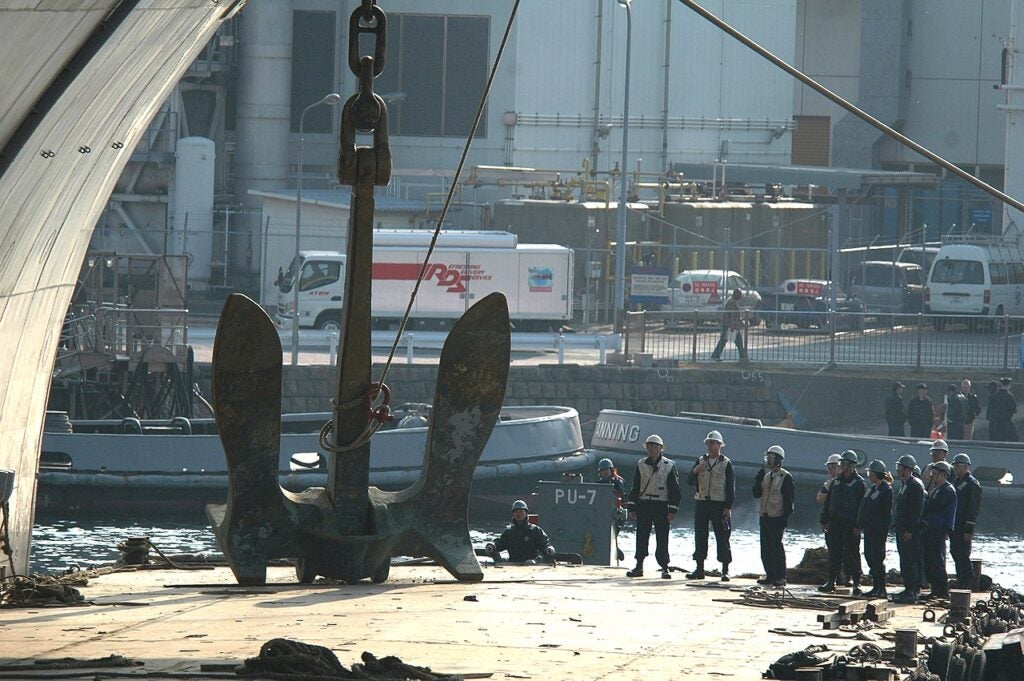
Anchor Windlass
The mass and weight of an anchor and its chain far exceed the capacity of the ship’s crew to manually raise and lower it, so on the foc’sle is a steam, hydraulic, or electric winch that is specifically designed to engage the links of the anchor chain. Equipped with clutches and brakes, the windlass can lower or raise the anchor at any specified rate, including free-running when letting go of the anchor. Upon anchoring, when the appropriate length of chain is discharged, a stopper is installed on the chain preventing further deployment.
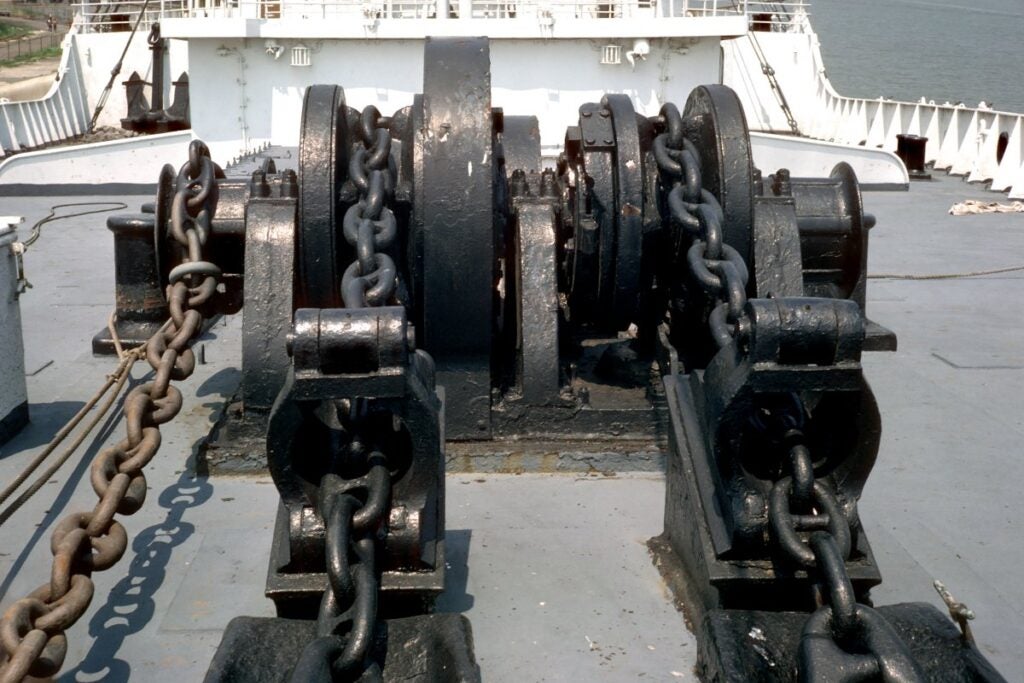
The Storage and Use of Anchors
The hawse pipe, a reinforced steel pipe from the foc’sle passing through the ship’s exterior skin allows the anchor chain to attach to the large anchor, which is stowed on the exterior of the ship when not in use. Upon its exterior is further steel reinforcement, creating a cradle in which the anchor is housed, a storage space that is both convenient and out of the way of the ship’s crew working on deck at the foc’sle. Meanwhile, the anchor chain is stowed below decks in the chain locker. Nevertheless, the chain remains connected to the anchor, permitting rapid deployment in an emergency.
Ships carry anchors on both port and starboard sides of the bow, either of which is capable of holding the ship in the anchorage in most cases. Often these two anchors have different lengths of chain depending upon the conditions encountered on the anchorage. Also, it is not uncommon for vessels to deploy both anchors in inclement weather or in an area with a fast current or high winds. In this case, expert seamanship is required to prevent them from becoming “fouled” or tangled.
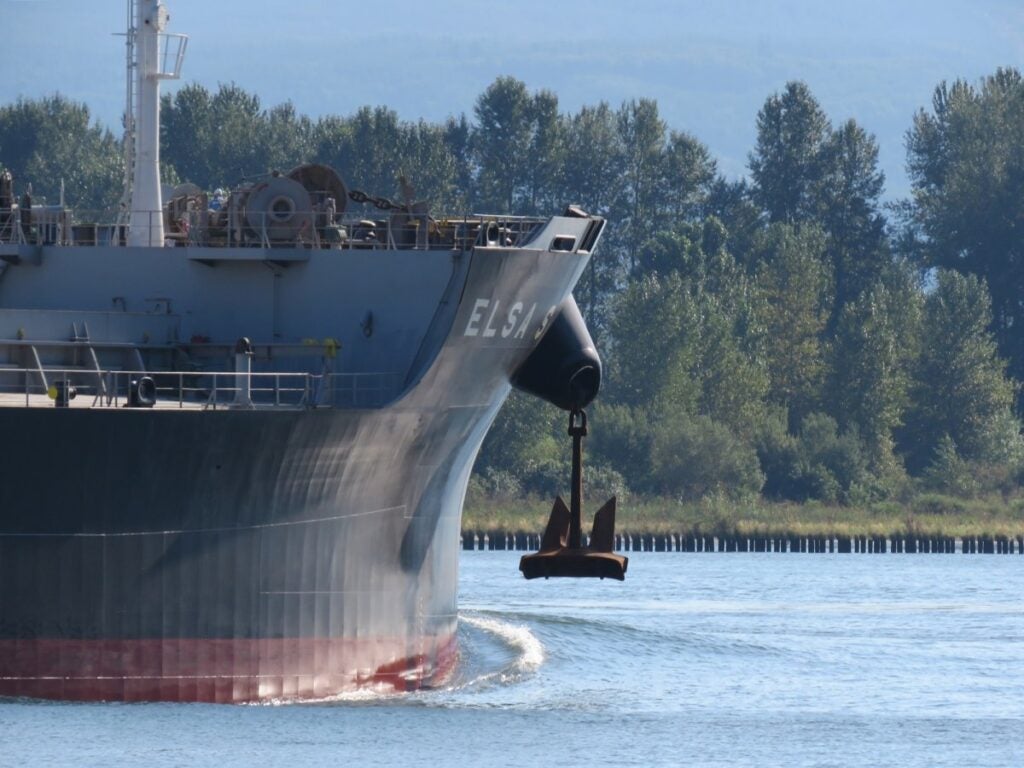
The Process of Anchoring
Safe anchorages are defined on nautical charts and are usually designated by numbers and/or letters. Coming into port, the harbormaster, port pilots, and the marine exchange/vessel traffic service (MX/VTS)[6] will instruct vessels on which designated anchorage is to be used. Each anchorage is identified on the relevant nautical chart with a center point surrounded by a circle known as the “anchor swinging circle”. This circle’s diameter is determined by the length of the vessel and displays the area within which the ship, at anchor, is required to reside. There is no “standard” size anchorage because ships are assigned based on the space that they need in order to avoid colliding with adjacent anchored vessels. At the Ports of Los Angeles and Long Beach, the nautical charts define 20 deepwater anchorages inside the long breakwater and 40 outside the breakwater. Additional anchorages are shown on the chart[7] but as CAPT Kipling Louttit, U.S. Coast Guard (ret.) and a leader of the MX/VTS, cautions, some are of limited depth or are reserved for barges with shallow draft.
In normal situations, we will commonly find a few tankers at anchor waiting for their turns at the liquid bulk terminals to offload crude oil for our local refineries, including an offloading buoy in Santa Monica Bay for the Chevron Refinery. However, in our unusual current situation , anchorages are filled with container ships waiting for vacant berths at one of the 13 container terminals in the two ports, terminals that under normal conditions schedule regular arrivals of these vessels with minimal, if any, wait times.
When all available anchorages are occupied—a common occurrence currently—the MX/VTS must find “parking” for them. One alternative is to assign ships to “drift boxes” outside the breakwater, clear of shipping arrival/departure lanes and restricted areas, and in areas defined by navigation coordinates assigned by the MX/VTS. When even those areas become filled the MX/VTS then assigns the waiting vessels to a standby area north of Catalina Island where they may not anchor but must drift under power to stand clear of other drifting vessels.
At anchor, vessels discontinue power to their propulsion engines and continue to operate their auxiliary power plant, which provides electricity to operate normal ship functions including the ground tackle previously described. Under normal conditions, the ship will swing on its anchor and will respond to currents, moving only within the circumscribed anchorage boundaries defined on the nautical chart. At anchor, services to these vessels must be provided by small service vessels bringing provisions, fuel, and other necessities out to them.
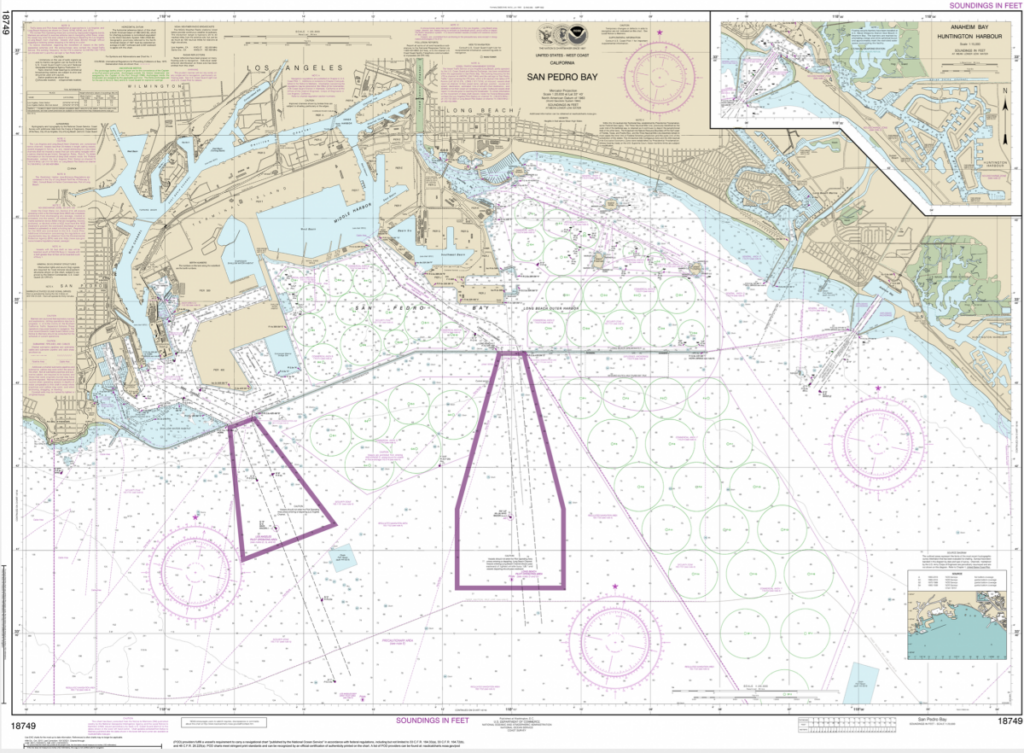
The Dangers of a “Dragging Anchor”
Even a stout anchor deployed with an ample amount of anchor chain may not be able to hold a ship in its assigned anchorage under certain weather conditions, most often when the vessel is buffeted by strong winds. The Intergovernmental Maritime Consultative Organization (now the International Maritime Organization) defines “dragging (of an anchor)” as, “ an anchor moving over the sea bottom involuntarily because it is no longer preventing the movement of the vessel. ”[8] When winds are sufficiently strong, even thousands of pounds of anchor and chain may not prevent the vessel from being pulled away from its anchorage, a condition known as “dragging anchor.” The danger of one of these incidents is that the vessel may collide with an adjacent ship causing damage to one or both. In heavy winds, the ship’s officers are responsible for either visually sighting its position every hour or maintaining a watch on electronic navigation equipment to assess its location within its assigned area.
The ships most vulnerable to “dragging anchor” are those with what mariners refer to as having a large “sail area.” These are vessels with an ample vertical component; in other words, “slab-sided” vessels such as heavily loaded container ships, roll-on, roll-off vehicle carriers, or large passenger vessels where the vessel presents what amounts to a flat “sail” to the wind. Low-lying vessels such as bulk carriers or tankships are less vulnerable because they sit much closer to the water and have low freeboard.
Any vessel that is anchored, irrespective of its configuration, is responsible to its owners, crew, cargo owners, and the public to maintain a vigilant watch when at anchor and in conditions of significant wind. Ultimately, the IMO imposes standards for ship masters to ensure that a vigilant watch is kept when a vessel is at anchor.[9] (See: IMO Circular no. STCW.7/Circ.14 – “Guidance for Masters on Keeping a Safe Anchor Watch.”)
As we now see, the anchor is one in a system of a myriad of components that safely and properly secure vessels; it is not just a simple hook as it appears from afar. The role of the anchor is a critical component to the working of ports such as the POLA and POLB and provides safety for the vessels even among the most uncommon or dangerous sets of conditions.
[1] Merriam-Webster. (2003). Merriam-Webster Collegiate Dictionary 11 th Ed.
[2] A windlass is a mechanical apparatus for lifting heavyweights. On ships, is it a deck-mounted horizontal drum powered by an attached winch, which is, in turn, powered by steam or, more commonly, by a hydraulic motor. The windlass contains a large wheel, a “chain gypsy,” with indentations that match the size and shape of the anchor chain providing a secure purchase for the chain as it is deployed or recovered. It is located on the foc’sle, the forwardmost upper deck of a ship.
[4] Jinbo Marine. JIS Stockless Anchor Specifications. http://www.chainanchor.com/products/jis-stockless-anchor/ . 17 Oct 2021.
[5] The Boatswain’s Mates of USS Nimitz (CVN 68) are making history, as they become the first team of Sailors to remove the anchor and chain of an aircraft carrier rather than contracting the work out to civilians. Fifty-seven links, each weighing 350-pounds, make up just one 90-foot shot of chain that weighs a total of 20,500 pounds. Twelve shots of chain collectively hold a 60,000-pound anchor. Considering the average person weighs less than 200 pounds, it’s safe to say the task of removing Nimitz’ anchors and chain is no small feat. https://allhands.navy.mil/Stories/Display-Story/Article/1839931/pulling-their-weight-anchor-and-chain/ .
[6] Personal communication, CAPT J. Kipling Louttit, Executive Director, Marine Exchange and Vessel Traffic Service of Southern California, 19 Oct 2021.
[7] NOAA. Navigation Chart 18749.
[8] IMCO. Resolution A.3so(x): adopted on 14 November 1977. STANDARD MARINE NAVIGATIONAL VOCABULARY. https://wwwcdn.imo.org/localresources/en/KnowledgeCentre/IndexofIMOResolutions/AssemblyDocuments/A.380(10).pdf
[9] IMO. Seafarers’ Training, Certification and Watch Keeping (STCW) Code Chapter VIII Section A-VIII/2. https://www.ukpandi.com/news-and-resources/bulletins/2007/517—0307—keeping-a-safe-anchor-watch—worldwide/

How Long Is the Anchor Chain on a Cruise Ship?
By Michael Ferguson
The anchor chain on a cruise ship can be quite long, depending on the size of the ship. On smaller ships, the anchor chain may be as short as around 60 feet, while larger ships may have an anchor chain that is over 200 feet long.
The length of the anchor chain is determined by several factors, such as the size of the vessel, and how deeply it needs to be anchored in order for it to remain secure. The larger and heavier a vessel is, the longer its anchor chain must be in order to keep it from drifting or pulling out of place.
In addition to the length of the anchor chain, other components must be taken into consideration when anchoring a cruise ship. This includes the type and size of the anchors used, as well as their anchorage capacity. Furthermore, if a vessel is larger than usual or if it carries heavier cargo than normal, additional anchors might need to be deployed in order to provide extra stability.
The weight of an anchor chain also varies according to its length.
A longer chain will generally weigh more than a shorter one. This means that vessels with longer anchor chains need stronger winches and mooring lines in order to handle their extra weight.
For safety reasons, cruise ships must ensure that their anchors are properly secured at all times. This means that they must use enough length of chain to ensure that they remain firmly anchored even during strong winds or rough seas. Most ships also have extra lengths of spare chain onboard which can be deployed if needed.
Conclusion:
The length of an anchor chain on a cruise ship can vary significantly depending on the size and weight of the vessel, as well as its intended mooring conditions. Smaller vessels may only require around 60 feet of chain, while large vessels may need more than 200 feet. The type and number of anchors used will also affect how much length is required for proper anchoring.
9 Related Question Answers Found
How long is a cruise ship anchor chain, how long are cruise ship anchor chains, how much anchor chain does a cruise ship have, how big is a cruise ship anchor chain, how heavy is an anchor on a cruise ship, how big is an anchor on a cruise ship, how heavy is a cruise ship anchor, how many anchors are on a cruise ship, how big is a cruise ship anchor, backpacking - budget travel - business travel - cruise ship - vacation - tourism - resort - cruise - road trip - destination wedding - tourist destination - best places, london - madrid - paris - prague - dubai - barcelona - rome.
© 2024 LuxuryTraveldiva
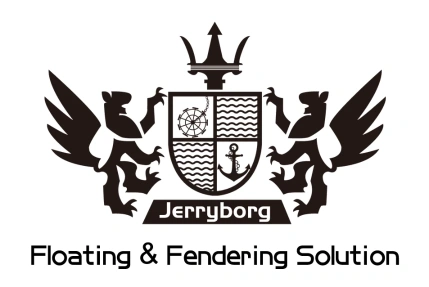
- Yokohama Pneumatic Fenders
- Sling Pneumatic Fenders
- Hydro Pneumatic Fenders
- Marine Rubber Airbags
- Ship Launching Airbags
- Marine Salvage Airbags
- Foam Filled Fender
- Workboat Fendering System
- Portable Foam Fender
- Donut Fender
- Super Cell Fenders
- Super Cone Fenders
- Super Arch Fenders
- Cylindrical Rubber Fenders
- ME Rubber Fenders
- Composite Hose
- Technical Consulting
- Designing & Rapid Prototyping
- Manufacturing
- Testing & Quality Control
- Jerryborg Marine
- Vision & Values
Types, Materials, and Maintenance Tips for Anchor Chains
Anchor chains are crucial in keeping marine vessels in place, even in bad weather conditions. They offer a solid connection between the anchor and the ship. It won’t be wrong to say that they are pivots for the safe and tension-free stay of the vessel in the sea.
No one ignores their importance. However, many people don’t have a basic understanding of these chains of anchors. If you are one of those, fret not! This guide will explain all the ins & outs of anchor chains – from their types to maintenance. So, let’s get started!
What Are Anchor Chains?
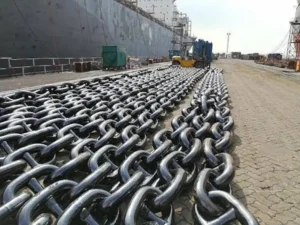
Anchor chains are heavy-duty components of vessels’ anchorage systems that connect the anchor to the ship and ensure the boat stays in one place. The bad weather, wind, or any other external force fails to move the vessel from its position.
When the ship is anchored, it moves slightly along with the wind. It could cause disturbance and instability. However, the anchor chains keep the vessel still even if the winds or tides exert force against the ship. That’s what the anchor chains are all about – keep the boat stable.
Usually, the wind is a prominent issue that captains face when they stop the ship at any location. If the vessel uses rope for connection with the anchor, it would be hard for the ship to stay in one place. Wind will easily slide or drift away.
That drift could result in an accident if more ships stopped together. However, the anchor chains are more vigorous and more powerful. They keep the boat intact in one place by overcoming external forces such as wind, waves, etc.
Importance of Anchor Chain
There are many benefits of using anchor chains over ropes. Many people believe the ropes (used for connecting anchor and ship) are as strong as the chain. That’s a myth – the chains are more powerful and resist external forces such as strong wind, storms, waves, etc.
The ropes may provide connection – but they don’t offer ideal resistance against the external forces. Here are some benefits of using the anchor chains with the vessels:
- Saves ship from colliding with other vessels
- Gives a stable experience even when the wind is out of control
- Keep the boat in one place and avoid its drifting
- Make the retrieval of Anchor very easy and smooth
- Strong to bear the external pressure due to its durable make.
The anchor chains are effective in saving the ships in the harshest weather. For example, when many ships are anchored close together using the combination chains, they remain still or stay with minimal movement.
However, If solid winds (like a storm) cause them to move slightly, the ships’ fenders are so good that they absorb minor shocks and prevent damage. If the wind is gentle to moderate, the ships won’t even move. Thanks to the chains that reduce the movement to very minimal movement.
Types of Anchor Chains
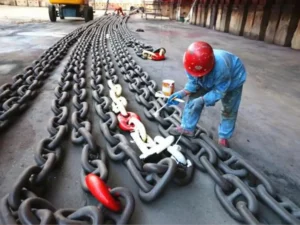
The good thing about the anchor chains is that they are available in various sizes, thicknesses, and types. It allows the users to choose according to the size of the ship and individual preferences. The big vessels use strong, long, and durable heavy-duty chains.
On the flip side, the small ships and boats use lightweight and shorter anchor chains per their needs. Here are some common types of anchor chains:
- Stud Link Chains
- Open Link Chains
- Combination Chains
- Galvanized Anchor Chain
- Short link chains are suitable for small vessels
1- Stud Link Chains
The stud link chains have a protrusion (similar to a stud) that connects or interlocks with the links next to it. In this way, the whole chain is organized. The protrusion or stuff helps in making a durable chain.
You might need clarification about how the stud connects with the link. Each link in this type has a specific shape or opening where the stud easily fits. These continuous connections of links through studs make them super strong and unbendable chains.
It won’t be wrong to say that the stud link chains are the strongest among the other anchor chain types. They are typically used with the bigger ships that carry heavy loads.
2- Open Link Chains
These anchor chains are different from the stud link chain as they don’t have any protrusion or stud. Instead, the links connect without any involvement of stud and make the series of connected loops.
As I said, there is no hard body such as a stud, etc., so these chains are flexible and move quickly. They can be changed into different shapes without any issue. Their flexibility makes them suitable for small ships.
You must remember that this type of anchor chain is not very strong and is less effective in keeping the ship in one place when there is a solid or heavy wind. They are suitable for smaller boats that are not heavy and don’t carry heavy loads.
3- Combination Chains
As the name suggests, this type of anchor chain is a combination of both stud link chains and open link chains. Some portion of these chains consists of the stud, and protrusion. This portion gives chains strength and rigidness.
The other portion of this type consists of connected loops without any stud and offers more flexibility. The good thing is that these chains are usable with smaller ships and bigger vessels, depending on their sizes.
4- Galvanized Anchor Chain
This type of anchor chain is more durable and made to withstand the harshest outdoor conditions. The reason is that the manufacturers apply a zinc coating on these chains, protecting them from rust and other elements.
They are comparatively more expensive as compared to other types. They work just like any other anchor chain mentioned above. Its resistance to corrosion due to the coating makes it stand out. Only those ships use this chain type, which remains in the sea for months.
5- Short Link Chains
These ship anchor chains are slightly different and offer more strength and durability. The reason is that the loops are very close together. The gap between two loops or links is negligible. Unlike open link chains, they are not flexible. They are more rigid, which gives them solidness and strength to bear the pressure and other elements.
Point to Remember: These short link chains typically anchor smaller vessels or boats in one place. They are strong and can even keep the loaded small vessels in one position.
Materials that Make Chains of Anchor
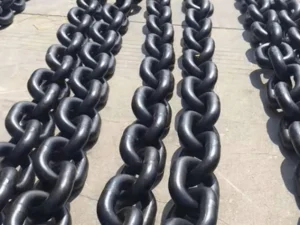
It is noteworthy that different materials are used in making the chains. Those materials differ in terms of their strength, durability, and cost. Here are the most commonly used materials in making anchor chains:
- Galvanized Steel
- Stainless Steel
- High-Tensile Steel
The aluminum material is usually used in inexpensive chains lasting two to three years. This material is lightweight but not very strong. Therefore, it is less prevalent in strong high-end anchor chains.
Galvanized steel is the most widely used material in making anchor chains. Galvanized steel is the one that has a coating of zinc on it. This coating is applied through the galvanization process and imparts corrosion resistance to the steel. The anchor chains made with this material are decently strong.
Stainless steel is the most expensive material and is only used in premium anchor chains. It consists of chromium metal as an alloy that makes it rust-proof. The anchor chains made with this material are super expensive but offer peace of mind regarding durability.
Last, high-tensile steel is also used in making anchor chains. Its strength is in the middle of galvanized steel and stainless steel. Remember that the anchor chains made with different materials also have different prices.
Maintenance Tips for Anchor Chains
In the section above, I have mentioned the lifespan of anchor chains made with different materials. However, the lifespan of the chains can be extended by taking care of them. Similarly, they will get damaged much earlier if you don’t care for them.
Their proper maintenance is critical, making them stay with you for years. In the section below, I will give you some maintenance tips that will help you prolong the life of your anchor chains.
1- Regular Inspections
The first step is to inspect the anchor chains regularly. This inspection includes a complete checkup of every component of anchor chains. For example, you should look at every chain link or loop to ensure it is in good shape.
In the inspection process, if any part of the chain is getting rusty, take immediate steps, remove the rust, and apply lubricant or paint on it. It will help in minimizing the corrosion. If the corroded parts remain unchecked, they will become fragile, ultimately damaging the chain.
2- Figure Broken Link
The chains undergo high pressure and harsh weather conditions. The chances are high that some links or loops may get broken. If you find any link broken, repair it through welding or other methods.
The chain is a continuous connection of loops. If one loop gets broken, the whole series of loops will be affected, and the chain will be broken. You should pay attention to even the tiny cracks to ensure the chain remains in good shape.
3- Lubricate the Chains
Whether the chain has got rust or not, you should apply grease or any other lubricant on the whole chain. Using lubricants protects the chains from corrosion and the rust that could form over time.
If you have bought a new ship anchor chain, start lubricating it from day one. Do it every 2 weeks, and your chains won’t rust. Moreover, if the chain is already rusty, apply a layer of paint on it. It will stop the rust from growing further.
4- Remove & Clean salt
The seawater is salty – and can make the chain rusty easily. Therefore, it is recommended that you remove the salty water from the chains when you arrive from the trip or tour. However, the question is how to remove the salty water from the chains.
You can easily do that by rinsing the freshwater with the help of a water pipe. The freshwater will remove all the salty water present on the chain. You won’t have to rub or apply detergent to remove the salt. Simply rinsing fresh water is good enough.
5- Monitor Anchor Locker
Lockers are the storage area or compartment on the ship. When the anchor chains are not in use, they are placed there. However, it is essential to clean the locker compartment. If there is any moisture, it must be cleaned or removed.
If moisture is present in the locker and you place your chain there, the chances are high that it will get rusty due to the moisture present in the locker. Therefore, monitoring and proper cleaning of the locker is essential.
How to Store Marine Anchor Chain Properly?
The anchor chains can quickly get rust if they make any contact with moisture. Storing them in dry places is essential to avoid their connection with humidity. However, there is no hard, fast rule about where to store.
The vessels come with anchor lockers. These lockers are specialized portions or compartments where the chains are stored. However, cleaning the locker entirely before storing the chains there is mandatory. It will help in removing the moisture.
However, if the chains are not in work, you should find a place that is dry, and is away from the moisture. Store the chains and cover them with a big sheet so the humidity does not reach the anchor chains.
When to Change Your Anchor Chain?
The answer is: It depends! Many factors influence the lifespan and quality of the anchor chains. The regular inspection will help you know whether you should change the anchor chains.
Ideal, change the anchor chain if:
- You notice massive wear and tear (extending to many loops and links)
- You notice severe rust that has weakened the loops
- You weld any broken part, and it gets broken again (indicating the chains’ degradation.
If the chain is 15 years old, consider changing whether it is in good shape. It will ensure the safety of your vessels. However, if the chain is made from stainless steel, you can keep the chain for up to 20 years.
Warning: If you have an aluminum chain, use it for 4 to 5 years. The reason is that this material needs to be stronger and offer the required durability.
Anchor chains are a must-have for ships. Their functionality helps keep the vessel still in the sea, even in the stormy wind. However, it is vital to have a check on them to ensure that they remain with you for the years to come.
In this article, I have explained the types, materials, and maintenance tips for those who don’t know much about the chains and their safety. Hopefully, efforts to put this guide up will prove to be helpful for the masses.
Phone Country
Your Message *
Please prove you are human by selecting the key .

The Anatomy of a Cruise Ship Anchor Chain
While it may seem like a relatively simple piece of equipment, a cruise ship’s anchor is a marvel of modern engineering. When you consider the incredible size and weight of a modern-day cruise ship, you begin to realize what an incredibly difficult task is to ensure they are secured in place while they are in the harbor.
Today, we will take an in-depth look at cruise ship anchor chains. Not only will we break down how they work, but we also explore what they are made from, the various components of the chain, and the incredible engineering that goes into ensuring that they can hold a cruise ship in place.
So, if you are ready to learn everything you need to know about a cruise ship anchor chain, let’s get started!
In This Article:
What is a cruise ship anchor chain.
While it may seem pretty self-explanatory, a cruise ship anchor chain plays a complex and incredibly important role in ensuring the overall safety of a cruise ship voyage. These massive chains need to withstand the incredible forces exerted on the cruise ship’s anchor when the cruise ship is in the harbor.
To withstand the immense pressure generated by holding a heavy cruise ship in place against tides, waves, and ocean currents, the anchor chain and cables need to be immensely strong, and incredibly flexible. The individual chain links look just like any other type of chain, but they are on a massive scale.

Each link in the chain is made from high-grade steel with incredible tensile strength. While the chain size will vary depending on the size and weight of the cruise ship, they are all incredibly large and heavy.
Read Also: What is the Draft of a Ship?
In some cases, the waters the cruise ship traverses can also be a factor when determining how large the anchor chain needs to be. For example, large ships that traverse deep waters with strong currents need a much larger anchor and anchor chain than small boats on shallow water that stay close to the coastline.
What Is the Anatomy of a Cruise Ship Anchor?
The traditional anchor chains of a cruise ship may seem like they have a relatively simple design, but they are made up of many different parts, which all have to be made to an extremely high standard.
Here are the main components of a cruise ship anchor chain:
The Chain Links
The most prominent component of a cruise ship anchor chain is the series of interconnected links that make up the bulk of the chain. These links are massive in scale, and they need to be constructed of high-tensile, high-strength steel.
The chain design allows for the perfect combination of strength and flexibility, which is necessary when holding a heavy anchor in place against the tremendous forces of a large body of water and heavy vessels.

Each link in the chain will look like an elongated oval, or it can be designed to have more of a “D” shape. These two shapes allow the chains to be connected in a way that maintains their strength but can still move smoothly.
All links within the chain are also designed to be the exact same size. They also need to be precisely spaced so that each link has the same freedom to move as the next. If this was not the case, dropping and retrieving the anchor would be much rougher. The chain could also become damaged over time.
The Joining Mechanism
The individual links within the chain are joined together using a detachable mechanism. Basically, this mechanism consists of a connector and an anchor shackle.
Not only does this make it possible to put the chain together, it also makes it possible to remove damaged or corroded links within the chain without completely replacing the entire anchor chain.
Depth Markings
Most cruise ship anchor chains also feature depth markings at evenly spaced-out intervals. These allow crew members to easily determine how much of the chain has been released by the anchor windlass. Typically, these markings are made with bright, scratch-resistant paint; however, they can be made by stamping impressions into the metal.

To learn more about the anchor of a cruise ship, rather than just the chain that connects it to the ship, we recommend reading about how big a cruise ship anchor is . This straightforward guide explains how big these enormous anchors need to be and provides other helpful information on how modern anchors work.
How Much Do Cruise Ship Anchor Chains Weigh?
As mentioned, the anchor weight, chain length, and size of a cruise ship’s chain can vary depending on the weight and dimensions of the cruise ship itself.
That said, the general range for a single link of the anchor’s chain tends to be between 11 lbs (5 kg) to about 290 lbs (130 kg). The longer the chain length, the more it weighs.
Worth Reading: How Much Does a Cruise Ship Weigh?
With individual links weighing so much, the anchor chain’s overall weight can easily be measured in tons. When you think about the weight of a cruise ship and the immense forces sea and ocean water can exert, it only makes sense that the chains need to be incredibly heavy.

What Is a Cruise Ship Anchor Chain Made Of?
Cruise ship anchor chains need to be made from high-strength steel. Steel is the only suitable choice, as it offers the durability and strength required to withstand such immense forces. The high-strength steel alloys used to make these enormous anchor chains are also resistant to corrosion caused by lengthy exposure to saltwater.

To enhance the corrosion resistance of the anchor chain, most are given additional coatings and surface treatments to enhance the anchor chain’s corrosion resistance. Galvanization and various types of specialized coatings are used for the individual links of the anchor chain.
These surface treatments can not only delay corrosion, they can also help prevent scratching as the chain links rub against each other and even the hull.
Why Do Cruise Ship Anchor Chains Need to Be Flexible?
Not only do cruise ship anchor chains need to be heavy, strong, and incredibly durable, they need to be flexible. Flexibility is essential for the following reasons:
The Ability to Move with Currents, Tidal Changes, and Swell
Even when a cruise ship is anchored in a harbor, the anchor chain must be capable of adjusting to fluctuations in water conditions. The tide can change the depth of the water rapidly, so if the chain is not flexible, it would be under much more tension.

This could damage the anchor and the ship itself. By remaining flexible, the anchor chain can also absorb sudden forces caused by large waves and storms.
Noise and Vibration Reduction
A flexible anchor chain creates far less noise when the ship moves. For passengers to have a more comfortable experience while they are on board the ship, flexible anchor chains reduce creaks and other noises that could be disturbing.
Flexibility Makes it Easier to Drop and Retrieve the Anchor
The chain’s flexibility is essential when it comes to dropping and retrieving the anchor. When the anchor is dropped or lifted, the chain flows through a chute on the side of the ship’s bow.

Flexibility Allows the Anchor to Adjust to Differing Seabed Depths and Compositions
As you may know, a seabed in one area can differ in composition from one area to the next. While some are sandy and easy for an anchor to dig into, others are uneven and rocky. By having a strong but flexible anchor chain, the anchor can have a much more stable hold.
Frequently Asked Questions (FAQs)
What is the biggest cruise ship anchor chain in the world.
Currently, the world’s largest anchor chain belongs to the Oasis Class cruise ships owned and operated by Royal Caribbean International. These anchor chains weigh between 130 and 160 tons!
Do cruise ship anchor chains ever break?
Although extremely rare, cruise ship anchor chains have been known to break. Typically, this is due to corrosion and long-standing exposure to salty seawater. Overloading the anchor chain by dropping anchor in rough seas can also cause wear and tear. Eventually, this damage could result in the chain breaking.
Read about an anchor lost after getting stuck near San Juan for an example of how and why large vessels could be forced to cut its anchor loose.
How often are cruise ship anchor chains inspected?
While the exact frequency of inspections will depend on the particular policies of each cruise line, most anchor chains are inspected as part of the cruise ship’s regular inspection and maintenance procedures. This means a visual inspection usually occurs before each voyage.
More in-depth inspections are typically conducted at least once a year. During these inspections, each chain link is checked for signs of damage and corrosion. As you would expect, the frequency and closeness of inspections can increase if the crew suspects that the anchor chain could be damaged.
Final Words
While casual cruise-goers often overlook them, there is an incredible amount of engineering that goes into making and maintaining a cruise ship anchor chain. Not only is the scale of the individual links impressive, but the ability of the chain to withstand immense forces is also truly a marvel of maritime engineering.
Related Posts
Leave a reply cancel reply.
Your email address will not be published. Required fields are marked *

Currency: GBP
- Worldwide Delivery
Mooring Warps and Mooring Lines
- LIROS 3 Strand Polyester Mooring Warps
- LIROS Green Wave 3 Strand Mooring Warps
- LIROS Braided Dockline Mooring Warps
- LIROS Handy Elastic Mooring Warps
- Marlow Blue Ocean Dockline
- LIROS Super Yacht Mooring Polyester Docklines
- 50 metre / 100 metre Rates - Mooring
Mooring Accessories
- Mooring Compensators
Mooring Strops and Bridles
- V shape Mooring Bridles
- Y shape Mooring Bridles
- Small Boat and RIB Mooring Strops
- Mooring Strops
- Mooring Strops with Chain Centre Section
Mooring Assistance
- Coastline Bow Thruster Accessories
- Max Power Bow Thrusters
- Bonomi Mooring Cleats
- Majoni Fenders
- Polyform Norway Fenders
- Ocean Inflatable Fenders
- Dock Fenders
- Fender Ropes and Accessories
Mooring Components
- Mooring Swivels
- Mooring Shackles
- Mooring Cleats and Fairleads
- Mooring Buoys
Mooring Information
- Mooring Warps Size Guide
- Mooring Lines - LIROS Recommended Diameters
- Mooring Rope Selection Guide
- Mooring Warp Length and Configuration Guide
- How to estimate the length of a single line Mooring Strop
- Mooring Ropes - Break Load Chart
- Mooring Compensator Advisory
- Rope Cockling Information
- Fender Size Guide
- Majoni Fender Guide
- Polyform Norway Fender Inflation Guide
Custom Build Instructions
- More Article and Guides >
Anchor Warps Spliced to Chain
- LIROS 3 Strand Nylon Spliced to Chain
- LIROS Anchorplait Nylon Spliced to Chain
Anchor Warps
- 50 / 100 metre Rates - Anchoring
- Drogue Warps and Bridles
- Leaded Anchor Warp
- LIROS 3 Strand Nylon Anchor Warps
- LIROS Anchorplait Nylon Anchor Warps
- Aluminium Anchors
- Galvanised Anchors
- Stainless Steel Anchors
Calibrated Anchor Chain
- Cromox G6 Stainless Steel Chain
- G4 Calibrated Stainless Steel Anchor Chain
- Lofrans Grade 40
- MF DAMS Grade 70
- MF Grade 40
- Titan Grade 43
- Lewmar Windlasses
- Lofrans Windlasses
- Maxwell Windlasses
- Quick Windlasses
- Windlass Accessories and Spares
Chain Snubbers
- Chain Hooks, Grabs and Grippers
- Chain Snubbing Bridles
- Chain Snubbing Strops
Anchoring Accessories
- Anchor Connectors
- Anchor Trip Hooks and Rings
- Anchoring Shackles
- Bow Rollers and Fittings
- Chain and Anchor Stoppers
- Chain Links and Markers
Anchoring Information
- How To Choose A Main Anchor
- Anchoring System Assessment
Anchor Chain and Rope Size Guide
- The Jimmy Green Guide to the Best Anchor Ropes
- What Size Anchor Do I Need?
- Anchor Size Guides
- Anchor Rope Break Load and Chain Compatibility Chart
- How to Choose Your Anchor Chain
- How to Establish the Correct Anchor Chain Calibration?
- Calibrated Anchor Chain - General Information
- Calibrated Anchor Chain Quality Control
- Calibrated Chain - Break Load and Weight Guide
- Galvanising - Managing Performance and Endurance expectation
- Can Galvanised Steel be used with Stainless Steel?
- Windlass Selection Guide
- More Articles and Guides
Stainless Steel Wire Rigging and Wire Rope
- 1x19 Wire Rigging
- 50 / 100 metre Rates - Wire and Fibre
- 7x19 Flexible Wire Rigging
- Compacted Strand Wire Rigging
Dinghy Rigging
- Dinghy Rigging Fittings
- Fibre Dinghy Rigging
- Stainless Steel Dinghy Rigging
- Wind Indicators
Fibre Rigging
- DynIce Dux Fibre Rigging
- LIROS D-Pro Static Rigging
- LIROS D-Pro-XTR Fibre Rigging
- Marlow Excel D12 MAX 78 Rigging
- Marlow M-Rig Max Rigging
Wire Terminals
- Cones, Formers, Wedges, Ferrules, Rigging Spares
- Hi-Mod Swageless Terminals
- Sta-Lok Swageless Terminals
- Swage Terminals
- Headsail Reefing Furlers
- Plastimo Jib Reefing
- Selden Furlex Reefing Gear
Furling Systems
- Anti-torsion Stays
- Straight Luff Furlers
- Top Down Furlers
Guard Wires, Rails and Fittings
- Guard Rail Fittings
- Guard Rails in Fibre and Webbing
- Guard Wire Accessories
- Guard Wires
Wire Rigging Fittings
- Babystay and Backstay Adjustment
- Terminal Backing Plates and Coquilles
- Turnbuckles and Rigging Screws
Rigging Accessories
- Rigging Chafe Protection
Standing Rigging Assistance
- More Articles and Guides >
- Cruising Halyards
- Performance Halyards
- Dinghy Halyards
Rigging Shackles
- Captive and Key Pin Shackles
- hamma™ Snap Shackles
- Soft Shackles
- Standard Snap Shackles
- Wichard Snap Shackles
Classic Ropes
- Classic Control Lines
- Classic Halyards
- Classic Sheets
- Cruising Sheets
- Performance Sheets
- Dinghy Sheets
Sail Handling
- Boom Brakes and Preventers
- Lazy Jack Sail Handling
- Rodkickers, Boomstruts
- Sail Handling Accessories
50 / 100 metre Rates - Running Rigging
- 50 / 100 metres - Cruising Ropes
- 50 / 100 metres - Dinghy Ropes
- 50 / 100 metres - Performance Ropes
Control Lines
- Cruising Control Lines
- Performance Control Lines
- Dinghy Control Lines
- Continuous Control Lines
Running Rigging Accessories
- Anti-Chafe Rope Protection
- Lashing, Lacing and Lanyards
- Mast and Boom Fittings
- Rope Stowage
- Sail Ties and Sail Stowage
- Shock Cord and Fittings
- LIROS Ropes
- Marlow Ropes
Running Rigging Resources
- Running Rigging Rope Fibres and Construction Explained
- How to Select a Suitable Halyard Rope
- How to select Sheets and Guys
- Dyneema Rope - Cruising and Racing Comparison
- Dinghy Rope Selection Guide
- Rope Measurement Information
- Running Rigging - LIROS Recommended Line Diameters
- Running Rigging Break Load Comparison Chart
- Colour Coding for Running Rigging
- Selecting the right type of block, plain, roller or ball bearing
- Replacing your Furling Line
- Recycling Rope
- Running Rigging Glossary
Custom Build Instructions for Sheets, Halyards, Control Lines
Plain bearing blocks.
- Barton Blocks
- Harken Element Blocks
- Low Friction Rings
- Selden Yacht Blocks
- Wichard MXEvo Blocks
- Wooden Yacht Blocks
Control Systems
- Ratchet Blocks
- Stanchion Blocks and Fairleads
- Snatch Blocks
- Genoa Car Systems
- Traveller Systems
- Block and Tackle Purchase Systems
Ball Bearing Blocks
- Harken Ball Bearing Blocks
- Selden Ball Bearing Blocks
Roller Bearing Blocks
- Harken Black Magic Blocks
- Selden Roller Bearing Blocks
Deck Fittings
- Bungs and Hatches
- Bushes and Fairleads
- Deck Eyes, Straps and Hooks
- Pad Eyes, U Bolts and Eye Bolts
- Pintles and Gudgeons
- Tiller Extensions and Joints
- Harken Winches, Handles and Accessories
- Barton Winches, Snubbers and Winchers
- Lewmar Winches, Handles and Accessories
- Winch Servicing and Accessories
Clutches and Organisers
- Barton Clutches and Organisers
- Spinlock Clutches and Organisers
- Lewmar Clutches
- Harken Ball Bearing Cam Cleats
- Barton K Cam Cleats
Deck Hardware Support
- Blocks and Pulleys Selection Guide
- Barton High Load Eyes
- Dyneema Low Friction Rings Comparison
- Seldén Block Selection Guide
- Barton Track Selection Guide
- Barton Traveller Systems Selection Guide
- Harken Winch Selection Guide
- Karver Winch Comparison Chart
- Lewmar Winch Selection Guide - PDF
- Winch Servicing Guide
Sailing Flags
- Courtesy Flags
- Red Ensigns
- Blue Ensigns
- Signal Code Flags
- Flag Staffs and Sockets
- Flag Accessories
- Flag Making and Repair
- Webbing only
- Webbing Soft Shackles
- Webbing Restraint Straps
- Webbing Sail Ties
- Sail Sewing
- PROtect Tape
Fixings and Fastenings
- Screws, Bolts, Nuts and Washers
- Monel Rivets
Hatches and Portlights
- Lewmar Hatches
- Lewmar Portlights
- Fids and Tools
- Knives and Scissors
General Chandlery
- Carabiners and Hooks
- Antifouling
Chandlery Information
Flag articles.
- Flag Size Guide
- Bending and Hoisting Methods for Sailing Flags
- Courtesy Flags Identification, Labelling and Stowage
- Courtesy Flag Map
- Flag Etiquette and Information
- Glossary of Flag Terms and Parts of a Flag
- Making and Repairing Flags
- Signal Code Message Definitions
Other Chandlery Articles
- Anchorplait Splicing Instructions
- Antifoul Coverage Information
- Hawk Wind Indicator Selection Guide
- Petersen Stainless - Upset Forging Information
- Speedy Stitcher Sewing Instructions
- Thimble Dimensions and Compatible Shackles
Jackstays and Jacklines
- Webbing Jackstays
- Stainless Steel Wire Jackstay Lifelines
- Fibre Jackstay Lifelines
- Jackstay and Lifeline Accessories
Lifejackets
- Children's Life Jackets
- Crewsaver Lifejackets
- Seago Lifejackets
- Spinlock Lifejackets
Floating Rope
- LIROS Multifilament White Polypropylene
- LIROS Yellow Floating Safety Rope
Guard Wires, Guardrails and Guardrail Webbing
Lifejacket accessories.
- Lifejacket Lights
- Lifejacket Rearming Kits
- Lifejacket Spray Hoods
- Safety Lines
Seago Liferafts
- Grab Bag Contents
- Grab Bags and Polybottles
- Liferaft Accessories
- Danbuoy Accessories
- Jimmy Green Danbuoys
- Jonbuoy Danbuoys
- Seago Danbuoys
Overboard Recovery
- Lifebuoy Accessories
- Purchase Systems
- Slings and Throwlines
Safety Accessories
- Fire Safety
- Sea Anchors and Drogues
Safety Resources
- Guard Wires - Inspection and Replacement Guidance
- Guard Wire Stud Terminal Dimensions
- Webbing Jackstays Guidance
- Webbing Jackstays - Custom Build Instructions
- Danbuoy Selection Guide
- Danbuoy Instructions - 3 piece Telescopic - Offshore
- Liferaft Selection Guide
- Liferaft Servicing
- Man Overboard Equipment - World Sailing Compliance
- Marine Safety Information Links
- Safety Marine Equipment List for UK Pleasure Vessels
Sailing Clothing
- Sailing Jackets
- Sailing Trousers
- Thermal Layers
Leisure Wear
- Accessories
- Rain Jackets
- Sweatshirts
Sailing Footwear
- Dinghy Boots and Shoes
- Sailing Wellies
Leisure Footwear
- Walking Shoes
Sailing Accessories
- Sailing Bags and Holdalls
- Sailing Gloves
- Sailing Kneepads
Clothing Clearance
Clothing guide.
- What to wear Sailing
- Helly Hansen Mens Jacket and Pant Size Guide
- Helly Hansen Womens Sailing Jacket and Pant Size Guide
- Lazy Jacks Mens and Womens Size Charts
- Musto Men's and Women's Size Charts
- Old Guys Rule Size Guide
- Sailing Gloves Size Guides
- Weird Fish Clothing Size Charts
The Jimmy Green Clothing Store
Lower Fore St, Beer, East Devon, EX12 3EG
- Adria Bandiere
- Anchor Marine
- Anchor Right
- August Race
- Barton Marine
- Blue Performance
- Brierley Lifting
- Brook International
- Brookes & Adams
- Captain Currey
- Chaineries Limousines
- Coastline Technology
- Colligo Marine
- Cyclops Marine
- Douglas Marine
- Ecoworks Marine
- Exposure OLAS
- Fire Safety Stick
- Fortress Marine Anchors
- Hawk Marine Products
- Helly Hansen
- International
- Jimmy Green Marine
- Maillon Rapide
- Mantus Marine
- Marling Leek
- Meridian Zero
- MF Catenificio
- Ocean Fenders
- Ocean Safety
- Old Guys Rule
- Petersen Stainless
- Polyform Norway
- PSP Marine Tape
- Sidermarine
- Stewart Manufacturing Inc
- Team McLube
- Technical Marine Supplies
- Titan Marine (CMP)
- Ultramarine
- Waterline Design
- William Hackett
Clearance August Race Boat Cleaning Kit £26.00
Clearance LIROS Racer Dyneema £55.08
Clearance Folding Stock Anchor £123.25
Clearance LIROS Herkules £0.00
Clearance Barton Size 0 Ball Bearing Blocks - 5mm £10.13
Clearance Marlow Blue Ocean® Doublebraid £18.48
Mooring Clearance
Anchoring clearance, standing rigging clearance, running rigging clearance, deck hardware clearance, chandlery clearance, safety clearance, selection process for determining the right size for your main anchor chain and rope.
- What Size Anchor Chain do I need?
- What Size Anchor Rope is compatible with my chain?
- How much Anchor Chain do I need?
- How much Anchor Rope do I need?
Select your Anchor Chain and compatible Anchor Rope size
- Find the column below that best represents your Boat Length Overall.
- Compare your displacement with the tonnage listed.
- If the displacement is greater than displayed in your column in the table, or the yacht is a multihull, consider moving across to the next column to increase the diameter.
- Consider the worst-case scenario for your anticipated Anchoring - this will dictate whether you go for the minimum required or the ocean cruising approach
- Select your Anchor Chain size first. The guide indicates the compatible rope diameter.
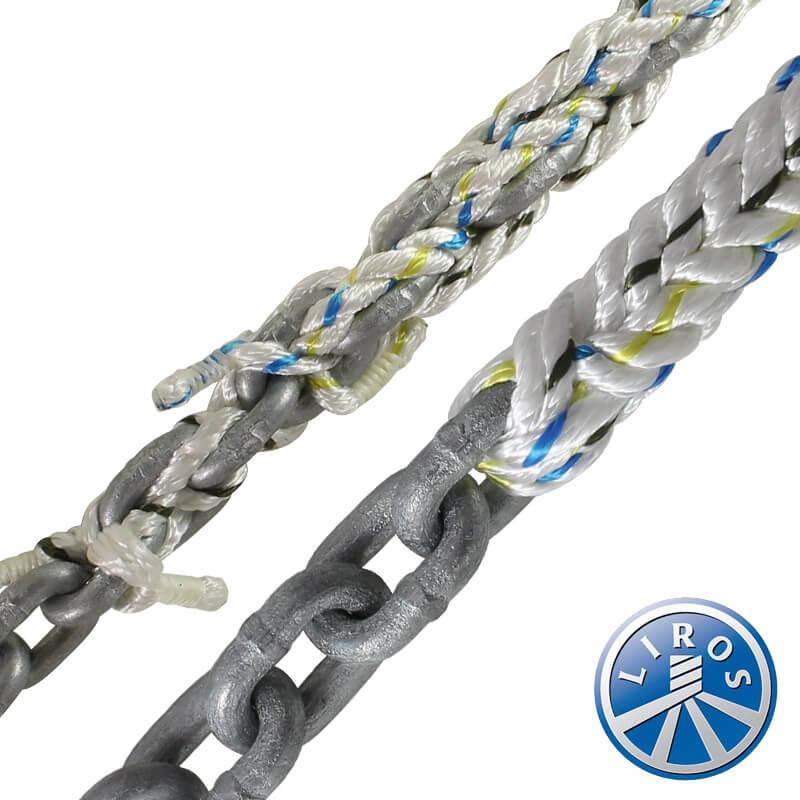
N.B. This table is a guide with columns based on the following:
- Top Quality Grade 40 Anchor Chain
- Top Quality LIROS Rope
- LIROS recommendation
- Jimmy Green experience and customer feedback
Anchor Chain Size Rule of Thumb
There is an old rule of thumb that dates back many years, which states a requirement of 1/8" chain diameter for every 9 or 10 feet of boat length - with approximate metric conversions: e.g. 1/4" now available as 6mm DIN766 chain would be up to 20 or 23 feet Yacht LOA, 7mm DIN766 chain would be up to 23 or 27 feet Yacht LOA, 5/16" now available as 8mm DIN766 would be up to 27 or 31 feet Yacht LOA, 3/8" now available as 10mm DIN766 and 10mm ISO4565 would be up to 34 or 39 feet Yacht LOA.
5/16" US Specification (8.7mm) chain is also available from Jimmy Green Marine, and the rule of thumb would be up to 29 or 34 feet Yacht LOA.
This rule of thumb is pretty close to the Jimmy Green Anchor Chain Size Guide, but it is probably based on Grade 30 chain because Grade 40 is a relatively recent advance for yachting anchor chain. Although modern yachts are generally designed and built with lighter, technologically advanced materials, they are often kitted out with a lot more equipment to add the weight back on, and the current trend is towards heavier anchors with much higher holding power, which will inevitably lead to higher loads on the anchor rode.
Grade 40 Calibrated Anchor Chain is 25%+ stronger than Grade 30 Anchor Chain providing extra assurance when conditions worsen and your yacht is caught on a lee shore.
An Anchor Rode comprises all parts of your anchoring system - anchor chain, anchor rope, and all the connections - the breaking load of all the components should be roughly equal - investing in expensive rope and chain will be undermined by an under-specified anchor to chain connection.
Decision-making factors for sizing your anchor chain and anchor warp:.
- Displacement to Length ratio, i.e. is your yacht relatively light or heavy for her length?
- Monohull or Multihull - catamarans may be subject to more significant anchoring stresses and strains
- Anticipated anchoring conditions, e.g. depth, seabed holding characteristics, the length of fetch and degree of exposure to prevailing winds.
- Your overall assessment of the risks involved (worst-case scenario).
- Weight and design of your bower (main anchor), taking into account the specification of your secondary anchoring system.
An Anchoring System includes every part of the anchor rode from the anchor to the bitter end: anchor, chain, warp, and all the individual means of joining it all together, e.g. connectors; swivels; shackles; splicing.
All the individual parts need to be comparable in strength. The Anchor System is only as strong as the weakest link. The increased holding power of modern anchors means that all the joining elements are subjected to higher loads than ever before.
Grade 40 Calibrated Anchor Chain Splicing Compatibility with Anchorplait Nylon Rope Diameter:
Compatibility rests on two main factors:
- Break Load Comparison
- Physical limitations of the Rope to Chain Splice, i.e. the largest rope that will splice into the chain links, sit comfortably and articulate satisfactorily
6mm Grade 40 Chain c 2300kg MBL Compatible = 10mm Anchorplait Nylon, LIROS MBL 2400kg
7mm Grade 40 Chain c 3100kg MBL ~ Downsize = 10mm Anchorplait Nylon, LIROS MBL 2400kg or Compatible = 12mm Anchorplait Nylon, LIROS MBL 3300kg
8mm Grade 40 Chain c 4000-4400kg MBL ~ Downsize = 12mm Anchorplait Nylon, LIROS MBL 3300kg or Compatible = 14mm Anchorplait Nylon, LIROS MBL 4400kg or Largest Possible for satisfactory splicing = 16mm Anchorplait Nylon, LIROS MBL 5600kg
10mm Grade 40 Chain c 6400-7200kg MBL ~ Slight Downsize = 16mm Anchorplait Nylon LIROS MBL 5600kg or Compatible = 18mm Anchorplait Nylon, LIROS MBL 7000kg
12mm Grade 40 Chain c 9100-9700kg MBL ~ Slight Downsize = 20mm Anchorplait Nylon LIROS MBL 8400kg or Upsize = 24mm Anchorplait Nylon, LIROS MBL 11800kg
Grade 70 chain is generally an all-chain solution because the largest possible rope diameter physically spliceable to the chain won't have the same break load capability.
Yacht owners frequently ask the Jimmy Green Rigging Team to splice 16mm Anchorplait Nylon into 8mm Grade 70 DIN766 Calibrated Anchor Chain. We are happy to do so on request, but the finished splice in 16mm is on the limit of articulation, and the splice will need regular close inspection.
N.B. LIROS 3 Strand Nylon has the same break load characteristics and splicing limits as Anchorplait, so compatibility will be exactly as described above. Anchorplait is more expensive but has valuable additional benefits: Flexibility, balanced Octoplait construction, behaves and flakes like chain, by far the best anchor rope for self-stowing naturally in the chain locker and emerging free of tangles and kinks when re-deployed.
How much Anchor Chain and Rope do I need?
The generally accepted guide for the length of your anchor rode – An Anchor Rode encompasses Chain, Rope and all the shackles and connectors – is 8 metres of rode for every metre of depth you will be anchoring in. This is referred to as the scope, in this case, 8:1.
This works for the middle range of anchorage depths but starts to look a little out of kilter as you approach either end of the scale e.g.
- 8:1 in 3 meters of water equates to 24 metres total rode length, which is possibly not a satisfactory anchoring solution in anything but benign weather
- 8:1 in 5 metres of water equates to 40 metres total rode length, which may be adequate for Inshore and Coastal hopping
- 8:1 in 20 metres of water would be 160 metres of total anchor rode, which would seem a little over the top!
However, Scope 8:1 for 10 metres of depth = 80 metres total chain and warp and this makes a good benchmark starting point for your final decision. For extended Offshore and Ocean cruising, consider increasing the scope to 10:1 on all chain or even 12:1 on a chain/rope combination. This particularly applies to anchorages around some Pacific islands.
Budget and the extra weight in the bow (chain locker) form natural restraints on your final decision regarding the total length of chain and warp.
Your anchor rode is your primary safeguard when anchoring overnight in a foreign anchorage so aim for the longest and best affordable option, bearing in mind the detrimental effect on your yacht’s performance if you overload the bow with too much weight.
Select from
- All Chain: Calibrated Anchor Chain
- Rope / Chain Combination: Anchor Warps Spliced to Chain
- Rope with additional separate chain: Anchor Warps Calibrated Anchor Chain
Do I need an Anchor Chain, Anchor Rope or a combination of Both?
For those blessed with a good windlass, all chain is the popular choice, limited only by your budget, the size of the chain locker and the disadvantage of too much weight in the bow when underway. Fifty metres used to be the norm, but 80-120 metres is much more prevalent today.
Where weight is a limiting factor, a balanced chain/warp combination may be the optimum solution, e.g. 50 metres of chain spliced to 50 metres of rope. The balance can be adjusted proportionally but shouldn’t feature less than 30 metres of chain. The rope component should be as strong as the chain and as stretchy as possible to absorb the shock loads endured in big seas. The rope to chain splice will restrict the maximum anchor rope diameter; see the compatibility guide above.
For anchor retrieval with no power or mechanical advantage, a disproportionate warp/chain combination may be advisable for retrieving the anchor, chain and warp by hand - Consider an extended length of stretchy warp with a relatively short piece of chain to ground the anchor and negate the abrasive effects of the seabed, e.g. anything from 50 up to 100 metres spliced to 5 or 10 metres of chain. Consider increasing the chain length and reducing the rope length if you or your crew can physically manage the extra weight.
The overall length of your rode, whether all chain or a combination, should reflect the depth and type of anchorages you will encounter and the degree of risk associated with your anchoring intentions, i.e. your reliance on ground tackle as a primary yacht safety factor.
An anchor rode comprising all chain with no additional rope will require a snubbing strop or bridle.
This will help prevent the anchor chain from coming up short with a jolt which may have worrying results:
- Jerking the anchor from the set position in the seabed.
- Delivering a damaging shock load to the chain or the deck strongpoint fitting to which the chain is attached if the anchor doesn’t budge.
A combination Chain/Rope Anchor Rode is the optimal arrangement provided the scope of the chain is more than adequate for anticipated anchorage depths and weather conditions.
The extra length of the rope extension will not only increase the scope but also provide valuable shock absorbing capability if conditions seriously worsen.
A second (kedge) anchoring system is typically recommended in addition to the full specification primary (bower) system.
A kedge specification can vary widely according to cruising intentions - from a full specification second storm anchoring system to a traditional kedge, e.g. lunch hook or stern anchor. According to the seabed, different anchors have varying degrees of holding power, so the option of a geometrically different anchor may be advantageous if the primary system is not holding. Traditionally, a second anchor system has less chain, more rope and a lighter stowable anchor - making the whole system physically easier to store on board and deploy when required.
Jimmy Green Marine offer a comprehensive range of solutions from leading brands for all your anchor rode requirements.
The Jimmy Green Rigging Sales Team are always on hand to help you with your selection process.
Shop for Anchor Warps Spliced to Chain
Give feedback on this article

Chain Sizing
Rode length/ scope.
The ratio of the length of rode to the water depth is known as the scope. Anchoring with sufficient scope brings the direction of strain close to parallel with the seabed. In general the longer your rode the better. 10:1 Scope is preferable in windy conditions. It’s recommended that an average cruising boat carries at least 300 feet of rode, which will allow for 10:1 scope in 25 feet of water (5 feet allotted for free-board height). This will ensure that most of the time you can anchor with 10:1 Scope.
It is generally accepted that in a storm situation we strive to put out 10:1 scope, but why? See how anchors maximum holding power varies with changing scope.
Many cruisers find that 10:1 scope is a nice compromise between rode length and maximizing anchors holding power.
Rode Strength:
ABYC data was developed in 1950s to indicate the strength required of an anchor, capstan, rode or a cleat. Tom Hale a past ABYC technical director said it is not unreasonable to apply the figures in the chart above to the entire anchor system.
After comparing this data in this table to work that has been done since we come to the conclusion that the values presented here represent loads expected on the anchor rode if anchored on chain only without the use of the snubbing system. Further using a line rode or and adequately designed snubber you can reduce the loads by a factor of 3, by eliminating the shock loads. This is an argument for why its so important to use a snubber but when sizing anchor rode or your anchor, it is important to consider loads as stated in the table. The reason is that we can not rely on the integrity of a snubber in a storm. Should the snubber fail, the integrity of the rode should be sufficient to handle the loads without the snubber.
The ABYC Horizontal Working Load (lbs) Table
When sizing your gear you should make sure that the Working Limit Load (WLL) of your rode is higher than the loads expected in a storm. Sizing the working rode for a hurricane might not be practical but sustained winds greater than 40 kts are commonly encountered by cruising vessels on anchor. Sizing for such conditions is a reasonable way to approach the problem and is the basis for our recommendations.
WLL: Working Limit Load /Safe Working Load (SWL)/Normal Working Load (NWL) is the load that the rode can safely support without fear of breaking. Usually marked on the equipment by the manufacturer and it is often 1/3 to 1/4 of the Minimum Breaking Strength (MBS) for chain and 1/10 to 1/12 the Minimum Breaking Strength (MBS) for rope.
Manufacturers:
This is the list of the common chain manufacturers that sell in usa.
ACCO/PEERLESS
WESTMARINE (private labeled)
CERTIFYING BODIES: (the Standards from different certifying bodies some time overlap)
- NACM – National Association of Chain Manufacturers (US Chain manufacturers make chain to NACM specs)
- ISO – International Standards Organization
Chain Link Geometry:

- Proof Coil Grade 30: Proof coil chain is a general purpose chain, frequently used for light duty tow chains, tie down chains and logging chains. Links are longer, thus the chain is lighter than BBB and G4 dimensioned chain for equivalent length.
- BBB: Short, compact links. The short link makes the chain more flexible and ideally suited for a windlass, usually made in Grade 30 only.
- G4 Dimensioned chain : Most common specification for Hi Test Chain sold in the USA.
- DIN 766 (Common Standard for Metric Chain)
- ISO4565 G70 Chain
- Grade L Chain (AS2321-2006) Grade 30 Chain specified for the Australian Market
- Stainless Steel Chain : Imported and US Made stainless steel chain is available made to various NACM, ISO, DIN specifications . Stainless Chain is available in several grades: 304, 316, Duplex. Duplex stainless steel chain is the strongest option available in Grade 60 and is more corrosion resistant than 304, 316 stainless steel and is ussually made to G4 and DIN776 dimensional standards.
Chain Grade:
National Association of Chain Manufacturers The chain grade is based on the nominal stress in the link at the design breaking force strength. (It is calculated by taking the minimum breaking force load and dividing by two times the nominal cross sectional area of the link.) Another words the higher the grade the stronger the chain. Chains Grade 80 and above are considered to be ok for overhead lifting. These higher grades are usually not easily accessible. Most common grades for anchor chain are Grade 30 (BBB & Proof Coil) & Grade 40 (HT)
Chain Strength Table:
Note: the WLL (Wroking load) for chain is usually defined ¼ of the UBS (Ultimate Breaking Strength) expressed in pounds for all chain types except G4, Grade 40 HTChain has the WLL defined as 1/3 of the UBS. It is unclear why the WLL definition is different for Grade 40 chain. To make the comparison easier we defined Working Load below for all chain as 1/4 of the UBS.
Main focus should be placed on sizing the chain for the expected loads. Using higher grades of chain can offer some weight saving however. For example, 300 feet of 3/8 BBB weighs 468 lbs vs. 300 feet of 5/16 G4 HT which weighs 310 lbs and has higher strength. Thus if taking 160 lbs off the bow is considered important, using higher grade chain definitely has its advantages. Another issue is matching the gypsy on the windlass to the chain size and type. A windlass gypsy designed for 5/16″ High Test chain will not work on 5/16″ BBB, which has shorter, more compact links. Many windlasses have a selection of gypsies, which can be Special Ordered to fit the rode on your boat. Often availability and the cost of the right gypsy enter the calculus of which chain size and type is right for you. It is important to remember not to compromise on the strength of the system when making such decisions.
Chain Sizing Recommendations:
How much chain:.
It’s recommended that an average cruising boat carries at least 300 feet of chain, which will allow for 10:1 scope in 25 feet of water (5 feet allotted for freeboard height). This set up will ensure that most of the time you are anchored on chain and reduce the likelyhood of rode failure.
Review Cart
No products in the cart.
Please log in to access the affiliate area.
Username or Email Address
Remember Me
- Project Management – Dry Docking and Repairs
- Ship Services
- Marine CAD Services
- Marine IT Services
- Academic services
- MEO Class 1
- MEO Class 2
- MEO Class 4
- ASM / Masters
- Class IV Level
- Academic Papers
- Year/Month Sets
- Shirts & Trousers
- Deck Officers
- Engineer Officers
- Coveralls / Boiler Suits
- Marine Uniform Shirts & Trousers
- Epaulettes for Marine Deck Officers
- Epaulettes for Marine Engineer Officers
- Marine Belts | Peak cap | Accessories
- Marine Accessories
- Marine Engineering – General
- Marine Engineering – Motor
- Marine Electro Technology
- Ship Safety & Naval Architecture
- MMD Procedures
- Merchant Navy Courses
Ship Anchor – Complete Information
- 20 Jan 2021
Introduction
>> The anchoring equipment of a ship comprises the anchor, anchor chain and the windlass. The anchoring equipment as required herewith is intended for temporary mooring of a ship within a harbour or sheltered area when the ship is awaiting berth, tide etc.
>> The modern ship’s anchor is called ‘Stock-less Bower anchor’ and is developed from the primitive “ stock Anchor”. Both these anchors are illustrated as under.
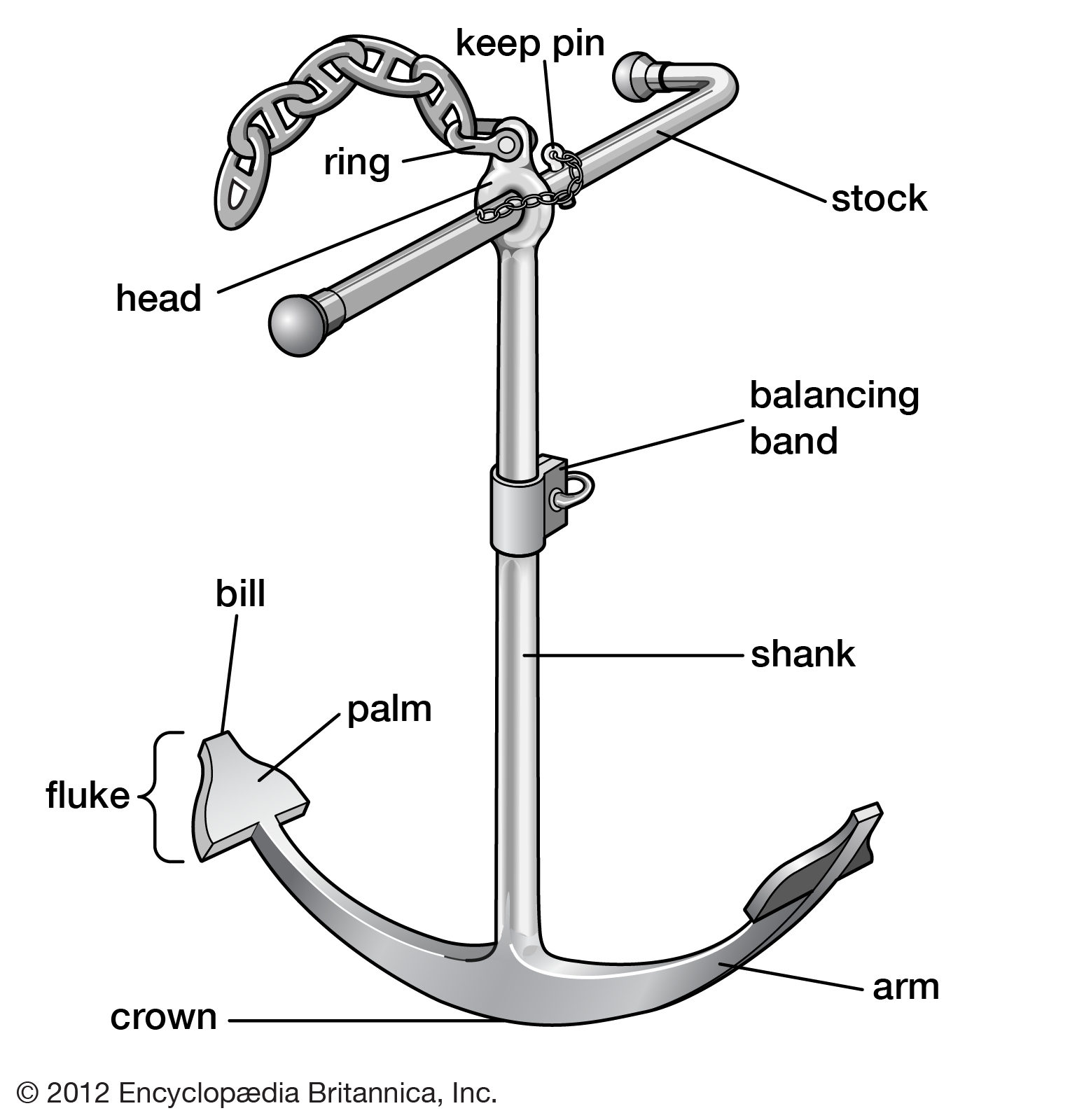
Ship anchor old type. Stock Anchor. Pic credit : Brittannica
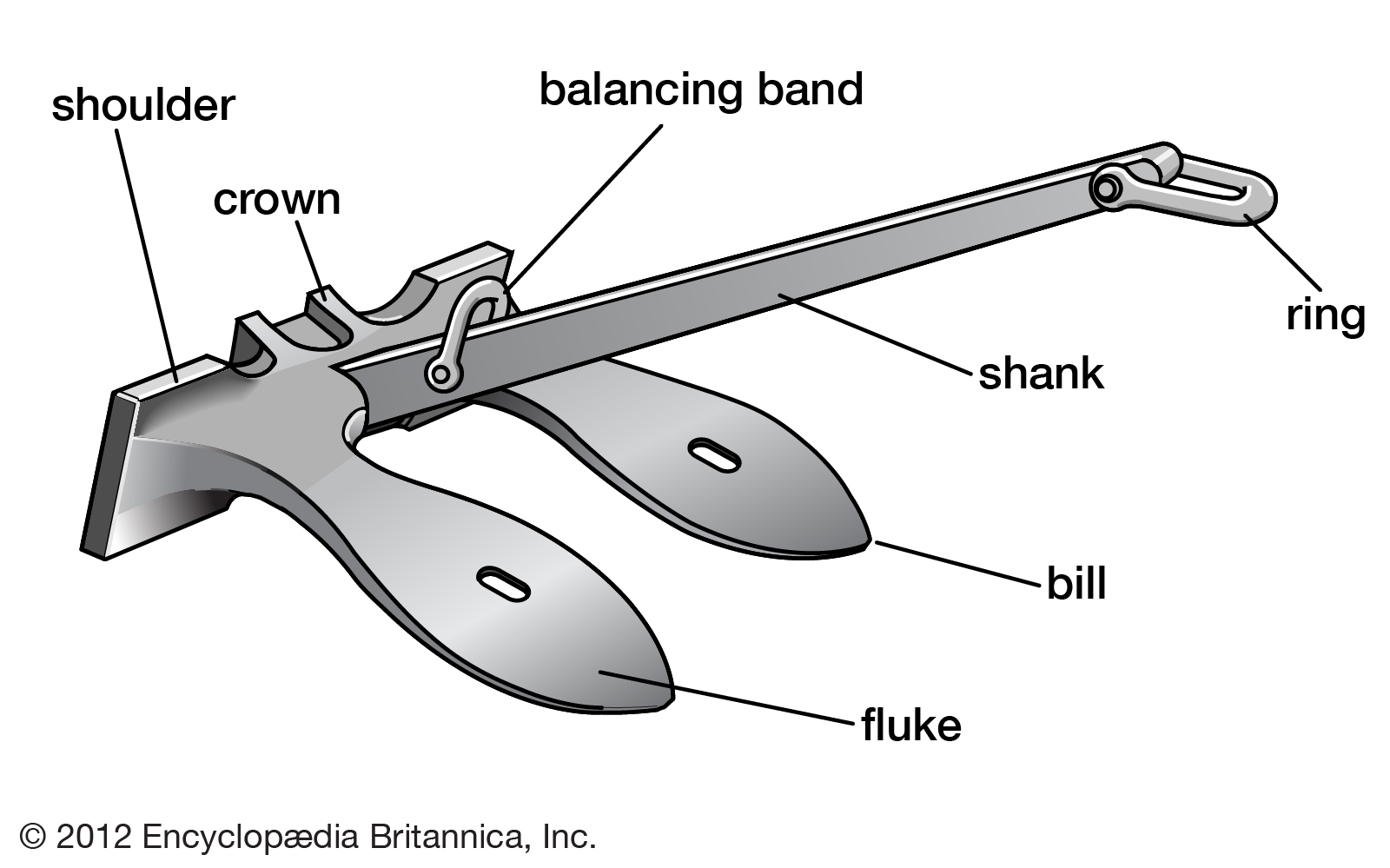
Stockless ship anchor. Pic credit : Brittannica
>> The modern ‘Bower stockless anchor’ is in existence since the days of steam propulsion and has been developed to suit the stowing arrangement in the hawse pipe of the ship and with a lower holding strength than the stock anchor.
>> The modern stockless anchor has a holding strength of five times its weight in Newtons, whereas the ancient or primitive stock anchor has a holding strength of ten times its weight in Newtons.
>> The reason for this requirement of lightness is that the anchor has to be hauled quickly (within 30 minutes maximum ), when the weather deteriorates during anchor stay and the ship has to haul up the anchor and proceed to sea. A stock anchor will take longer time to haul up and therefore endanger the safety of the ship.
>> In the worst condition it can lead to capsizing of the ship especially if it is in light condition or in the best condition drag anchor and run aground ashore. Whereas in a sailing ship the ship is normally anchored deep inside the natural harbour where the severity of the sea condition does not reach. It should be understood that the greater the holding force , the larger time required to haul up the anchor. The forces acting on a ship riding anchor is described as under.
Forces acting on the ship whilst riding anchor:-
>> The chain connecting the anchor to the ship is of heavy construction with a breaking strength much higher than required . The chain links are made heavy so that when the anchor is dropped with the attached chain and the ship is in stand still condition, the catenary so formed is deep and almost vertical.
The shape of the curve formed by the chain is called a catenary. This curve is like a parabola but has a different mathematical formula when compared with the parabola. It is a physical curve caused by a hanging chain supported at the ends and the total depth of the curve from the end supports is directly proportional to the unit length of the chain.
>> The Bower anchor is made of two parts ,
1. The head (crown) with shoulder and the flukes folded inwards
2. The shank .
>> Both these parts are fitted together by a heavy and large pin fitted tightly on the head but loosely in the shank hole. The head has sufficient internal space to allow free movement of the shank to turn through about 15 0 on either side of the vertical, so that when it hits the ground it is not stable and can fall on either side of the vertical position.
>> When the anchor is released at the time of anchoring it drops by gravity taking along with it the chain. The anchor head being curved and not flat causes the anchor to fall on either side with the shaft resting on the ground and taking a posture like a plough entering the ground and thus gets fixed in the earth or ground. The details of the forces acting on the ship when riding anchor are given in the sketch shown as under.
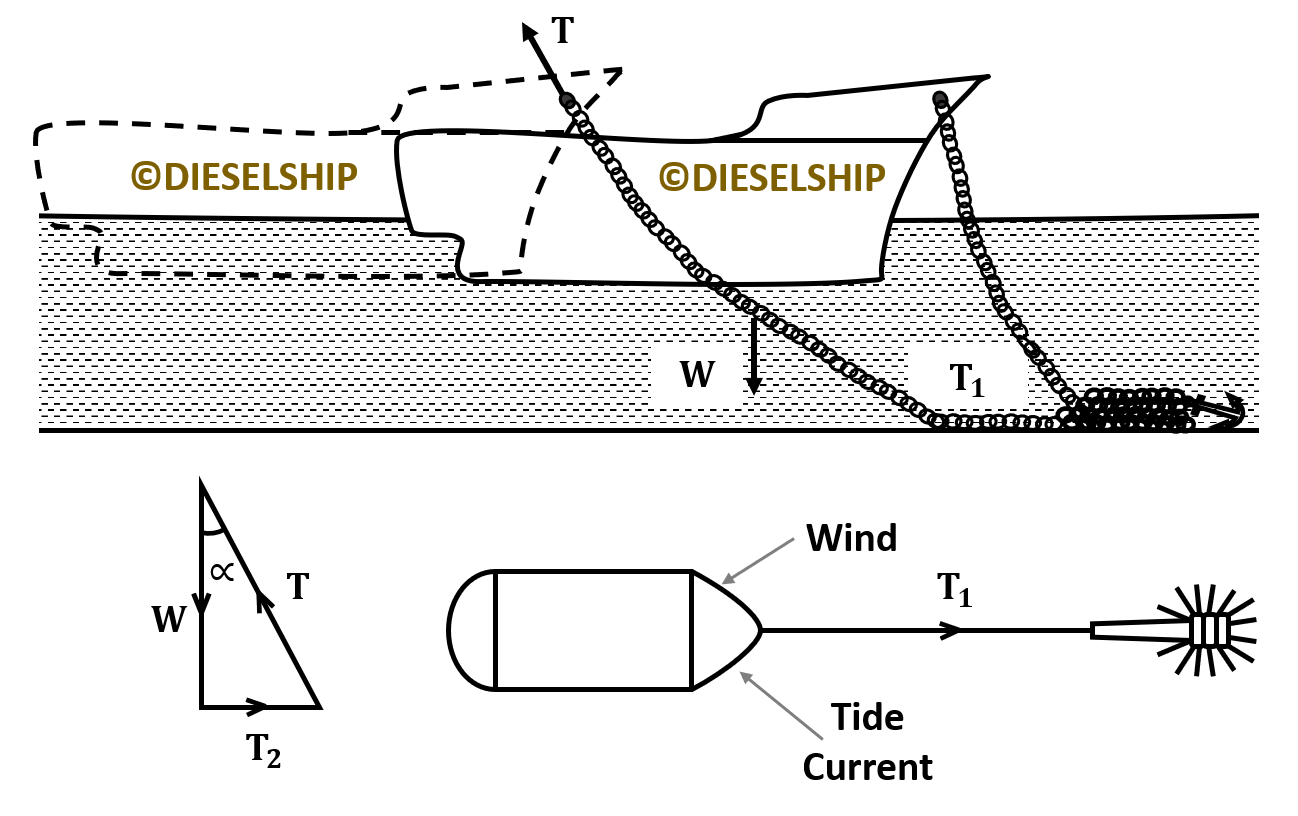
T= the total tension acting at the hawse pipe exit and is resisted by the ship’s buoyancy (has a very small trimming effect at forward) .
W = the weight of the length of chain forming the catenary ( length of chain from ground at point where the chain makes contact with the ground up to the hawse pipe mouth).
T 1 = The horizontal tension at ground.
>> This horizontal tension T 1 is the vector sum of the current and wind force. This is how the ship is moored and drift prevented. Hence the anchor resists the wind and tide. The ship is always facing the combined wind and tide in normal times.
>> When a medium sized ship anchors about 5 shackles are paid out. Assuming that the ship has anchored at slack water, there may be only 2 shackles forming the catenary.
A shackle is a unit of length and equal to 15 fathoms or 90 feet and is the standard length of a chain .
>> In this condition the weight of 2 shackles is able to moor the ship. As the tide builds up the ship drifts aft picking up about two more shackles making the length of the catenary now to 4 shackles. In this condition the weight of the anchor together with the weight of one shackle of chain is greater than the horizontal component of the weight of the 4 shackles of chain forming the catenary . This is explained mathematically as follows;
T 1 = W Tan
>> Where W is the vertical angle . For all angles below 45 0 ‘ W’ will be greater than T 1 and hence the ship has a reserve force or strength of the weight of the anchor and one chain shackle in this condition.
>> Now if for some reason the weather deteriorates and both the current and wind force increase the remaining shackle will be lifted out of the water and further deterioration in the weather may make the catenary degenerate into a straight line . This is the limiting condition when the vertical angle exceeds 45 0 and the horizontal tension becomes larger than the weight of the anchor leading to the condition of anchor dragging .
>> During anchor stations some captains ask their C/O’s “How is the anchor leading.”. the C/O’s reply is normally 5 to 10 degrees to the vertical at slack water gives confidence to the captain that there is sufficient chain in the water to take care of stronger currents.
Anchor material and testing
>> Most of the modern anchors for large ships are now made of cast steel so that they are tough and can resist shock loading and breakage especially if the anchor strikes a rock or rocky surface whilst anchoring.
>> About 100 years back all anchors were made of cast iron and the method of testing them were by dropping them on hard prepared ground from a height of 75 feet. If it survives this test without breaking or cracking, it was sent to the ship and if it cracked or broke it went back to the foundry for recasting. This is destructive testing and not used now.
>> Modern anchors are subjected to non-destructive testing and the procedure is as follows.
Non-destructive testing of ship anchor
>> The anchor is placed on the test bed of a chain testing machine. The shank end is connected to either the fixed end of the machine and the head is connected to the ram end of the machine which moves inwards by hydraulic pressure .
>> The pressure is monitored on the pressure gauge fitted to the hydraulic cylinder. The required proof load is given by P* machine constant in tons or KN as required.
>> The arrangement is sketched below. The proof load is kept for 30-60 minutes as per class regulations and any deformity in shape of flukes or any crack formation is to be observed before approving the anchor.
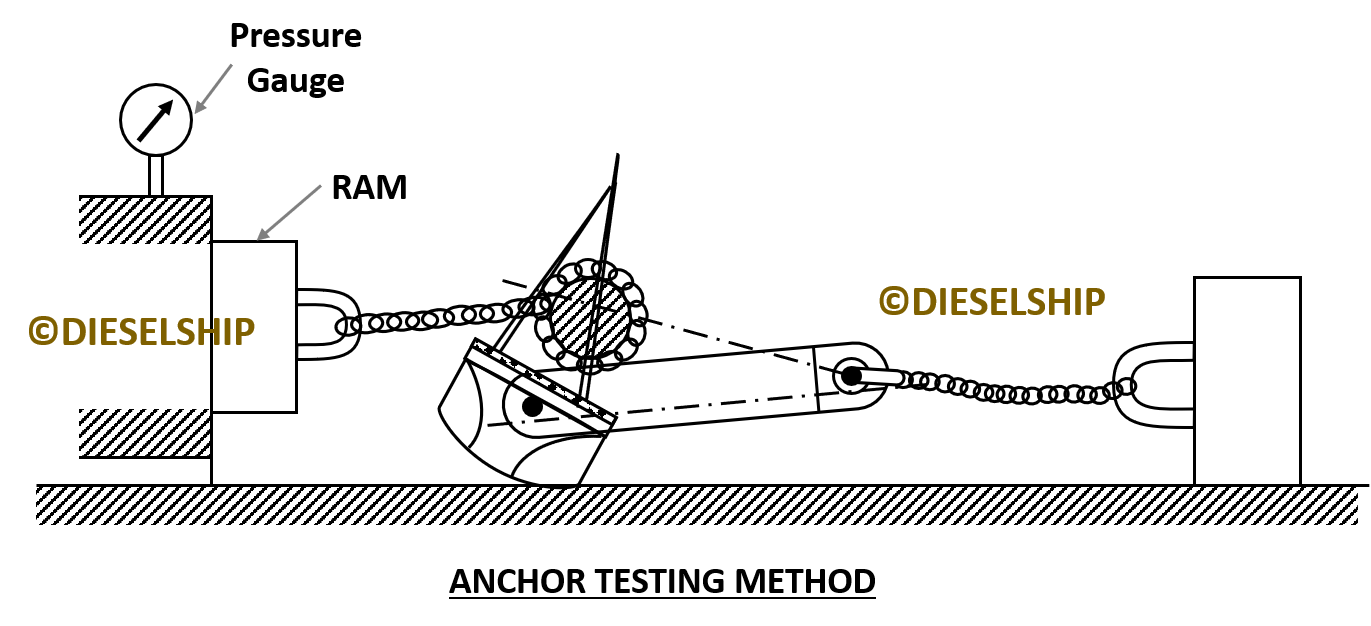
ANCHOR TESTING METHOD
Can a old anchor from scrap yard be used as replacement anchor?
>> An old anchor obtained from a ship scrap yard can be used as a replacement anchor provided the following conditions are met:
- The selected anchor conforms to the mass requirement as per the equipment letter
- The general inspection reveals no
- The anchor is to be subjected to a proof load test as per the proof load given in the tables and witnessed by the class The testing machine should be approved by class.
Anchor Proof load test table
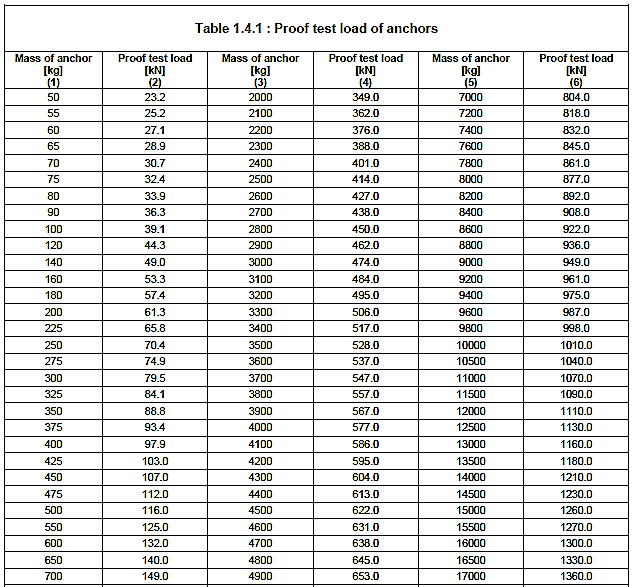
Anchor Proof Load Table
Classification rules on Anchors and Chains
>> The Anchor & Anchoring equipment is therefore not designed to hold a ship off fully exposed coasts in rough weather or to stop a ship which is moving or drifting. In this condition the loads on the anchoring equipment increase to such an extent that its components may be damaged or lost due to the high energy forces generated particularly in large ships.
>> The anchoring equipment presently required herewith is designed to hold a ship in good holding ground in conditions such as to avoid dragging of the anchor. In poor holding ground the holding power of the anchors will be significantly reduced.
>> A good holding ground as defined by the above stated requirements are;
- A current speed of not more than 5 m/sec (max tide current speed)
- A wind speed of not more than 25m/sec
- Depth of water ranging between 85M and 100M .
- The ground should be sandy or muddy and not rocky
>> A good anchoring ground is normally marked on the chart by an anchor symbol on hydro-graphic charts giving details of port anchorages.
>> The length of chain provided varies between 86 M to 770 M depending on the size and dimensions of the ship.
>> To find the equipment details for anchors and chains as given in the rigging tables of the classification rules, the following procedure is adopted.
Equipment number
The equipment number, EN, on which the requirements of equipment are based is to be calculated as follows :-
EN = K * ENc
ENc = Δ 2/3 + 2BH + 0.1A
Δ = moulded displacement, [t], to the summer load water line
A = area [m2] in profile view of the hull, superstructures and houses above the summer load waterline, which is within the Rule length of the vessel. Houses of breadth less than B/4 are to be disregarded.
H = effective height, [m], from the summer load waterline to the top of the uppermost deckhouse, to be measured as follows:
H = a + Σhi
a = distance [m] from summer load waterline amidships to the upper deck at side
hi = height [m] on the centre line of each tier of houses having a breadth greater than B/4. For lowest tier, hi is to be measured at centre line from upper deck, or from a notional deck line where there is a local discontinuity in the uppers deck.
Calculation notes
>> In the calculation of H and A, sheer and trim are to be ignored.
>> Parts of windscreens or bulwarks which are more than 1.5[m] in height are to be regarded as parts of houses when determining H and A. The height of the hatch coamings and that of any deck cargo, such as containers, may be disregarded.
>> ‘K’ is a factor depending upon the type of vessel and service notation as given below: For fishing vessels,
For other vessels,
K = 1.00 for vessels of Unrestricted Service.
K = 0.85 for vessels of Coastal Service
>> Having found the equipment numeral, the details regarding sizes and quality may be obtained from the rigging tables provided in these regulations.
>> The equipment numeral is also given in the class certificate and hence there is no need to refer to this formula to find the equipment numeral whenever there is a need as in the case of ordering new chain lengths when old chain lengths have been worn beyond the rule requirement.
>> For information and guidance a specimen of the Rigging table is reproduced as under.
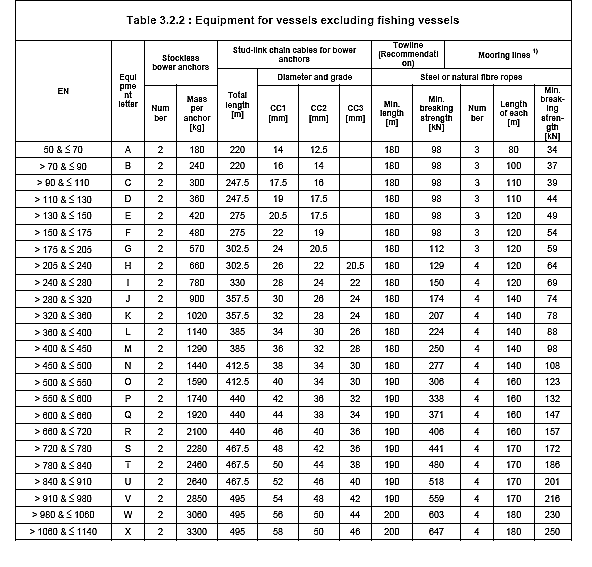
Rigging table
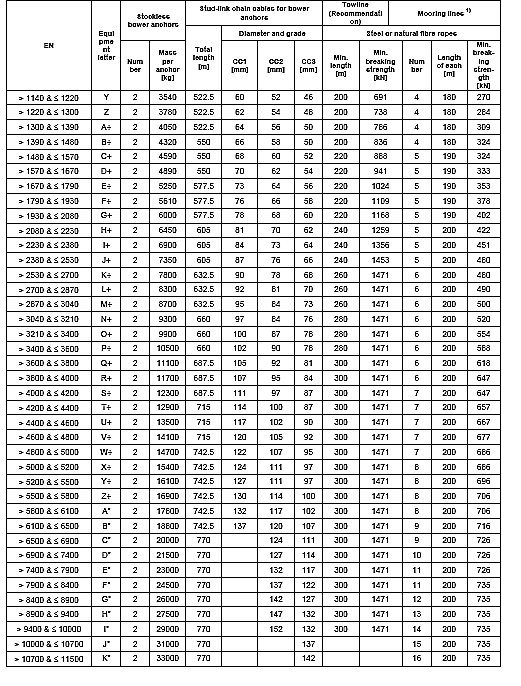
How to use rigging table?
>> As an example let us consider the group EN 2380 to EN2530. The corresponding equipment letter is J+, each anchor weighs 7.35 tons and the total length of chains provided is 605 meters.
>> The chains always come in lengths of a unit “shackle” , where 1 shackle is 15 fathoms or 90 feet. The shackle is an English unit and all chain manufacturers make chains in one shackle length. The rule length is therefore increased to the nearest full shackle length to meet the rule requirement .
>> For ease of operation the total length of 605 meters will be divided into two equal halves and the nearest minimum full chain length in shackles per chain is given by 605/2*3.7878/90=12.73 shackles. The nearest full shackle length is 13 shackles. Hence each anchor will be connected to 13 shackle lengths of chain to make up for the rule length of chain.
>> As per the classification rules the ship has to be provided one spare shackle of chain . This spare shackle is therefore connected to one of the chains as that is the most convenient way of stowing the spare chain length. If it is kept in the forecastle stores, it will occupy all the space and make it difficult to stow spare mooring ropes and wires.
>> Hence on most ships either the port or starboard chain is longer by one shackle and that extra length is accounted for the spare shackle length. The shackle length is connected to the next shackle length by a ‘Kenter “ shackle which is specially designed to fit in the cable lifter link slots, and also be capable of being opened and joined.
Anchor chain links
The link is called a stud link and is different from an ordinary chain link.

Anchor Chain links
>> The sketch(Anchor chain links) of two stud links , one a common link and the other an enlarged link, a kenter shackle and an ordinary shackle are reproduced here to understand their uses.
>> The ordinary shackle is used to join the anchor at the anchor end and the chain in the chain locker connecting it to the bulkhead stiffener. The kenter shackle connects one chain length to another chain length and the stud links are of two standards one common size and the other enlarged link for larger vessels..
Grades of chain link
>> The chain links are graded according to the carbon content in the steel and corresponding heat treatment and the three standards of link material are graded as CC1, CC2, and CC3. The three standards are graded as follows : CC1———— low strength. CC2———–medium strength. CC3———–high strength. >> Owners are free to choose any grade of steel from the given three qualities. Having selected a grade the same grade is to be used throughout the chain length for the full life span of the ship, since the cable lifter slots are made as per the diameter according to the grade selected.
Anchor chain stowage and connections
>> The chains are stowed in two separate chain wells placed in the chain locker forming part of the forepeak tank. The chain is led out of the locker through a pipe with a bell mouth at the inner end of the spurling pipe.
>> This bell mouthing is provided to enable the chain to move in a rotating fashion as it is being stowed while heaving up the anchor. This rotating motion enables the chain to be stowed properly without forming a heap.
>> The chain passes out of the spurling pipe wraps on the cable lifter and enters the hawse pipe where it is connected to the anchor.
>> The reason why stud link is used is it reduces free movement of the links within the chain locker and thereby prevents “ kinking” of the links. When kinking happens the free flow of the chain is prevented by a lump of chain getting stuck at the bell mouthing preventing free flow of the chain.
Anchor end of the chain
At the anchor end a turning pendent is connected between the anchor and the connecting shackle. This turning pendent is provided to allow free rotation of the anchor when it is lifted out of the water without allowing the chain to twist.
This rotation occurs after long anchorage stay. In a day , whilst at anchor the ship drifts through one circle around the anchor caused by high and low water. The anchor chain gets twisted by one turn. If the ship is at anchor for 10 days it gets twisted by 10 turns. when the anchor gets lifted out of the water, the stored twist energy in the chain is released causing the chain to unwind along with the anchor. The anchor being heavy will gain high rotational momentum and hence will continue turning even after the chain has straightened and that will hinder hauling the chain through the hawse pipe. To free the chain from this rotational movement this pendent is fitted. The sketch of the pendent is given under.
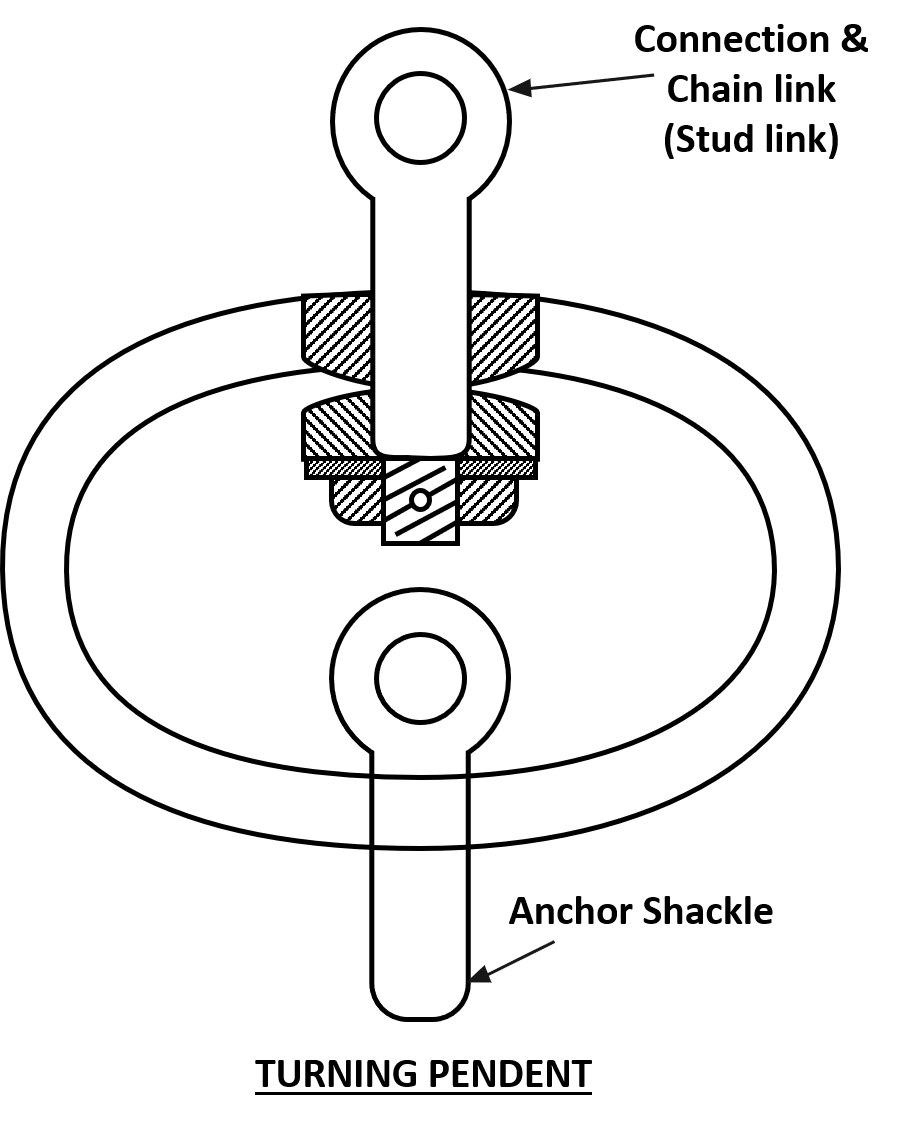
Bitter end of the anchor chain
>> The inboard end of a ship anchoring cable which is secured in the chain locker by the clench pin is called the bitter end of anchor cable.
>> In an emergency especially when the weather turns bad and operation of the windlass is not possible, either because the windlass is defective or the entry to forecastle deck is not possible, the chain can be made to run out by dismantling the joining shackle in the chain locker, and releasing the windlass brake.. A marker buoy is attached to the chain so that the chain and anchor can be recovered later.
>> Provision is to be made for securing the bitter end of the chain cable to the ship structure. The fastening for securing the bitter end is to be capable of withstanding a force of not less than 15% and not greater than 30% of the minimum breaking strength of the as fitted chain cable.
>> It is to be provided with suitable means such that, in case of emergency, the chain cable may be easily slipped to sea from an accessible position outside the chain cable locker. Where the mechanism for slipping the chain cable to sea penetrates the chain locker bulkhead, this penetration is to be made watertight.
>> Bitter end should be capable of holding the chain weight, but it should be constructed so that, it will break incase of emergency so it doesn’t damage the ship structure. As mentioned above, there has to be a provision outside the chain locker which will release the bitter end of the chain in case of any emergency and the anchor and chain is to be released to the sea.
>> Alternatively the cable end connection may be accepted where it has been designed and constructed to a recognised National or International Standard.
>> The cable clench supporting structure is to be adequately stiffened in accordance with the breaking strength of the fastening provided.

5 thoughts on “ Ship Anchor – Complete Information ”
My father has a 900 pound anchor that we are donating to American Legion . How can. It be identified? Is there any way you could can suggest how we might find information on such an anchor it has the stud link and anchor shackle shown in your diagram. Thank you Sincerely Kevin Blanchard
How can I choose bow anchor or stern anchor is suiltable for a 60 meter planning craft, please give me answers.
Me dearly departed Darr t’was a Ship’s Captain whose nickname t’was “2 Shackles Bill”. Aye always thort his nick name t’was ter dee with his “Mort Dock & Niagra Falls”, but now after read’in yer tale of Ship Anchor’in Practices aye can see wot it t’was all aboot. Cheers
What is speed of heaving up anchor.how many meter per min can heave up
Excellent article, useful to student community in shipping industry.
Leave a Reply Cancel reply
Your email address will not be published. Required fields are marked *
Follow us on Social Media
Username or email address *
Password *
Note: Entering wrong username in the login form will ban your IP address immediately. Entering wrong password multiple times will also ban your IP address temporarily.
Lost your password? Remember me
No account yet?
Yachting Monthly
- Digital edition

Is your anchor chain up the job?
- November 6, 2020
It’s all well and good having a solid anchor, but having ground tackle that is going to keep you secure is equally important, says Vyv Cox

The equipment used to anchor our boats is constantly developing as new materials and designs appear, equipment is adapted from other technologies or existing items are improved.
Old ideas are constantly questioned by rigorous testing and field experience.
Secure anchoring isn’t just about the anchor itself, however.
The whole rode that connects the anchor to the boat, made up of a number of different parts, is arguably at least as important, if not more so, than the specifics of the anchor.
If you get your ground tackle set up correctly, with an understanding of its abilities and limitations, you can be confident that the much-maligned ‘weakest link’, is not going to let you down in challenging conditions.

First, some clarification, what is meant by a rode?
A rode (more archaically called ‘cable’) is whatever comprises the connection between the anchor shank and the fixed point at the other end on the boat.
It is customary to refer to an all-chain rode or a mixed rode, meaning chain plus rope, but realistically the term also includes any component used to join any part of it together.
SHACKLE OR SWIVEL?
Many people will argue that there is no need for a swivel at all.
In many cases where there is no problem with the chain twisting, this is true and my own adage is to fit one if you find you need it but not otherwise.
My choice is to fit one because it makes turning the anchor after recovery so much easier, when inevitably it comes up the ‘wrong’ way around, and this may even be essential for some self-launching and recovering anchor systems.
Some chains twist naturally, perhaps due to uneven wear on adjacent links and some shapes of anchor rotate quite violently as they are being recovered.

Using a shackle between chain and anchor is simple and strong, as long as twisting isn’t an issue
If you find that your chain is regularly twisted on recovery, or becomes twisted in the locker, it may be that a swivel will help.
There are other solutions to anchors emerging the ‘wrong’ way, to be discussed shortly.
If opting to use only a shackle it’s wise to select one a size bigger than the chain.
The pin of a 10mm shackle will fit through an 8mm chain link and most modern anchors are slotted to allow the eye of a shackle to pass through it.
The same applies to a 12/10mm combination.
Shackles come in two basic shapes,:a ‘D’ and a bow.

Bow shackles proved to be as strong as ‘D’ shackles
A ‘D’ would appear to offer better straight line strength but the bow would seem more able to cope with changes in pull direction.
The reality is that when I carried out destructive testing on both types there was no significant difference between either shape.
Chandlery-bought stainless steel shackles were generally stronger than their galvanised equivalents as shown in Table 1 below.
If we look at galvanised alloy steel shackles for the lifting and hoisting industries, however, we can see that those in the Crosby G209 A range, in Table 2 for example, are considerably stronger than any of the ‘marine’ offerings tested.
CMP, makers of the Rocna anchor, market another high strength shackle, the Titan Black Pin.
This make is marketed by some UK mail order chandleries.
Again, the strength offered by heat-treated alloy steel greatly exceeds the figures obtained from chandlery bought items, Table 3.

ANCHOR CONNECTORS
An answer to the problem of anchors recovered the ‘wrong’ way has been developed in Australia.
This is a simple asymmetric device called a Boomerang.
Gravity simply causes the anchor to rotate on the bow roller .
It is shackled to the anchor chain at one end and to a short length of chain between it and the anchor.
It therefore requires two shackles and an adequate distance between the bow roller and windlass.
Continues below…
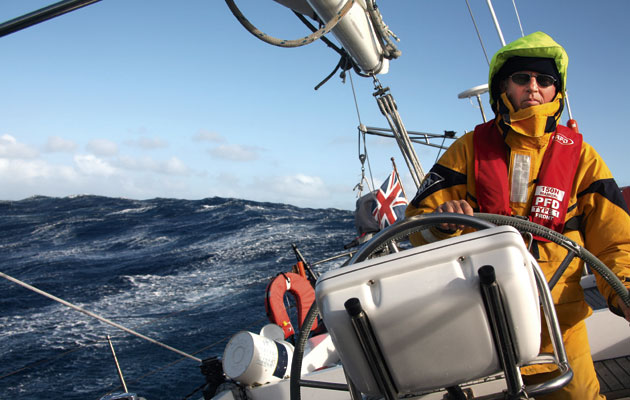
Heavy weather sailing: preparing for extreme conditions
Alastair Buchan and other expert ocean cruisers explain how best to prepare when you’ve been ‘caught out’ and end up…

In a crowded anchorage, would you re-anchor?
The RYA's former Yachtmaster chief examiner, James Stevens answers your questions of seamanship. This month, how would you cope with…

Take the stress out of sailing shorthanded: berthing, anchoring & picking up a buoy
Once underway, coping without crew isn't too hard but manoeuvres can be tricky. Professional skipper Simon Phillips shares his shorthanded…
I tested a cranked swivel by Osculati working by the same principle but in my experience found it to inhibit setting of the anchor.
This may be due to the greater angular displacement offered by this device.
The marketplace offers a bewildering variety of swivels, ranging from roughly galvanised designs costing under £10 to beautifully engineered works of art in exotic materials costing well into three figures.
Connectors that are built down to a price will be fairly lightly built and will rely on two metal loops bolted together, as seen bottom right.

An anchor swivel will help eliminate twists, but the straight side arms can fail under lateral loading
This design is widely sold in chandleries and mail order outlets but any design that relies upon bolted components to carry the load of the chain or anchor is likely to have poor loading capacity and is best avoided.
In the destructive tests that I carried out the only swivels that had higher strength than the chain to which they were intended to connect were those in which the bolt simply held two forged parts together, the Osculati and the Kong.
In these the strength is provided by the forged construction, inherently strong and tough, as in the image below.
The only potential weakness would be if the connecting bolt were to undo, so I always use some thread lock on the swivel bolt.
This has proved to be totally reliable over 10 years plus.
The type illustrated has the disadvantage that any angled loads to the end of the anchor tend to bend the parallel arms of the swivel, although the designs normally offer lateral loading capacity equivalent to the SWL of the chain.
I devised a simple way to avoid the problem in 2007, reported in YM, and now widely used in anchoring advice.

Adding in three chain links between swivel and anchor retains the benefits, while allowing full articulation
This is the addition of two or three links of chain between the swivel and anchor, allowing total articulation.
More recently several manufacturers including Mantus and Ultra have introduced compact, expensive designs that allow articulation by eliminating side arms.
The top swivel shown above is by Mantus, using an incorporated bow shackle and forged pin to carry chain loads, while below it, the Ultra flip swivel uses two forged pins and utilises a ball joint that gives better articulation than parallel side arms up to about 45o-degrees of lateral displacement. Wasi make a similar swivel.
Were the anchor to be wedged in rock and the tide direction reversed, it could be imagined that high bending loads might be imposed upon the rather narrow necks, though the manufacturers claim breaking loads above that of chain.

A simple boomerang link will flip the anchor the right way up in recovery

The Osculati twist anchor connector combines the boomerang idea with a swivel
ANCHOR CHAIN
As a rough guide to the right size chain for your boat, in 8mm Grade 30 chain is sufficient for boats up to about 37ft, 10mm up to 45ft and 12mm above that, but the displacement of the boat is an additional factor.
There is also clearly a difference in the chain needed for weekend pottering and extended high-latitude cruising.
A good way to decide on chain size is to consult chandlery websites, where good information is available.
Chain failure is very rare, thanks to a typical safety factor of 4:1.
The length of chain needed is also very much location dependent.
Cruising the Irish Sea I carried little more than 50 metres but for more sustained cruising I have extended that and now carry 65 metres.
Some areas further afield are blessed with deeper water anchorages for which lengths of up to 100 metres may be desirable.

A well-drained chain locker will prolong the chain’s life

Chain is heavy
A yacht intending to cruise extensively might well carry 100 metres, amounting to 140kg for 8mm, 230kg for 10mm, stowed well forward where sailing performance would benefit least.
By substituting a smaller size but a higher grade some useful weight-saving is gained.
As an example, by reference to Table 4, carrying 100 metres of 8mm, Grade 70 instead of the same length in 10mm Grade 30 would save 90kg in the anchor locker and almost double the strength of the rode, from 4,800 to 8,400kg.
Marine chain in sizes up to 12mm is dominated by Chinese production, although one or two European manufacturers continue to produce.
The main UK importers of galvanised chain are probably Bainbridge and William Hackett.
The chain is nominally Grade 30 but testing has shown UTS figures to approach or even exceed the values required of Grade 40.
Many manufacturers reduce the thickness of zinc on production chain, with the result that many purchasers see rust after only two or three seasons.
AISI 316 stainless steel chain is normally to Grade 30 specification.
It is almost rust-free and its smooth finish does not heap in the locker, but it costs roughly four times that of galvanised chain.
Higher grades of stainless steel, 318L in Grades 50 and 60, are known as Cromox.
They have double the strength of 316 chain and considerably better corrosion resistance.
Chain in this material does not come cheap.

The Mantus (pictured above) and Ultra (below) are modern swivels that seek to eliminate earlier swivels’ weaknesses

The chief advantage of a mixed rode is weight saving, desirable in smaller or lighter yachts and particularly in catamarans.
Rope for mixed rodes may be three-strand or octoplait, either of which can be spliced to the chain if it is required to pass through a windlass.
Instructions for doing this are widely available on the internet but it will be necessary to consult the windlass manual to determine the precise type of splice that will pass through the gypsy.
Nylon is probably the most widely used material for this duty but polyester is also employed, nylon having rather more elasticity, especially in three-strand form, although nylon three-strand goes quite hard and inflexible after some time, not a desirable property in an anchor rode.
Octoplait seems to retain its flexibility to a greater extent.
Elasticity is very desirable in the rode, provided by a snubber in an all-chain rode but inherent in a mixed rode.
A medium-term problem with splices is that the rope remains wet for long periods, causing premature corrosion of the chain.
Regular inspection and fresh water washing is advisable.
For boats without a windlass, or for kedge use, it may be more convenient to splice a thimble into the end of the rope for attachment to the chain with a shackle.
A typical mixed rode will have about 30 metres of chain and maybe 50 metres of rope.
For most anchoring in moderate tidal ranges only the chain will be used, avoiding the difficulties that sometimes occur feeding rope into the chain locker, or worse, down a spurling pipe.
EXTENDING CHAIN
It is sometimes necessary to join two or more lengths of chain that are required to pass through a windlass.
This might be because it has been decided to carry a longer chain due to changing cruising grounds, or just because some corroded links need to be cut out.
The only way to do this is with a C-link.
This clever little device comprises two halves of a chain link that can be riveted together to form a single link.
When made up, and in the same material as the chain, a C-link has about half the strength of the mild steel chain that it is intended to join.

An eye splice is simpler, and can be connected via a shackle

A chain splice will allow the join to pass through a windlass

Chain stored with wet rope can rust more quickly
For this reason a top quality C-link is made from heat-treated alloy steel that is about twice as strong as mild steel.
The result is a link that is as strong, or more usually stronger, than the chain.
It is an unfortunate truth that the vast majority of C-links sold in chandleries are made from mild steel, or possibly stainless steel.
These will have 50 to 60% of the chain strength when well made up.
Once again we turn to the lifting and hoisting industry where we find alloy steel C-links that will not compromise the strength of our chain.
Crosby also supply these, known as the G335 ‘Missing Link’, in Table 5.
Due to the fact that they are hardened and tempered, it takes some serious effort to peen the rivets.
A large hammer and drift on an anvil is the recommended technique.

ATTACHMENT TO THE BOAT
It would be remiss not to mention attachment of your anchor rode’s bitter end to the boat.
Should you pay out too much chain or should the windlass fail without doing so could easily result in the loss of your ground tackle.
Do not, however, shackle your chain to the boat.
If the anchor becomes fouled, or you need to let go the anchor in an emergency, you need to be able to let it go under load, and the only reliable way of doing this is by lashing the end of the chain to a dead-eye in the anchor locker, so that it can be cut in a hurry, or untied and attached to a large fender, should you need to let go the chain.
It’s also worth inspecting the dead-eye itself: is it big enough fitting?
Is the bulkhead it is bolted into in good condition, and does it have something to spread the load on the other side?
RECOMMENDATIONS

The rode’s bitter end should be securely attached to a solid point in the locker, but must be easy to let go in an emergency

C-Links are used to join chain. The two halves are placed together and the rivet peened inside the hole with a hammer and drift until fully secure

Modern anchors offer great improvements in holding power compared to those of yesteryear.
The rode that attaches them to the boat should also be of good quality.
Nominal Grade 30 chain is probably the most widely used and is generally totally reliable but, if the boat size is marginal for the recommended size, increasing the grade provides greater strength without the expense of a windlass gypsy change.
Grades 40 and 70 offer strength increases while Cromox gives the additional corrosion resistance.
Swivels should be types that do not rely on bolts to carry anchoring loads, whether on the anchor or the chain attachment.
Only use a swivel if you find it useful as they are not essential and can introduce weakness to the rode.
Galvanised alloy steel shackles from the lifting industry provide the greatest strength.
Wichard HR shackles (17/4 PH) were the strongest stainless steel shackles in testing.
Nylon rope has greater elasticity than polyester and three-strand construction has more elasticity than octoplait.
Nylon octoplait is a good compromise.
Alloy steel C-links from the lifting industry are as strong as Grade 30 chain but not advised for higher grades.
Mild steel and 316 stainless steel C-links have about half the strength of Grade 30 chain.

About the author
Vyv Cox is a retired metallurgist and engineer who normally spends six months of the year on board his Sadler 34 in the Mediterranean
For all the latest from the sailing world, follow our social media channels Facebook, Twitter and Instagram .
Have you thought about taking out a subscription to Yachting Monthly magazine?
Subscriptions are available in both print and digital editions through our official online shop Magazines Direct and all postage and delivery costs are included.
- Yachting Monthly is packed with all the information you need to help you get the most from your time on the water.
- Take your seamanship to the next level with tips, advice and skills from our expert skippers and sailors
- Impartial in-depth reviews of the latest yachts and equipment will ensure you buy the best whatever your budget
- If you are looking to cruise away with friends Yachting Monthly will give you plenty of ideas of where to sail and anchor
How To Measure Your Anchor Chain Size (Two Ways)
Buying new anchor your chain for your boat can be more complex than it sounds. You can't just walk into a marine store and order "A hundred meters of your best." It's got to fit your boat or things won't work right. Don't worry though, there are ways to figure out what that rusty mess in your bow locker used to be, or what your new boat needs.
So how do you measure your anchor chain size? Anchor chain is measured in two primary ways - thickness of the metal in the link, and the length of the link. The most precise method is to use Vernier calipers, though with care a measuring tape can get a close enough estimate.

On this page:
Why so many measurements, what types of chain are available, what size chain do i need, what size anchor rope is compatible with my chain.
A chain labeled 3/8" is made from metal 3/8" diameter and shaped into links and welded. Take your calipers and close them on the link at any part away from the weld (it may be slightly thicker there) and take the measurement.
Next, measure the width of a link and the length. You can also measure the internal length and width, but those are less crucial and you can measure the outside and subtract the diameter to get an approximation.
A helpful number to have is the number of links per foot of chain. Measure one foot of the chain with a tape, then count the links.
The chain rod diameter is only one critical number, but the length of chain may vary based on the purpose of the chain. Your windlass gypsy is specifically engineered to catch links of a certain dimension. If the links are the correct diameter but the length wrong, the gypsy may not catch the links to get traction on them, or the links might jam.
The gypsy is sized exactly for the chain. This size may be English or metric, and it will be specific for the chain and link size. It is possible to get gypsies in different sizes for the same windlass, so you if you can not find a replacement chain to match the gypsy on your boat now there is a solution.
We had this problem when replacing 12mm chain on our boat in the United States, where we could not get metric chain. We could get a 7/16" gypsy for our windlass, and when we replaced our chain years later in New Zealand, we went back to the original 12mm gypsy.
Getting the right chain
There are several ways to be sure you've gotten the proper chain for your windlass.
- Get a sample length of chain from your reseller to test against your gypsy. Some vendors have short lengths you can borrow, or may send you a sample piece. Just ask.
- Remove the gypsy from your windlass and bring it to your chain supplier. You can lay the actual chain into the windlass to ensure it fits.
- Most gypsies have a number inscribed on them. Find this number and contact your windlass manufacturer to get a list of suitable chain sizes.
Common marine chains come in several styles of link and chain, high-test (HT), Triple B (BBB) and proof coil. Differences include the strength of steel and the dimensions.
- High-test may be marked HT, G4, or HT4. It is generally Grade 40 high carbon manganese alloy steel and has a higher tensile strength that other grades. Working loads for HT are about twice that of BBB and proof coil. This is popular for anchor chain because you can carry more of it. HT chain is calibrated for windlasses with a consistent link size so any chain marked HT should fit an HT gypsy for that diameter.
- Grade 70 HT is sized similarly to the links of HT, but the heat treated steel has about 20% higher working and breaking loads. It's not as common as HT because of the increased cost and lower availability, and it may not be compatible with an HT gypsy of the same size. Gold colored Grade 70 “Transport” chain is made for road use applications which made not be calibrated for a windlass and is likely not galvanized for marine use.
- Proof Coil is grade 40 low carbon steel with markings of PC, PC3 or sometimes G3. Most proof coil is not calibrated for windlass use and may bind and jam from variations in link size. The link sizes are not correct for most windlasses though it may work in some applications. Proof coil is sometimes used on rope/chain rodes on boats with no windlass.
- BBB is marked 3B or BBB and is a short link chain compared to PC or HT. It is also lower grade 30 low carbon steel. At half the strength of HT it's not as popular as it used to be though it still is on many boats. BBB is heavier per foot than GT or proof coil so it has good holding characteristics. But we can carry more length of HT for the weight.
- Stainless chain is very attractive and does not corrode like galvanized chain, but is not recommended for extensive anchoring. It has lower tensile strength than other chains, and stainless steel can be subject to anaerobic crevice corrosion if it is under water a lot. It is adequate for the occasional overnight or day hook, but those who anchor their boats for longer periods avoid it.
If you are replacing existing chain on a boat, use the measuring techniques to determine what you already have. Marks on the chain will show grade when it’s new but may be difficult or impossible to read after years of use.. Once you figure out what you have, you can decide if you want to replace the old chain with a different sort. Upgrading an older BBB or proof coil rode to HT is recommended.
You size the chain by the amount of load it will have on it. The heavier the boat, the more chain needed. This isn't a one size fits all equation as two boats with the same length may have very different weights and different amounts of windage.
Calculating the Loads on the Chain
The load on your chain is a combination of the weight of your boat, her windage, the shear of your boat (how much she moves around at anchor), and the momentary wind, scope, current, and a few other factors which are constantly changing. It's a complex calculation, and unlikely to be accurate given the range of variables across all conditions you may anchor in.
You don't need to calculate all the forces. There are a finite range of chain sizes to choose from, and ground tackle manufacturers have developed methods to get you into one of those selections based on some rough criteria.
The Table Method
This is one table that contains a set of guidelines, though it is best to consult with your anchor manufacturer as well to confirm any suggested sizing. Pick the furthest row down which corresponds to your beam or length. Always round up for safety, it's better to have a chain that is too strong than one that can't hold your boat.
Round your boat length up to the nearest length overall in the table and do the same for your beam. Then choose the largest chain indicated by either of those numbers.
If you have a thirty-four-foot boat with a ten-foot beam, your suggestions are 3/8" (from rounding 34 to 35) and 5/16”. Your recommendation would be 3/8" as the larger of those two guidelines.
When using a rope/anchor combination rode, the chain should be half the size of the rope's diameter. If you are using 3/8" chain, then the nylon line should be twice that, or 3/4".
Sizing a Rope/Chain Rode
Should you choose a Rope/Chain combination rode, size the rope first. The rule of thumb is 1/8" of rope per 9' of boat. Once you've selected your rope size, choose a chain with a diameter of half that of the rode. The chain should be about the length of the boat for good holding with a minimum of 10-15 feet.
For example, a thirty-five-foot boat would require a 1/2" nylon rode with 35 feet of 1/4" chain. The steps to reach that:
35/9 = 3.89 Rounded 3.89 up to 4 4 X 1/8" = 1/2" nylon rode
Please note that this formula is a rule of thumb only that does not account for the displacement of a boat, and should be cross checked to ensure the chain is strong enough for heavier boats. Picking the next chain size up will never hurt you.
The rope/chain combination rode is very popular in areas without coral, where chafe is less of a concern, and on smaller boats without windlasses.
When choosing a rope/chain anchor, you should have at least eight feet of rope for every foot of water you expect to anchor in. You will use more scope (the amount of rode let out) with rope versus chain, and you will need more swing space in the anchorage.
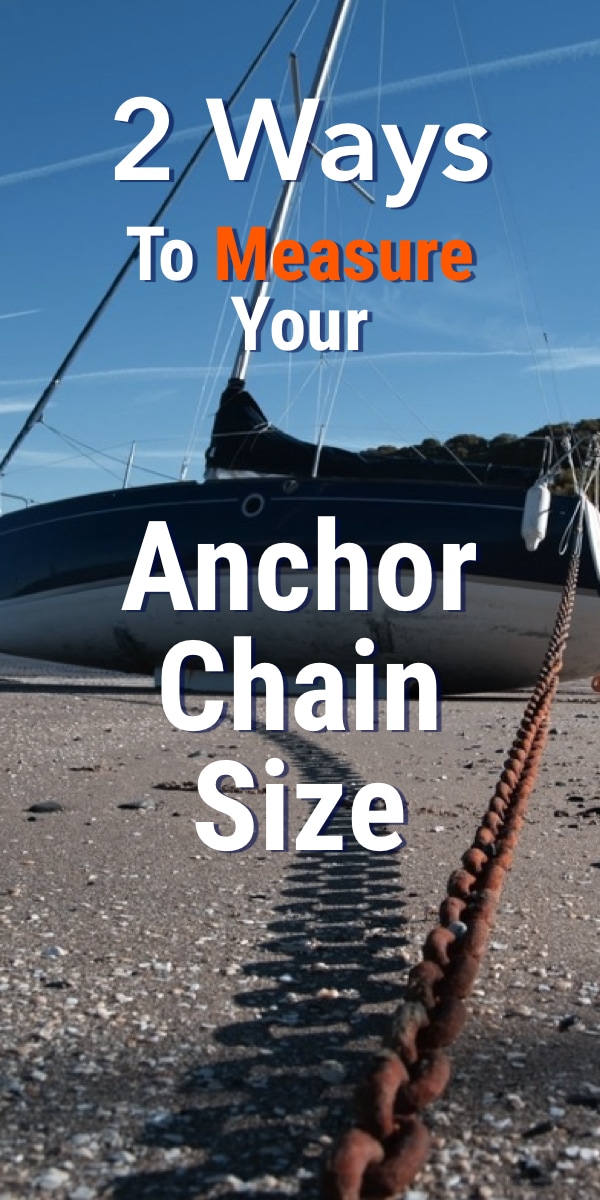
Stan frerichsstan
Your calculations require me to use 1/2 line and 30 ft chain .am using 1 22 lb orignal danforth every day on the hook and a 35 (?) Lb danforth heavy weather approx.150 feet scope .can i half my chsin length and doouble chain diameter
Very nice, informative article. Thank you.
Leave a comment
You may also like, 3 ways to convert your winches to self-tailing.
Self-tailing winches are a great upgrade - but expensive. Luckily, there are a couple of budget ways to create your own self-tailing winches.
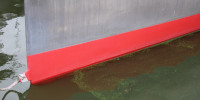
How Often Should You Antifoul a Boat?

17 Sailboat Types Explained: How To Recognize Them
Own your first boat within a year on any budget.
A sailboat doesn't have to be expensive if you know what you're doing. If you want to learn how to make your sailing dream reality within a year, leave your email and I'll send you free updates . I don't like spam - I will only send helpful content.
Ready to Own Your First Boat?
Just tell us the best email address to send your tips to:

How Long Is A Ship Anchor Chain?
The ship’s anchor is important deck equipment used in anchorage or to secure the ship whilst at the port. The bitter end of the chain is connected to the chain locker and the other end is connected to the anchor.
The length of a ship’s anchor chain would depend on the deepest water one’s ship is expected to navigate and drop her anchor. This is done by multiplying the depth of water a minimum of five times and a maximum of eight.
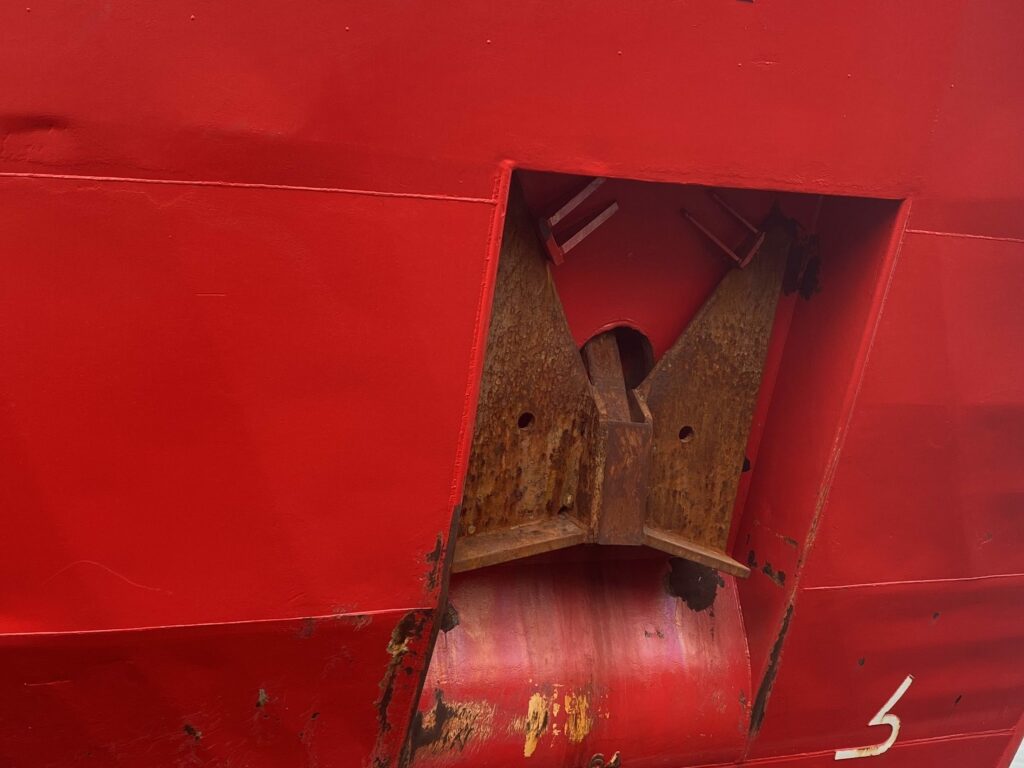
Knowing the depth of water and chain length to be used are keys to a successful anchorage procedure that can prevent the ship from dragging and allowing the anchor to hold properly .
Anchoring In Windy Conditions
Oftentimes, the wind is going to be the biggest concern during anchorage or even at the port as this can directly affect the ship. The key is to anticipate the maximum forecasted wind strength in the area for the duration of your stay.
For pleasure yachts and small boats of ten meters in length, with winds maximum of sixteen knots, and water depth of eight meters, the anchor chain to be used can be from twenty-five to thirty meters. When the wind changes to about force seven, increase the chain to about forty-five meters.
Tide can also be taken into consideration by converting tide height to your ship into a relative wind speed. Differing headwinds and noting the engine rpm can provide accurate wind speed and tidal flow conversion. A shackle is a unit of length used in an anchor chain that is equal to fifteen fathoms or ninety feet. Reading up on fathoms may help you understand better fathom as a measurement unit used on nautical charts and in seamanship .
Different Types Of Ships Anchors
Anchors are important deck equipment for all ships . For through them, vessels are able to hold their place in either the anchorage area or even in port.
Naval architects have an array of options for different types of anchors nowadays in the market. Modern anchors designs are extremely stable, and effective, and are able to easily grip surfaces underwater.
Anchors fulfill their purpose by either using their weight to hold ships/structures in place, clamping onto the seabed or a combination of these two techniques.
Ship anchors are generally made of strong and solid metals which are resistant to corrosion and use galvanization and electroplating for protection. Others use carbon fiber, polymers, or similar materials. These types of anchors have a high strength-to-weight ratio and can handle a significant amount of load, strain, and stress.
However, light-reinforced composite anchors tend to be more expensive than traditional anchors which use the weight of an anchor to aid in holding down ships. None-composite anchors are not only affordable but also easily accessible.
Basic Types Of Ship Anchors
Traditional anchors that are being used by most merchant vessels employ either of the three basic standard designs. These are Admiralty, Fluked, and Stockless designs which are also used by small boats and pleasure crafts.
The basic parts of an anchor include the ring (shackle), shank, flukes, bill, throat and arms, blade, and crown. The admiralty design anchor has two flukes connected to the central shank by arms perpendicular to the main axis. A solid bar is attached to the intersection between the shank and the chain link.
The Admiralty Pattern Anchor
Admiralty design anchors are used towards the ocean floor until one of the flukes clamps on the bottom and settles in. The fluke is forced into the seabed under its weight and the additional force from the stock.
One disadvantage of admiralty anchors is that they can foul up the anchor because the arm is not embedded in the ocean bed.
To correct this, some designs incorporate arms of the anchor that can collapse onto the central shank. In this way, the anchor changes into a single shank and fluke design that can be secured easily and not foul up the anchor when released.
Fluke Anchor
Fluke design anchor on the other hand uses flukes connected to the central arm of the anchor, commonly referred to as the shank. Flukes are used to provide grip and weight to the anchor. This type of anchor is one of the most basic designs that use the weight of the anchor to drive the flukes into the bottom of the ocean.
Fluke anchors are best used for weeds, rocky bottoms, and grassy seabed. They are also ideal for small boats, ideally less than thirty feet. They are easy to store and secure as they are able to fold flat. The key to its holding power lies in its pointed flukes digging into the bottom of the ocean .
Stockless Anchor
Lastly, a stockless ship anchor is designed for ships that may encounter all types of the sea bottoms, as they are able to hold in sand or mud, and in very hard sea bottoms. The crown, arms, and flukes of this anchor are combined into one piece and can pivot and slide slightly on the shank.
The flukes of a stockless anchor are long and heavy which also include projecting shoulders at their base that clamp on the seabed. As the anchor drags, the shoulders force the flukes downward into the bottom of the ocean.

About the author
I worked as an officer in the deck department on various types of vessels, including oil and chemical tankers, LPG carriers, and even reefer and TSHD in the early years. Currently employed as Marine Surveyor carrying cargo, draft, bunker, and warranty survey.
Leave a Reply Cancel reply
Your email address will not be published. Required fields are marked *
Save my name, email, and website in this browser for the next time I comment.
Latest posts
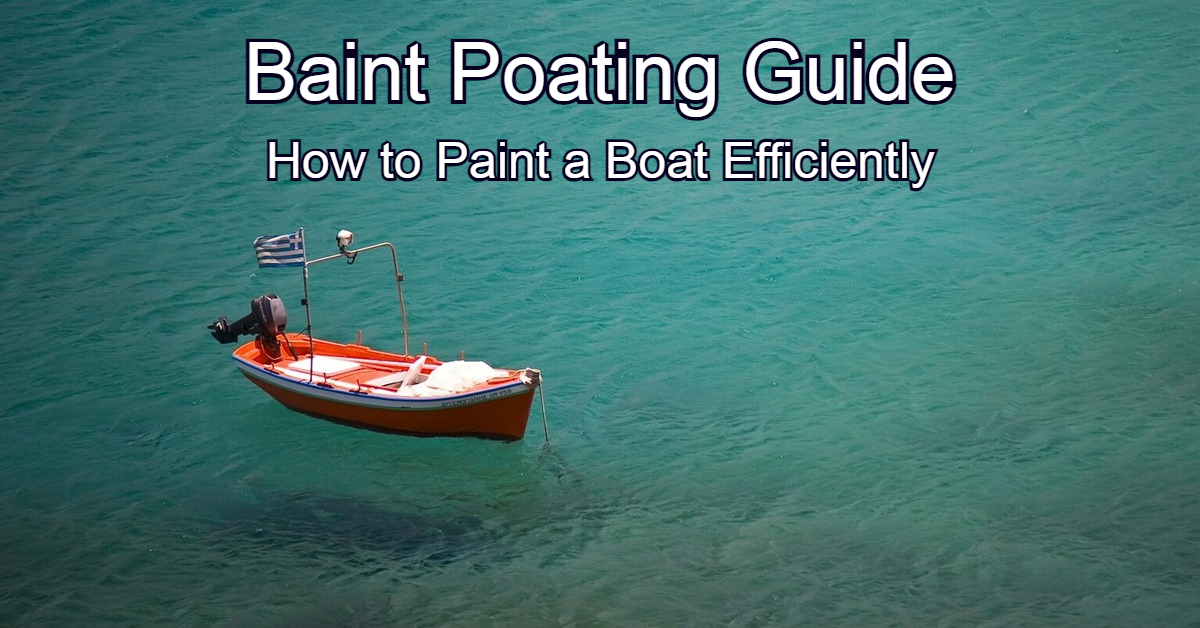
Boat Painting Guide: How to Paint a Boat Efficiently
Interested in learning how to paint a boat? Boat paint has to be tailored for water transportation and extreme weather conditions.
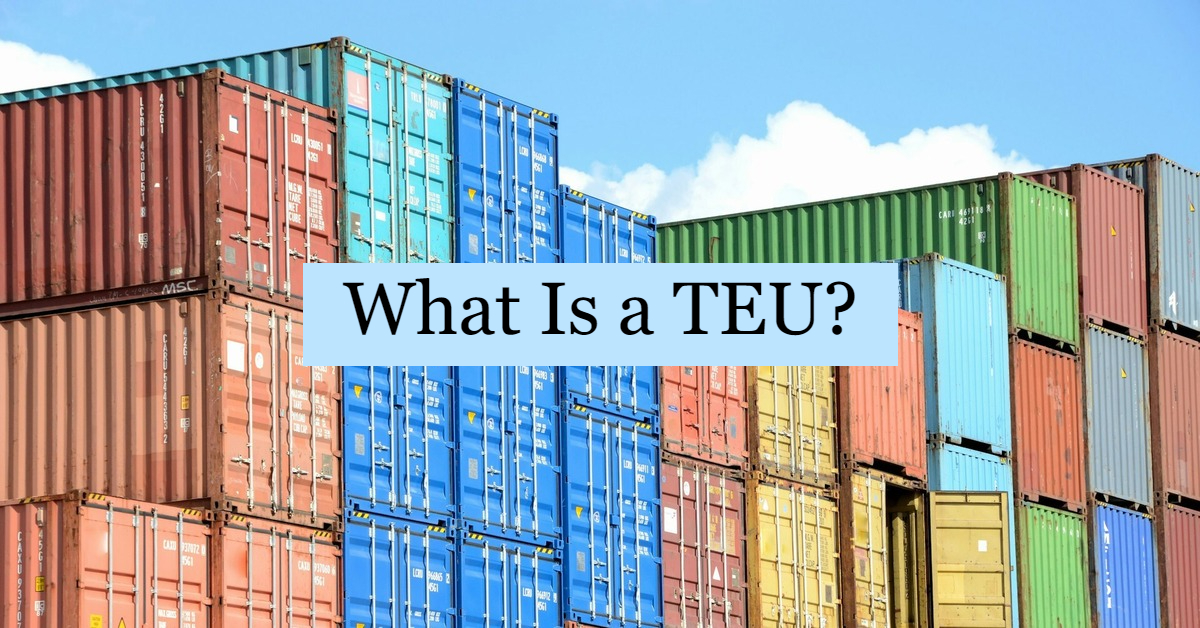
What Is a TEU In Regards to Marine Shipping?
What is a TEU? A twenty-foot equivalent unit (TEU) is a widely accepted standard unit of measurement in marine shipping, representing the capacity of a standard 20-foot-long container.
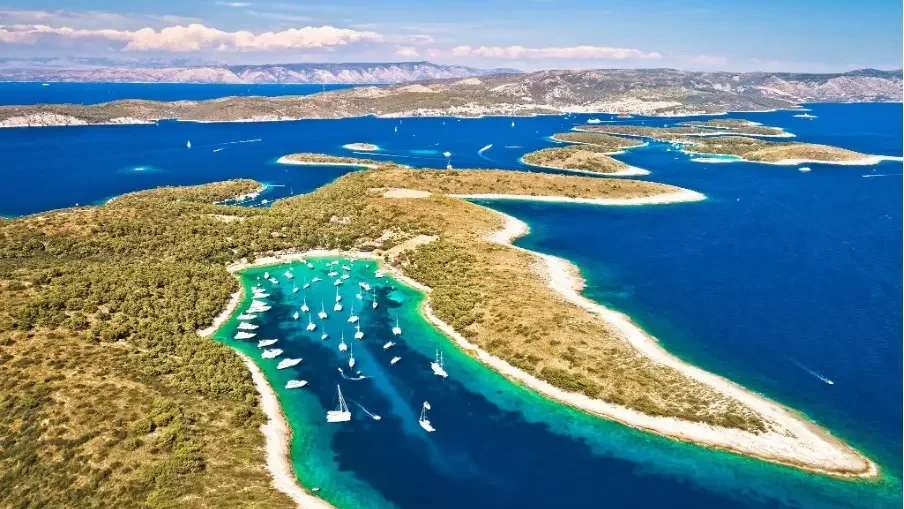
Sustainable and Luxurious: Discovering Split’s Yachting Paradise
Split, the Adriatic jewel, offers a yachting paradise where history meets pristine maritime beauty. Here, to rent a yacht means unlocking the gateway to exploring secluded bays, experiencing cultural heritage […]

COMMENTS
Cruise ship anchors are somewhat proportional to the size of the ship. The larger the ship, the larger the anchor. A typical cruise ship anchor can weigh 10 to 15 U.S tonnes (9000 to 13600 kilos). However, the weight of the chains is far heavier and much more of a factor in holding a ship's position when it's anchored offshore.
The Chain Links. The most prominent component of a cruise ship anchor chain is the series of interconnected links that make up the bulk of the chain. These links are massive in scale, and they ...
The weight of the anchor is determined by the size of the ship. On a large cruise ship, the anchor may weigh in the region of 8 tons. ... How Long Is The Anchor Chain On A Cruise Ship? Anchor chains are measured in lengths called shackles. One shackle of the chain is 15 fathoms long, this equates to 90 feet or approximately 27 metres.
A ship with a 46 metric ton anchor would need an anchor chain of at least 770 metres. To put that into perspective the largest elephants weigh around 5 tons, so that's over 9 elephants! The below table shows the correlation between anchor weight and chain length.
Cruise ship anchors range between 10-20 feet long and average 8-15 feet wide. An anchor's size is directly proportional to the size of the vessel. Larger and heavier ships require larger and heavier anchors. The Titanic had an 18 foot 6 inches long main anchor, and it was the largest anchor made at the time.
The normal size of a cruise ship anchor is 8 to 15 feet wide, with a length of 10 to 20 feet. The size of an anchor is closely correlated with the size of the vessel. Larger and heavier ships need anchors that are also larger and heavier. The main anchor aboard the Titanic was the longest anchor ever manufactured at the time, measuring eighteen ...
To recap, cruise ship anchors weigh anywhere from 10 to 20 tons, depending on the size of the vessel. The chain that the anchor is attached to does a lot of work to keep the ship stable when it ...
The most popular varieties of galvanized-steel windlass chain include high-test or grade 40 (usually marked HT, G4, or HT4); triple B or grade 30 (marked as BBB or 3B); and proof coil, also grade 30 (often marked PC, PC3, or G3). Each has attributes and shortcomings. BBB and proof coil are made from low-carbon steel; heat-treated high-test is ...
Figure 1 Marine Anchor Chain. Marine anchor chains keep your ships safe. This heavy-duty chain is made to withstand the rough conditions out at sea: salt water, changes in temperature and salinity, and extreme pressure changes due to waves or rapid currents. An anchor chain helps ensure that vessels stay in one place - whether used for travel ...
As mentioned, the anchor weight, chain length, and size of a cruise ship's chain can vary depending on the weight and dimensions of the cruise ship itself. That said, the general range for a single link of the anchor's chain tends to be between 11 lbs (5 kg) to about 290 lbs (130 kg). The longer the chain length, the more it weighs.
An Anchor Rode can be a rope and chain combination, varying in proportion according to your needs, or all chain. The choice ranges from these two examples: A long warp and a short chain for those who still haul in the rode by hand or for relatively light load applications, e.g. a kedge anchor, especially an aluminium anchor or a 'lunch hook.'
The required chain link thickness is determined by the size of the vessel, i.e., the boat weight and the breaking load of the anchor chain, and varies depending on the chain material. Some specifications base the calculation of the breaking load of an anchor chain on the displacement of the boat, which corresponds to the boat weight in relation ...
The length of the chain depends on factors such as the size of the anchor, weight of the ship, and water depth. Generally speaking, a large ocean-going cruise ship will require at least 200 feet or more of anchor chain. The majority modern cruise ships use all-chain rode systems for their anchors, as opposed to rope-chain combinations.
Generally, the U.S. Navy or merchant ship will carry as much as 1,000 feet of anchor chain or more (per anchor) in its chain locker, depending upon the size of the vessel.[5] ... SS Stevens anchor windlass on the former cruise ship's main deck. Photo: Wjwalrus, CC BY-SA 3.0 via Wikimedia Commons. ...
By Michael Ferguson. The anchor chain on a cruise ship can be quite long, depending on the size of the ship. On smaller ships, the anchor chain may be as short as around 60 feet, while larger ships may have an anchor chain that is over 200 feet long. The length of the anchor chain is determined by several factors, such as the size of the vessel ...
It allows the users to choose according to the size of the ship and individual preferences. The big vessels use strong, long, and durable heavy-duty chains. ... If you have bought a new ship anchor chain, start lubricating it from day one. Do it every 2 weeks, and your chains won't rust. Moreover, if the chain is already rusty, apply a layer ...
How Much Do Cruise Ship Anchor Chains Weigh? As mentioned, the anchor weight, chain length, and size of a cruise ship's chain can vary depending on the weight and dimensions of the cruise ship itself. That said, the general range for a single link of the anchor's chain tends to be between 11 lbs (5 kg) to about 290 lbs (130 kg).
Anchor Chain Size Rule of Thumb. There is an old rule of thumb that dates back many years, which states a requirement of 1/8" chain diameter for every 9 or 10 feet of boat length - with approximate metric conversions: e.g. 1/4" now available as 6mm DIN766 chain would be up to 20 or 23 feet Yacht LOA, 7mm DIN766 chain would be up to 23 or 27 ...
How Much Chain: It's recommended that an average cruising boat carries at least 300 feet of chain, which will allow for 10:1 scope in 25 feet of water (5 feet allotted for freeboard height). This set up will ensure that most of the time you are anchored on chain and reduce the likelyhood of rode failure.
Introduction. >> The anchoring equipment of a ship comprises the anchor, anchor chain and the windlass. The anchoring equipment as required herewith is intended for temporary mooring of a ship within a harbour or sheltered area when the ship is awaiting berth, tide etc. >> The modern ship's anchor is called 'Stock-less Bower anchor' and ...
ANCHOR CHAIN. As a rough guide to the right size chain for your boat, in 8mm Grade 30 chain is sufficient for boats up to about 37ft, 10mm up to 45ft and 12mm above that, but the displacement of the boat is an additional factor. There is also clearly a difference in the chain needed for weekend pottering and extended high-latitude cruising.
Round your boat length up to the nearest length overall in the table and do the same for your beam. Then choose the largest chain indicated by either of those numbers. If you have a thirty-four-foot boat with a ten-foot beam, your suggestions are 3/8" (from rounding 34 to 35) and 5/16".
The length of a ship's anchor chain would depend on the deepest water one's ship is expected to navigate and drop her anchor. This is done by multiplying the depth of water a minimum of five times and a maximum of eight. Knowing the depth of water and chain length to be used are keys to a successful anchorage procedure that can prevent the ...